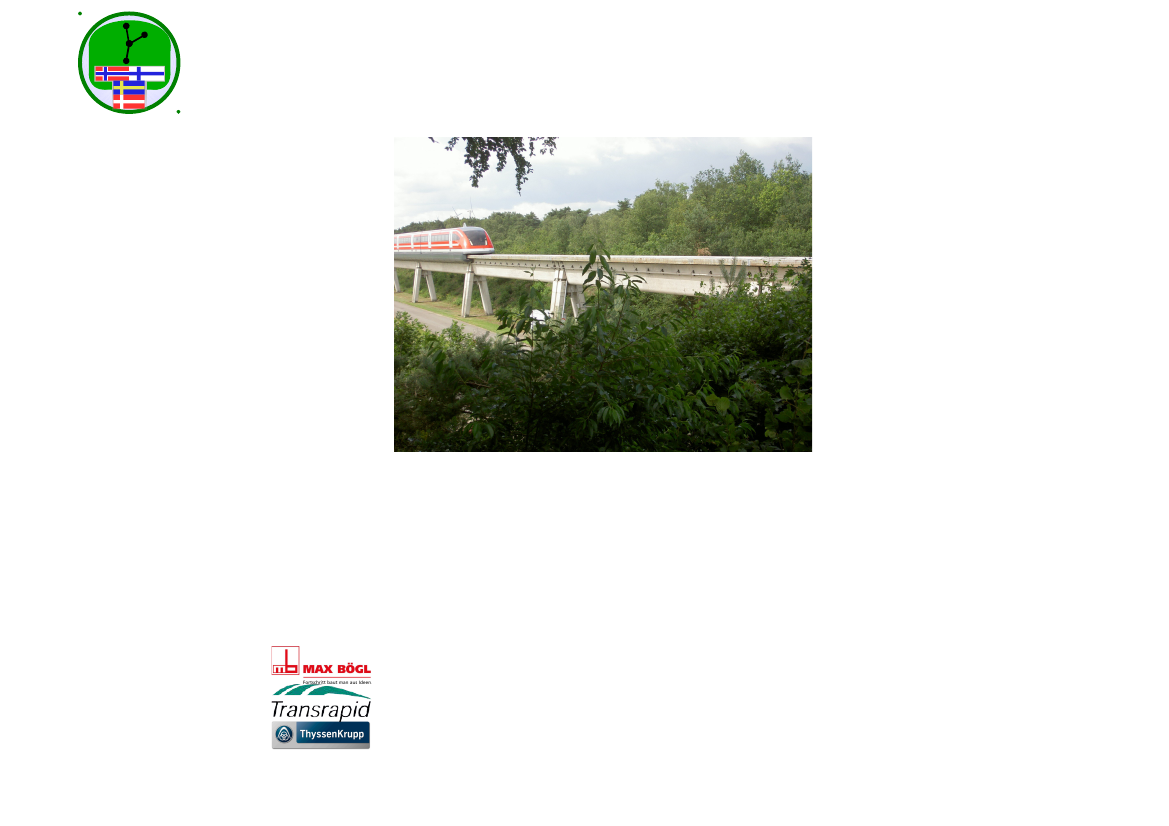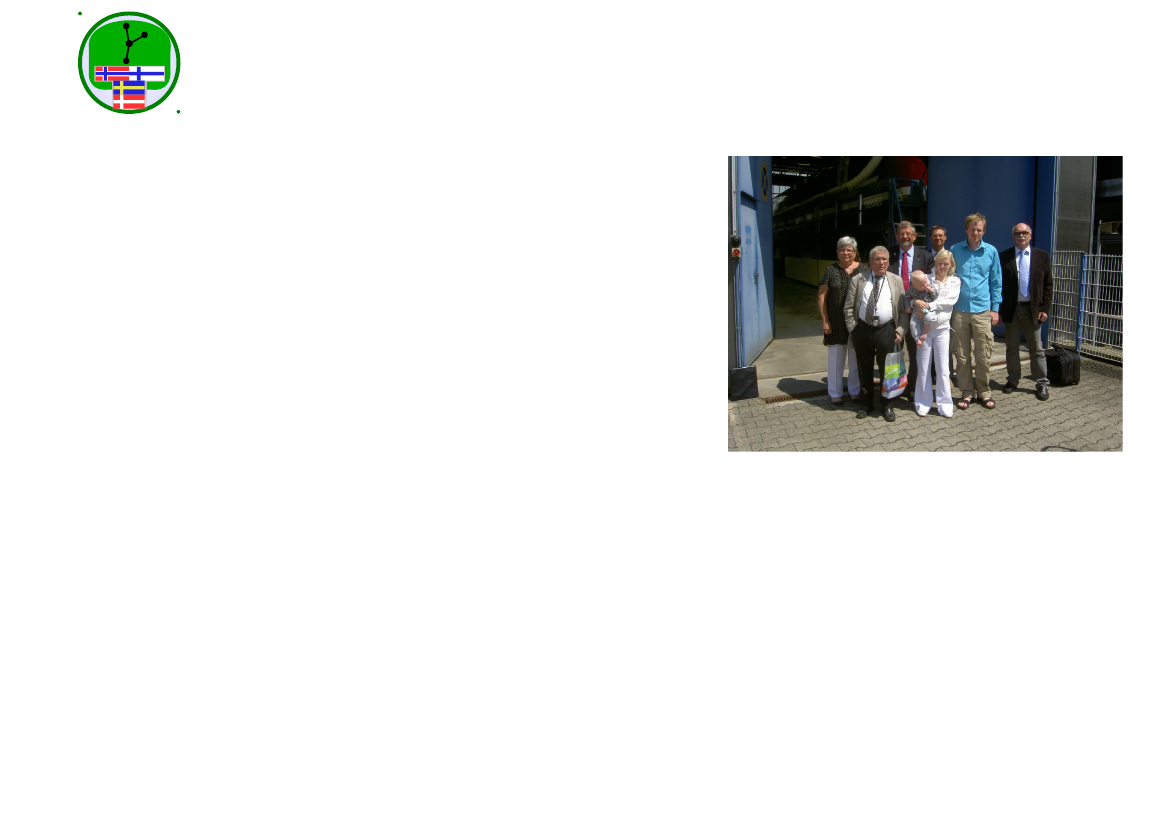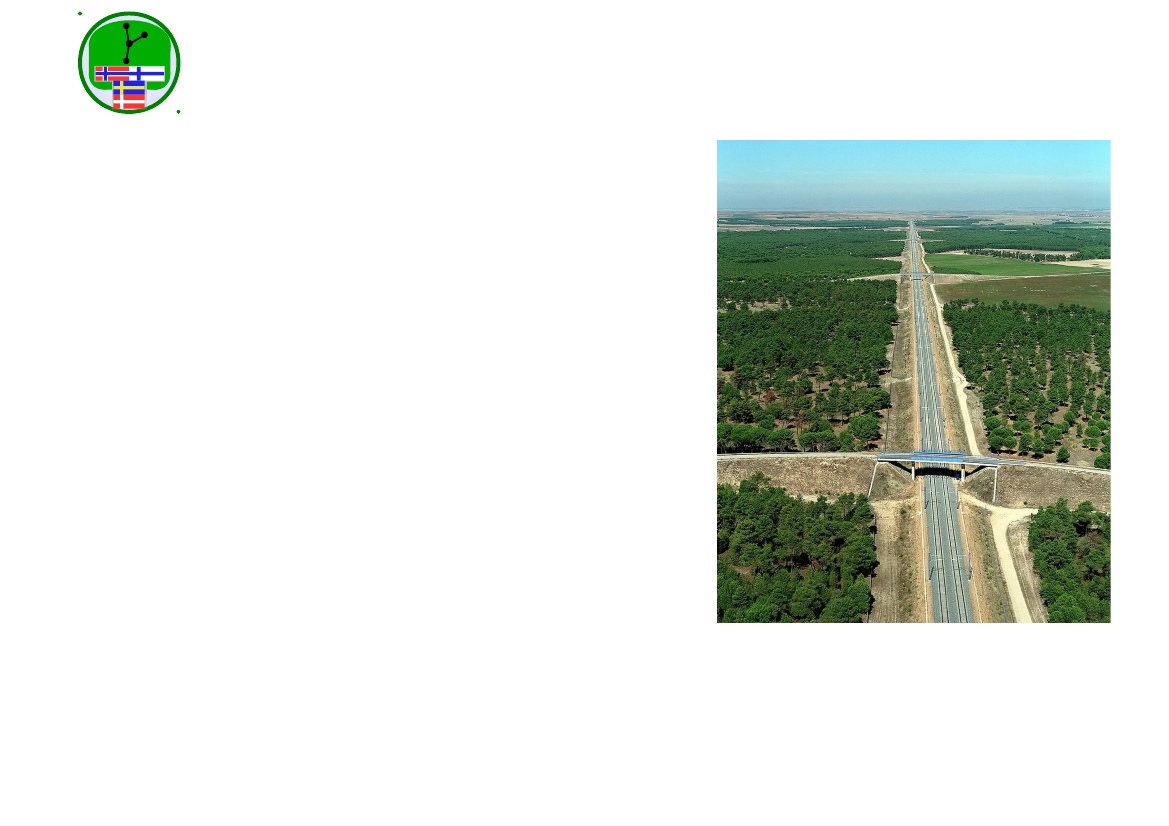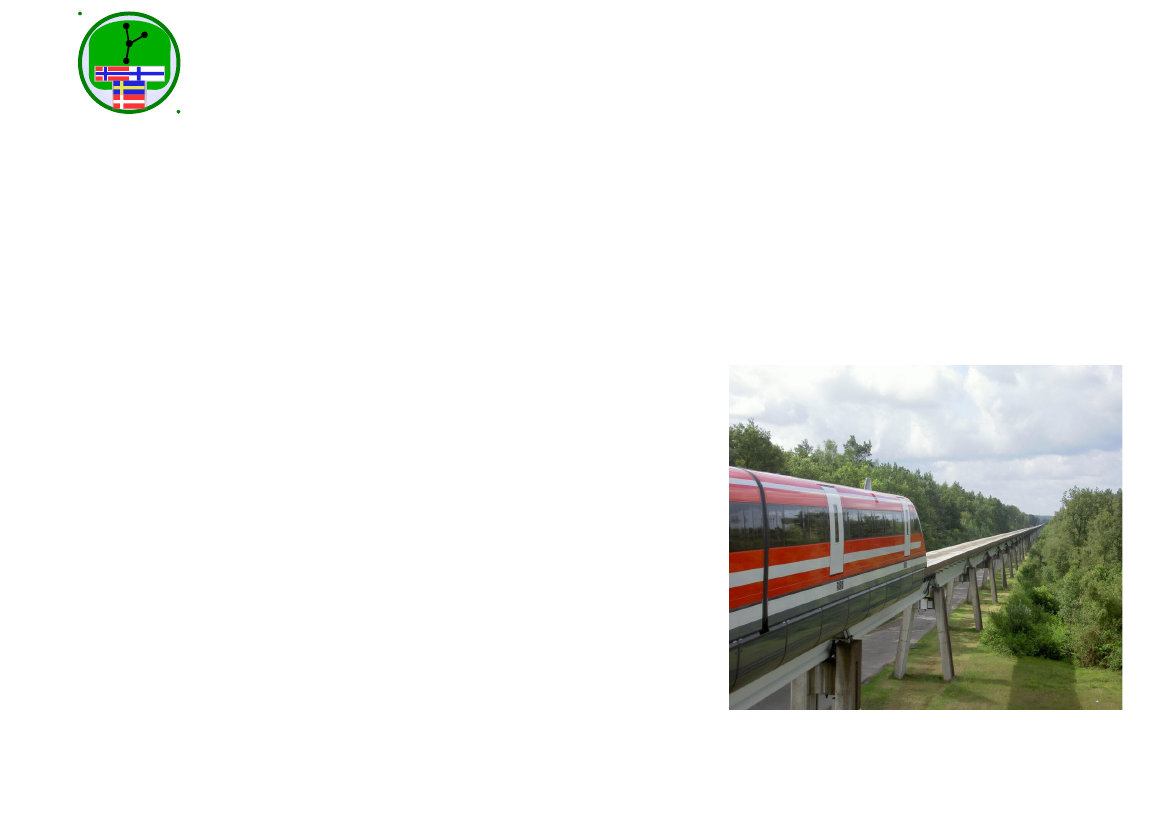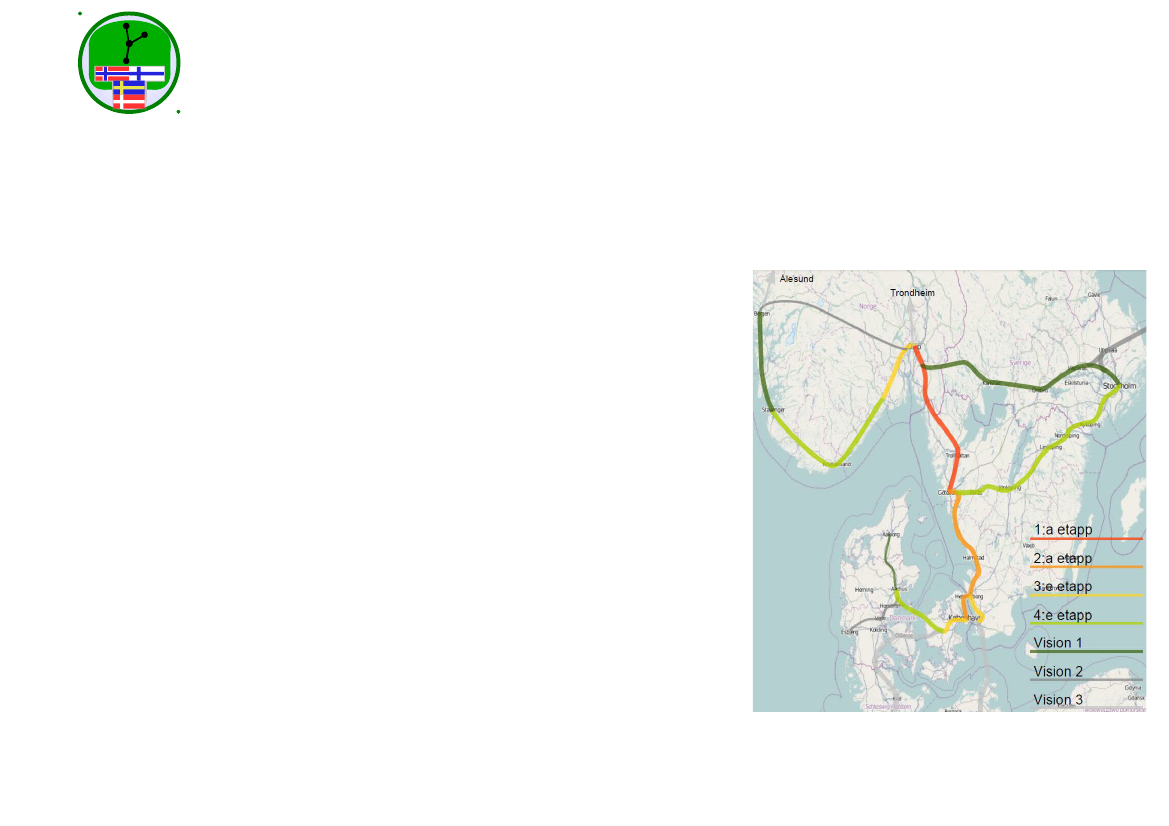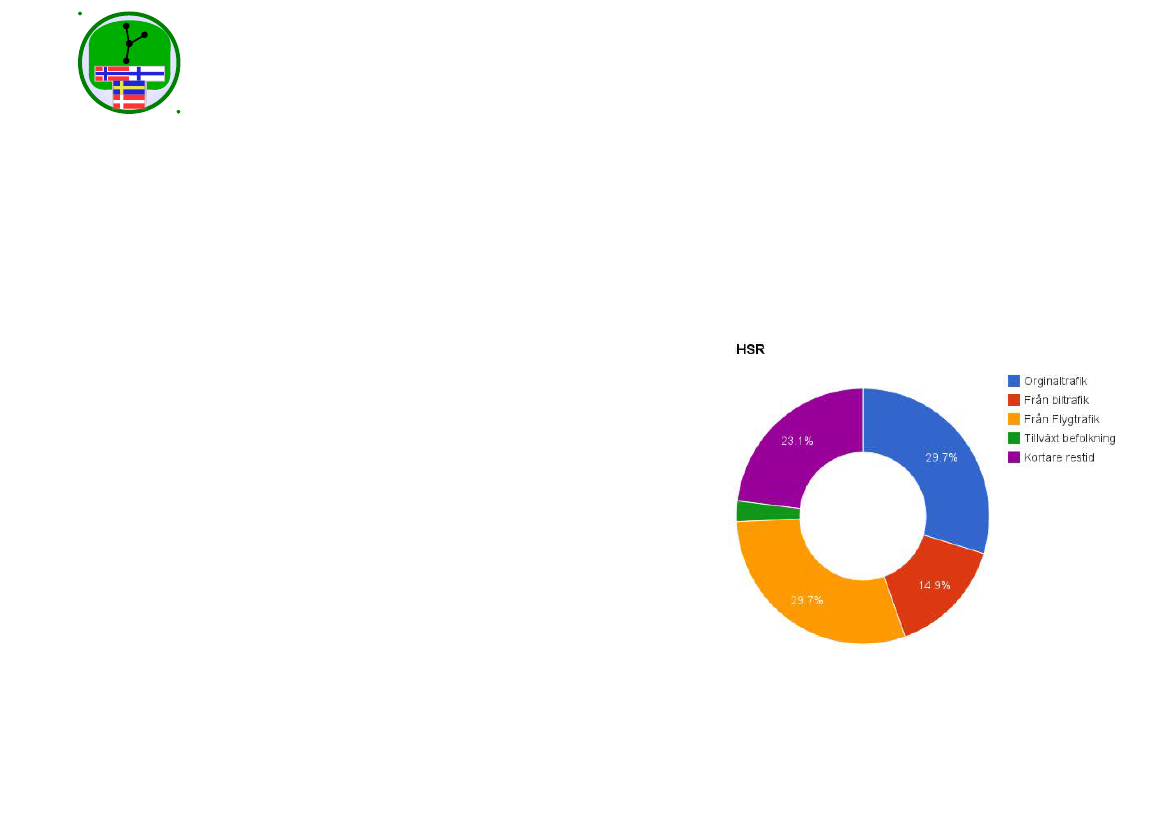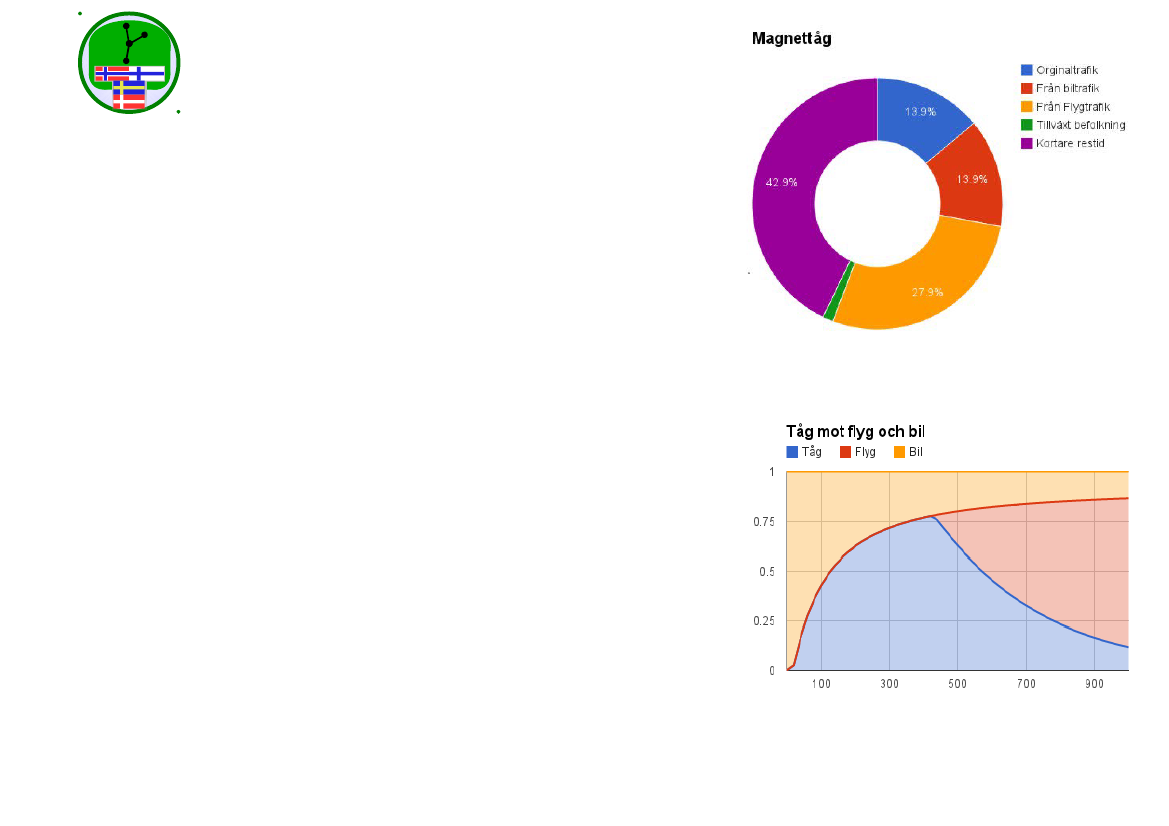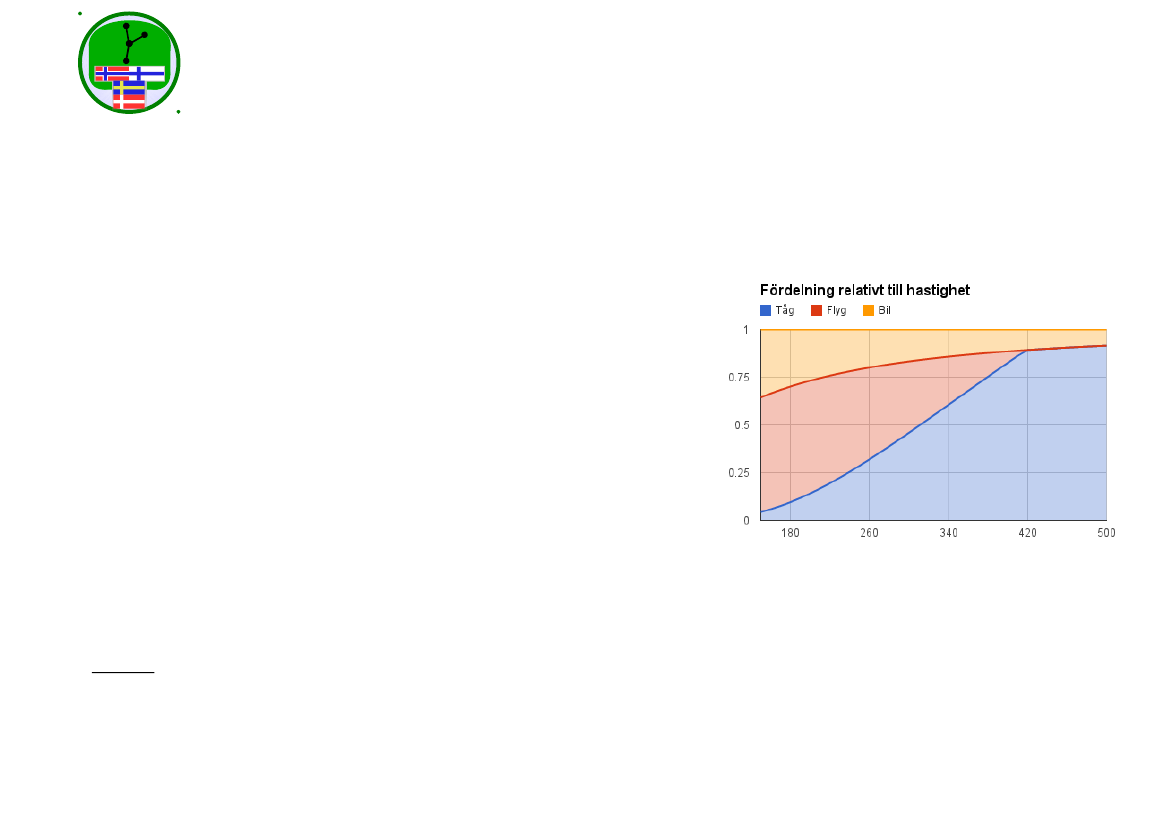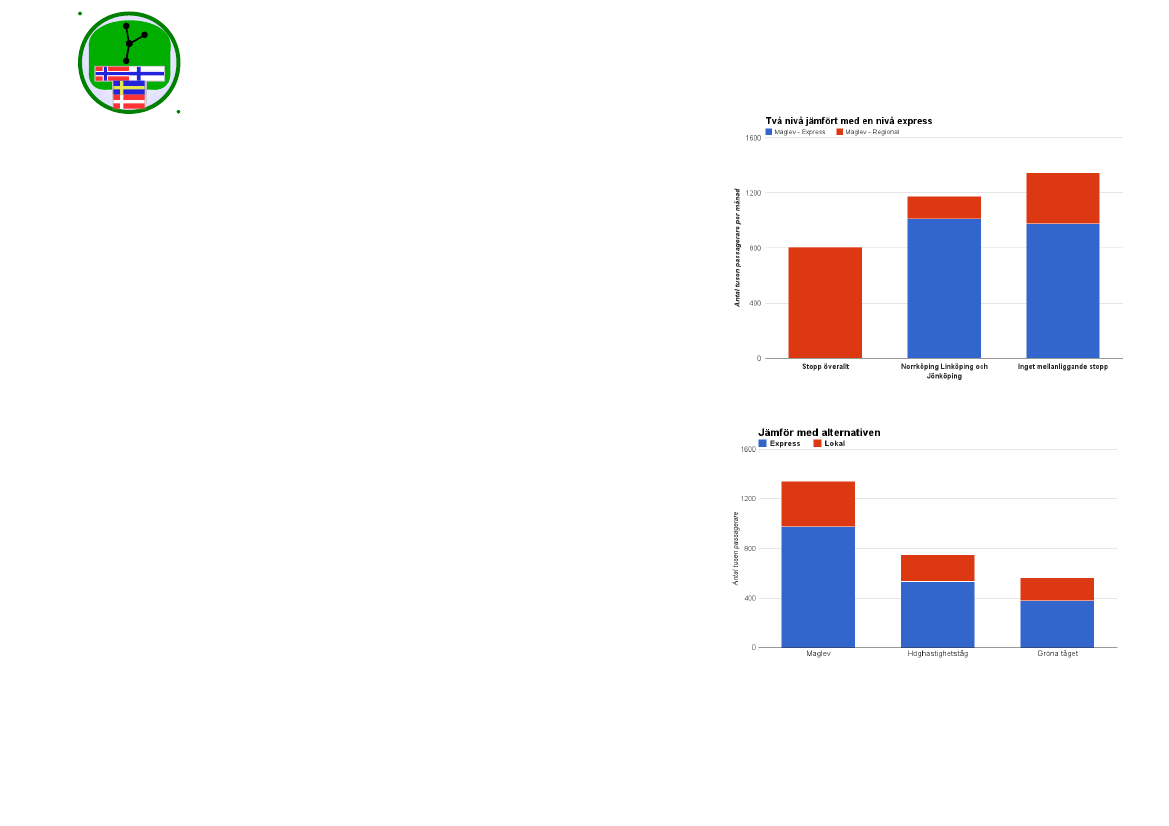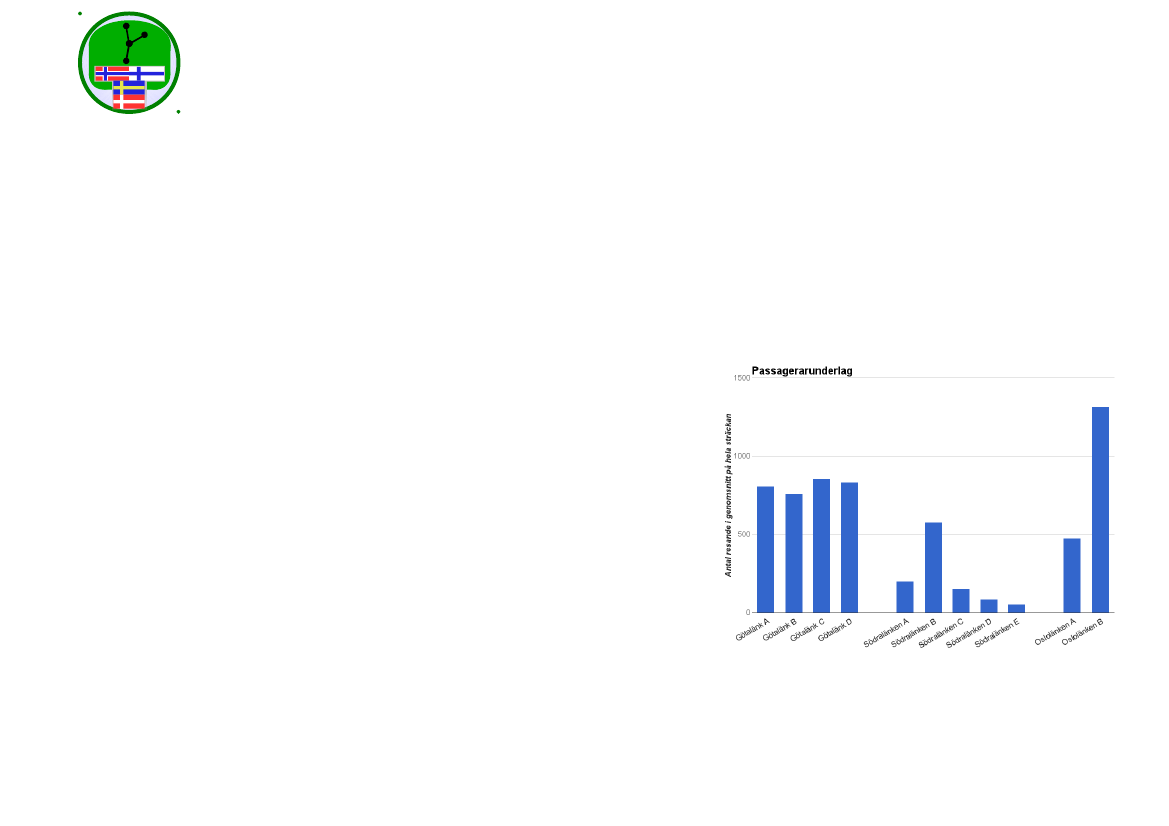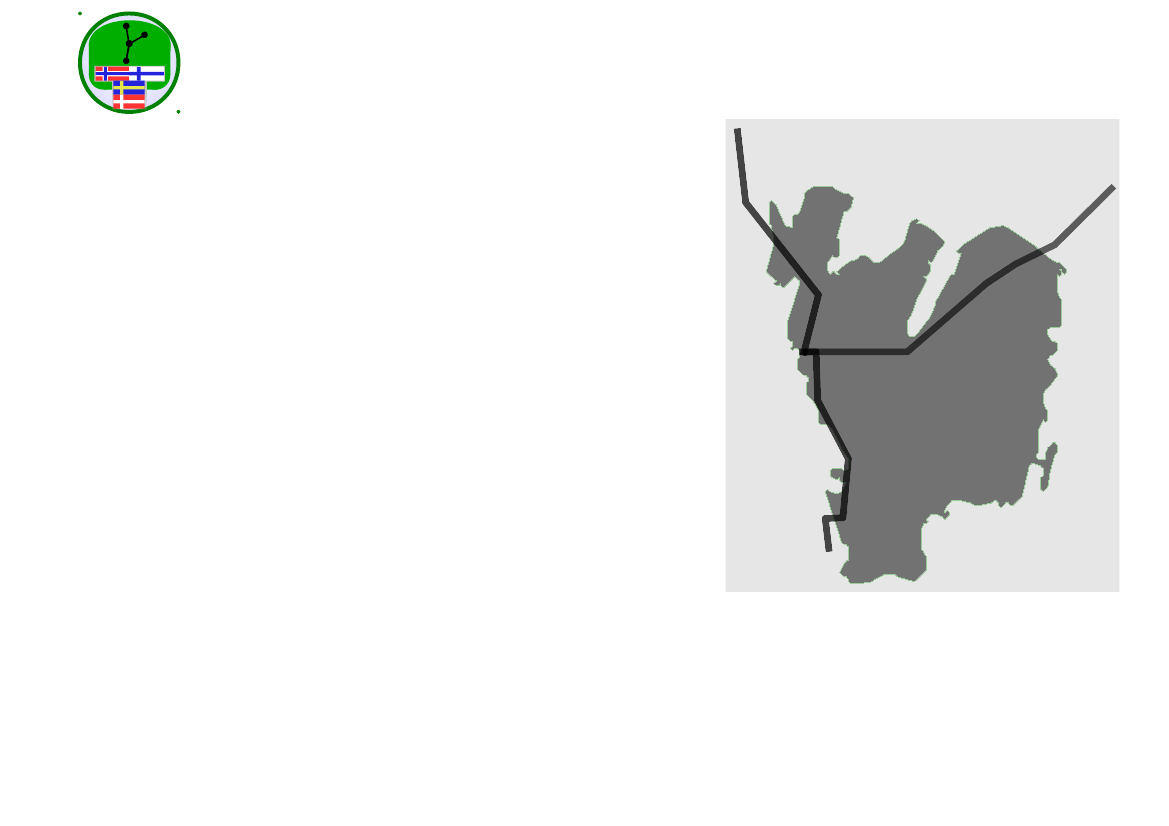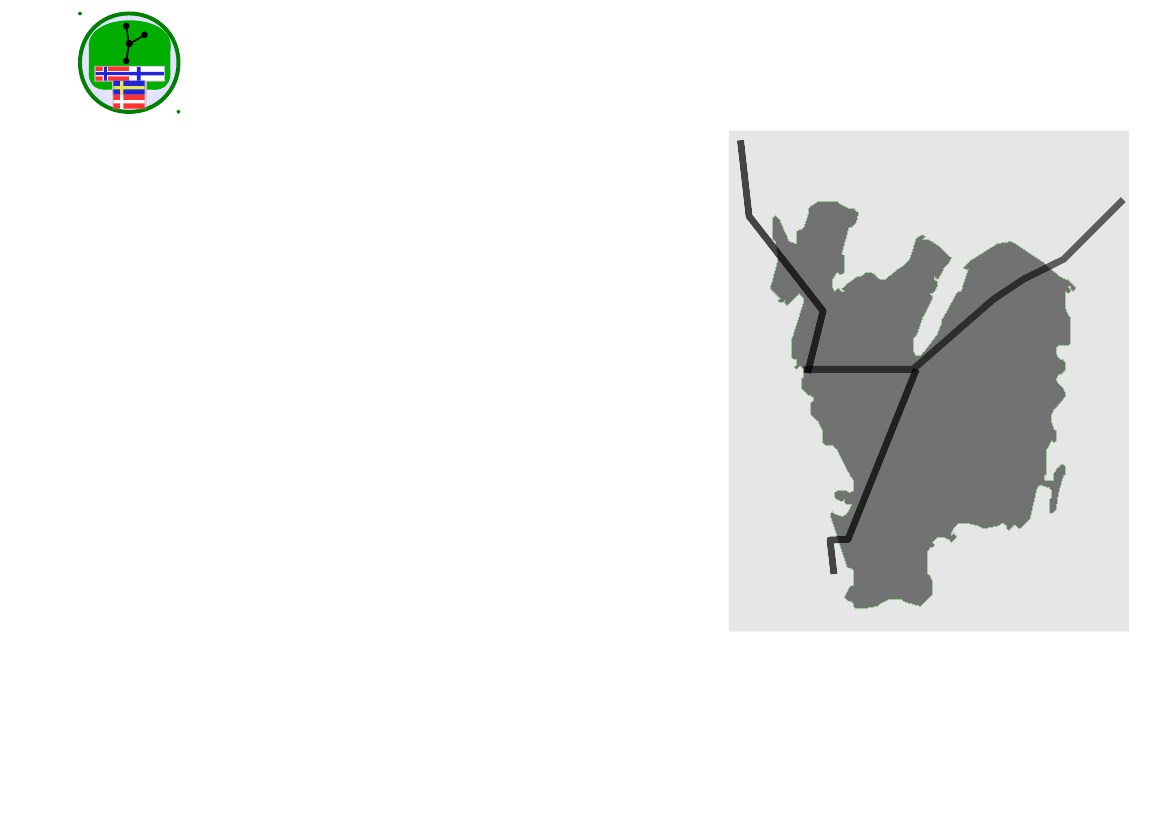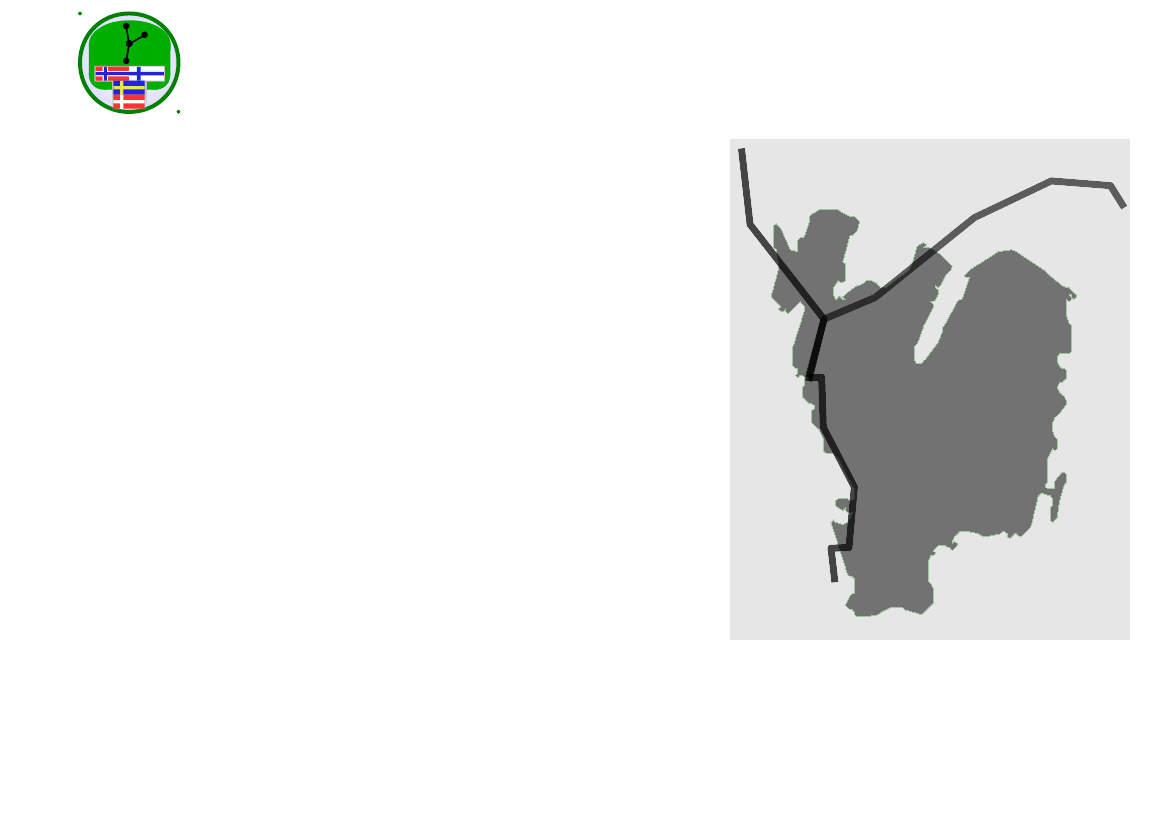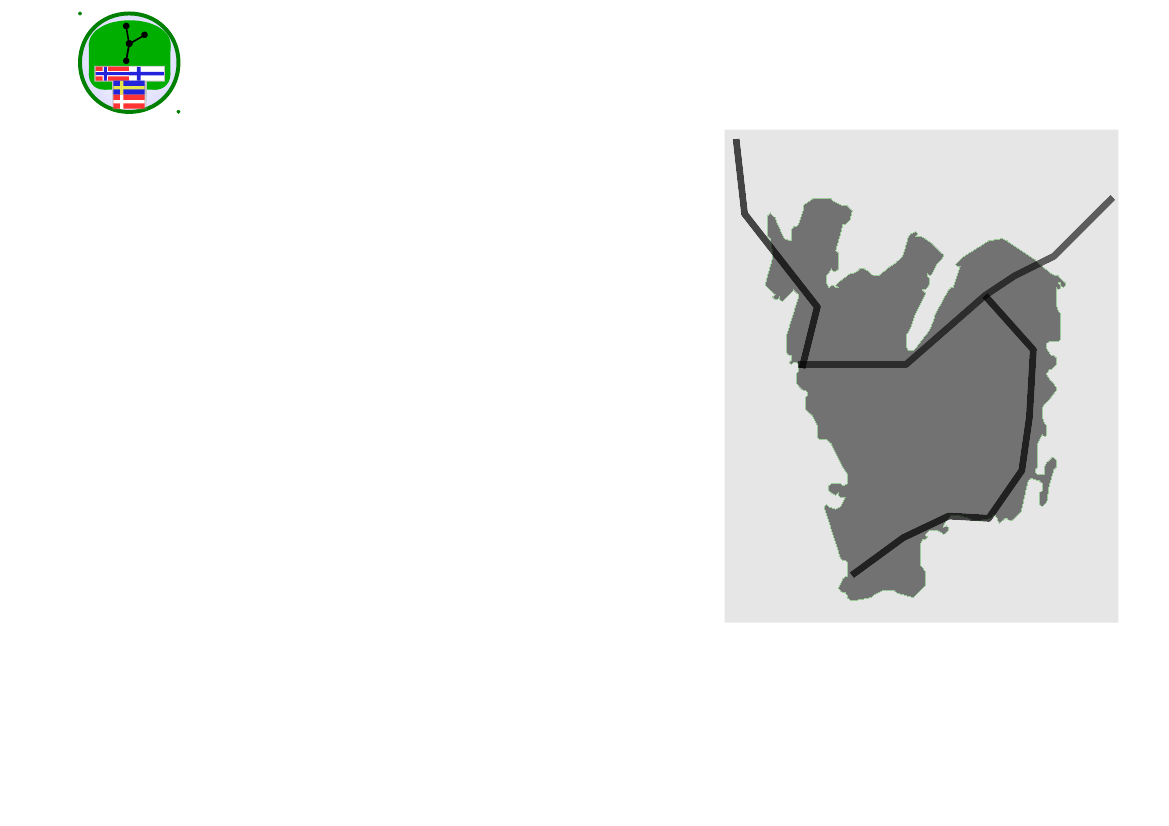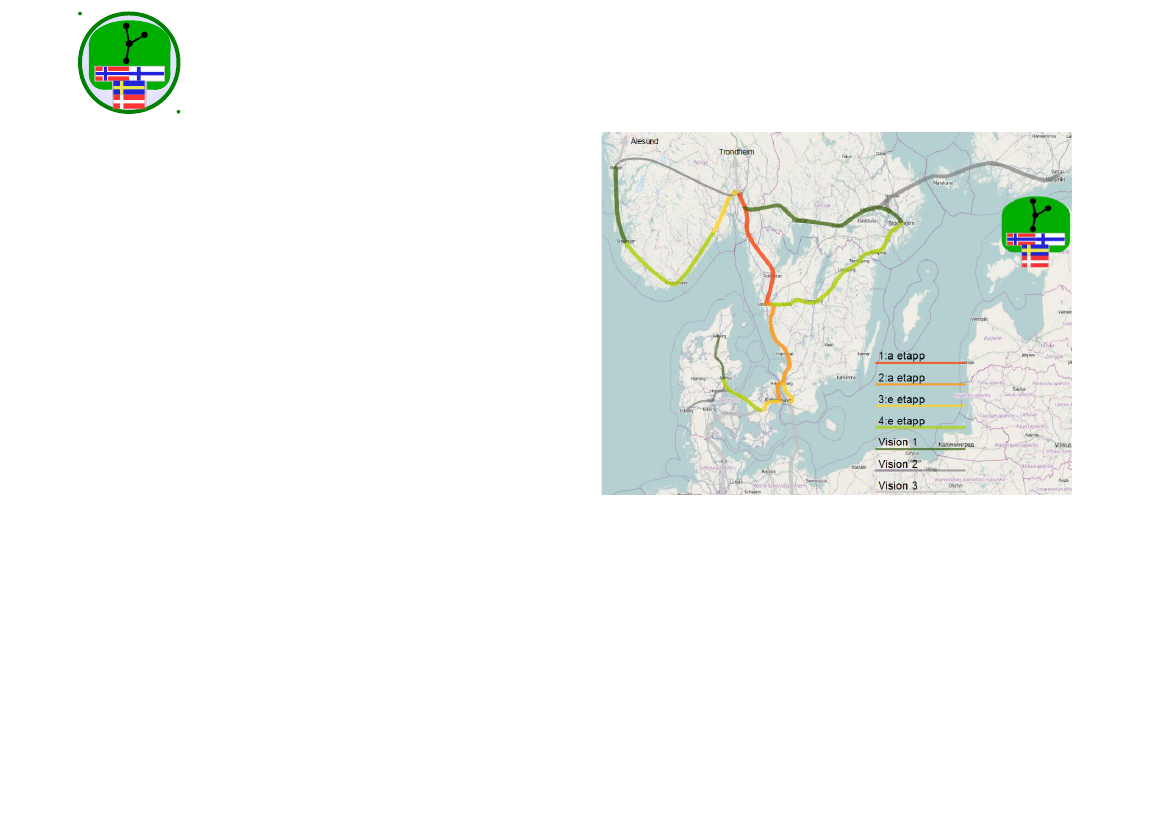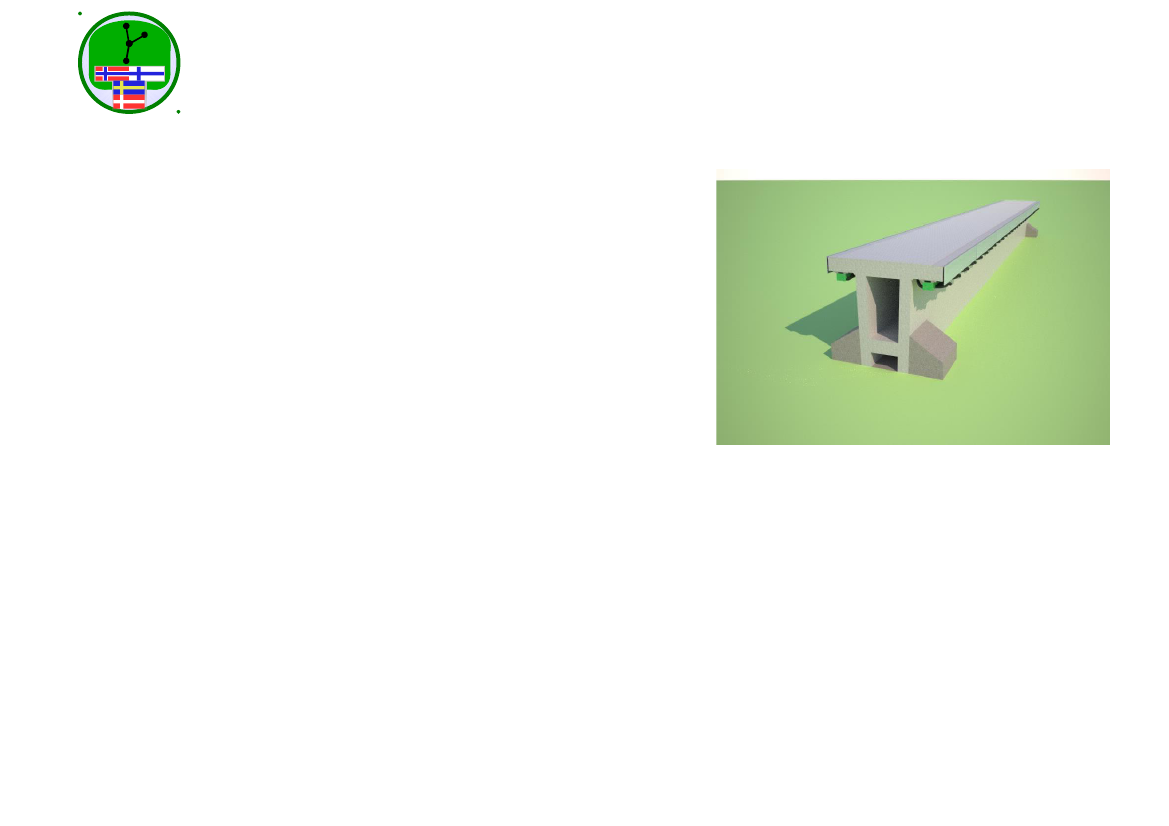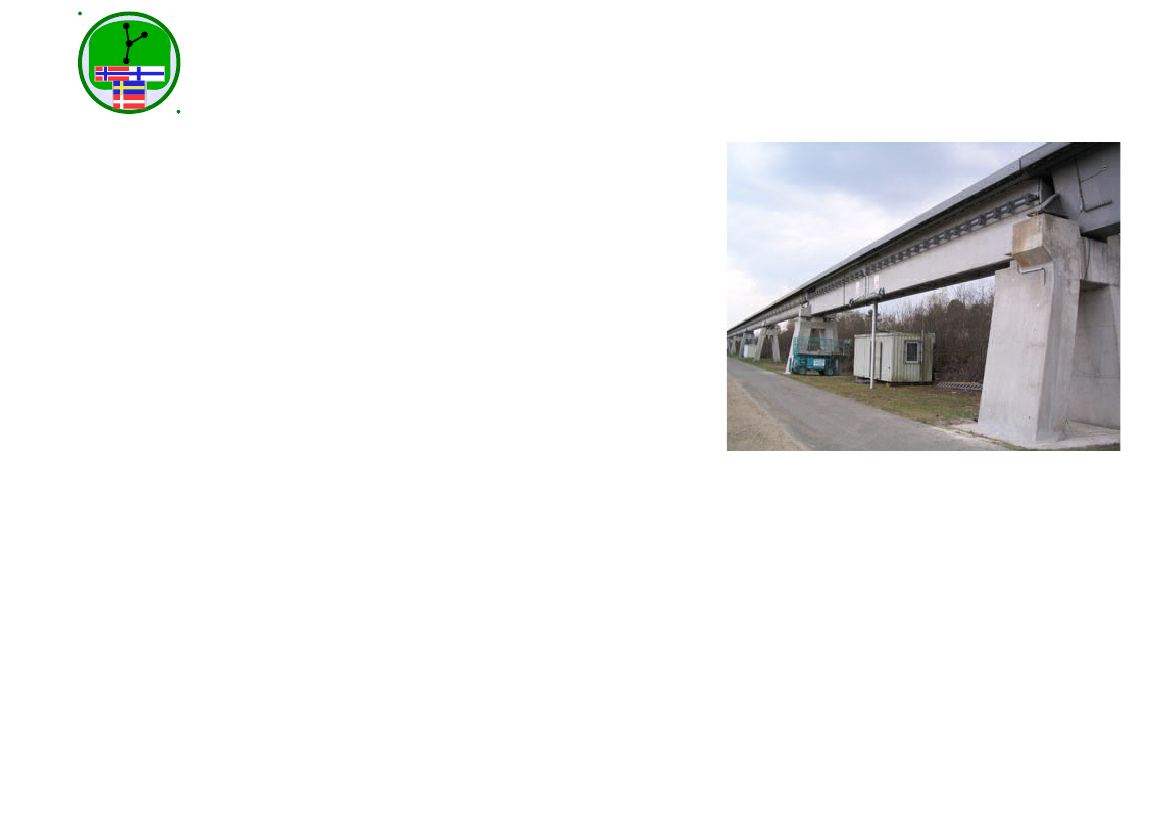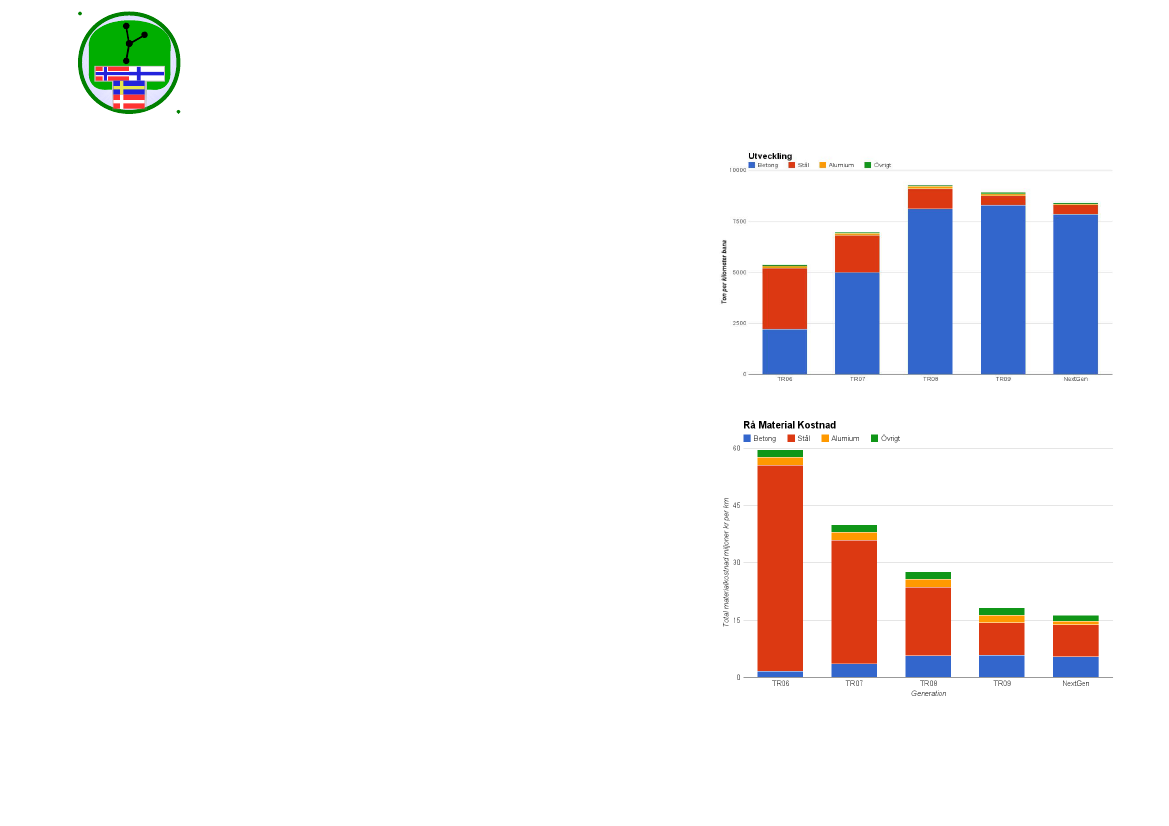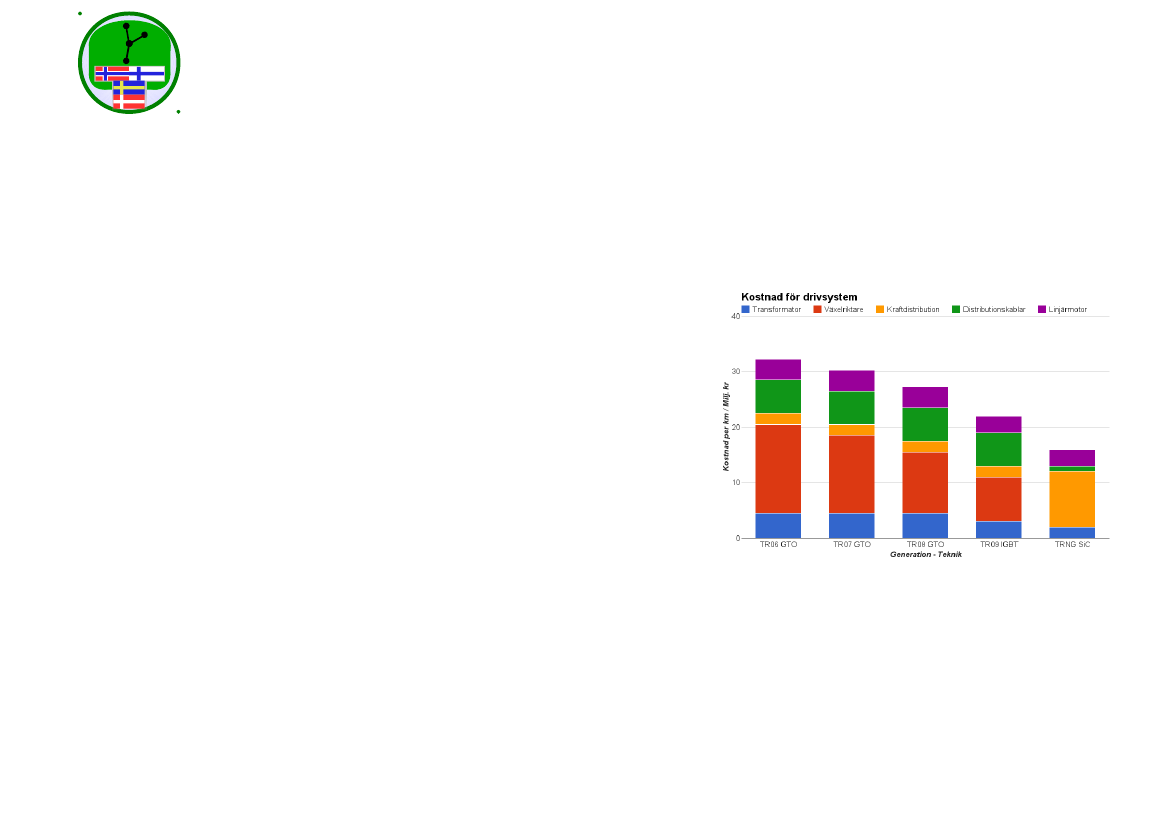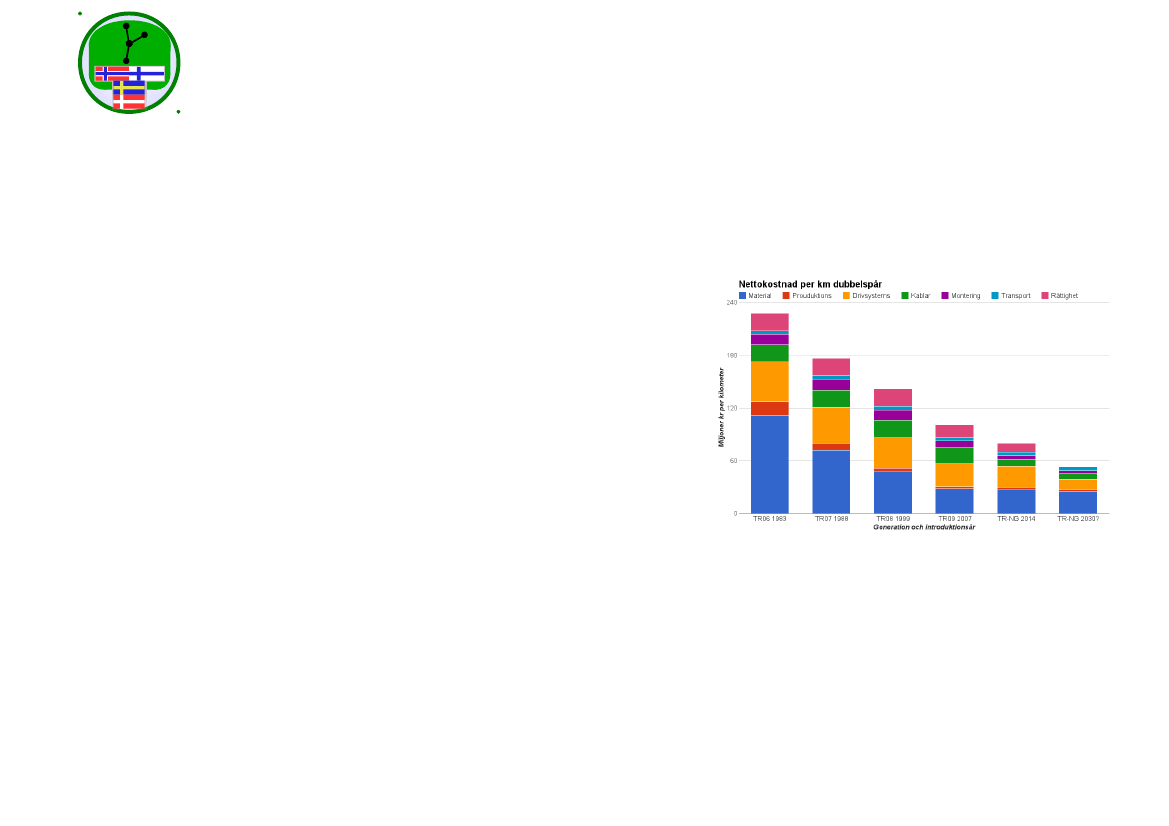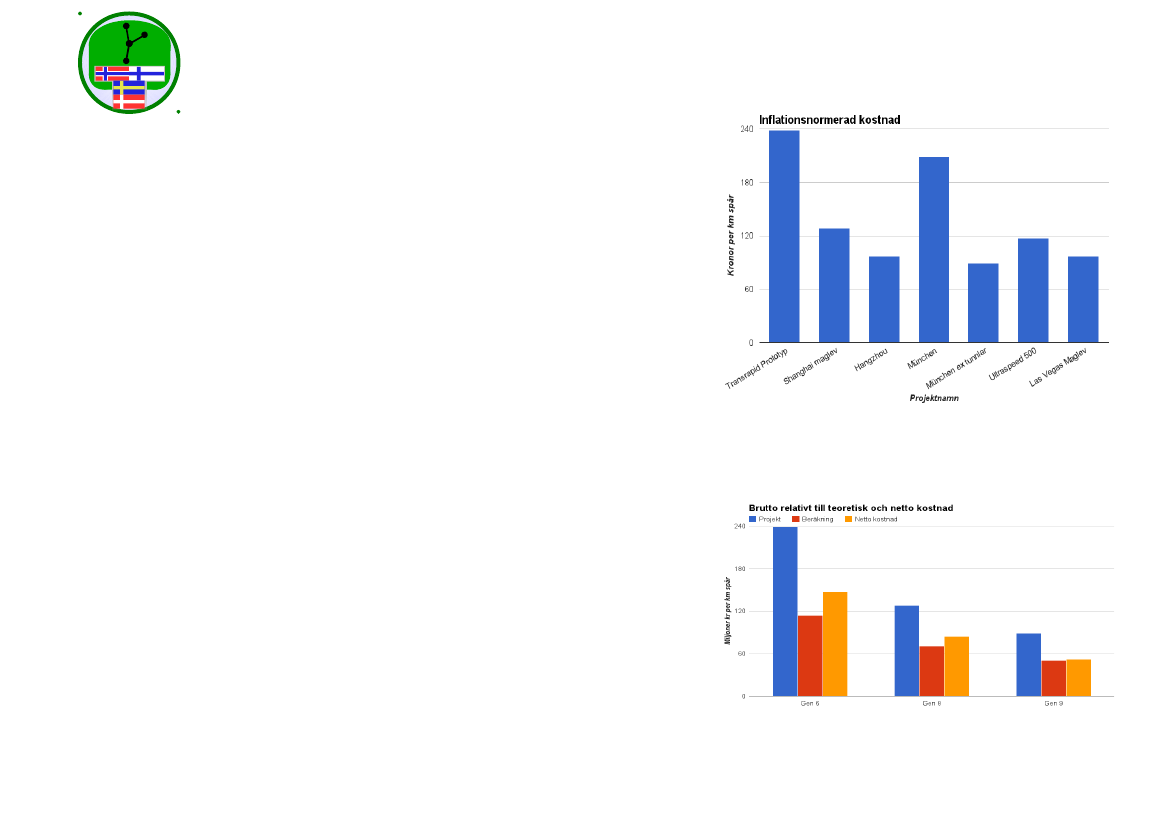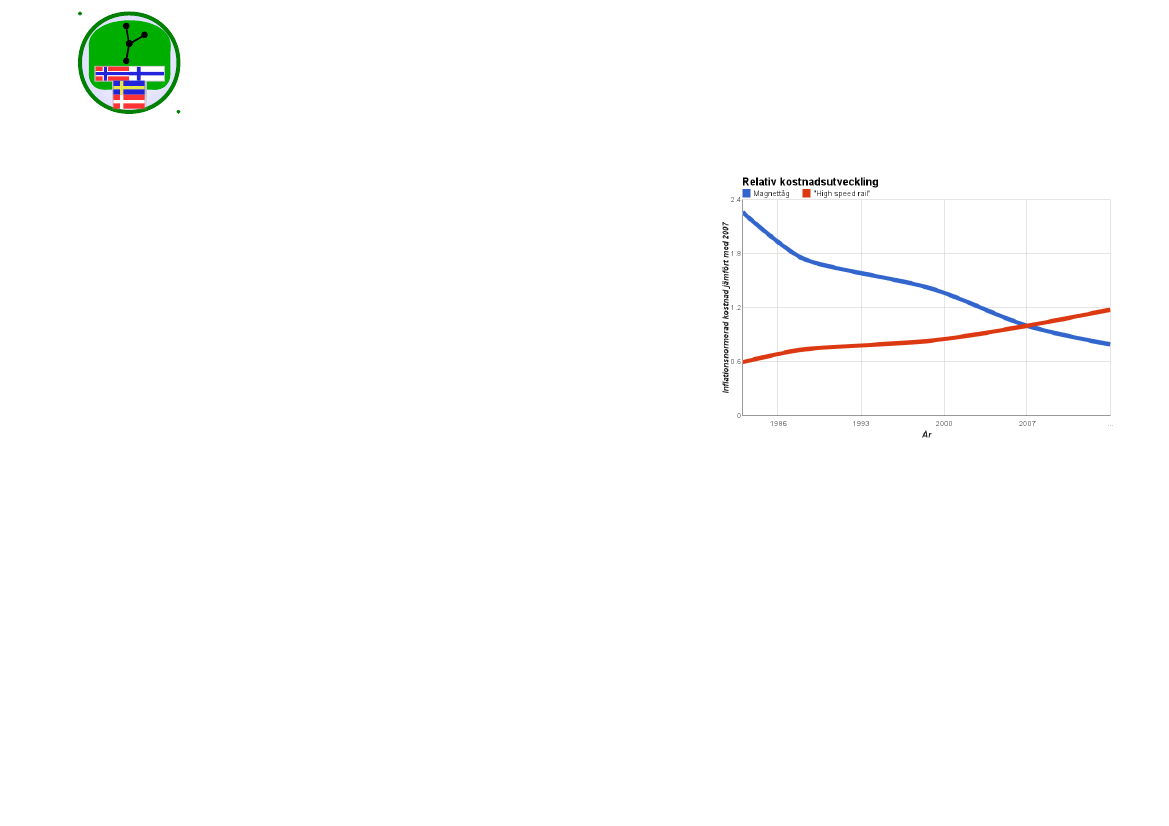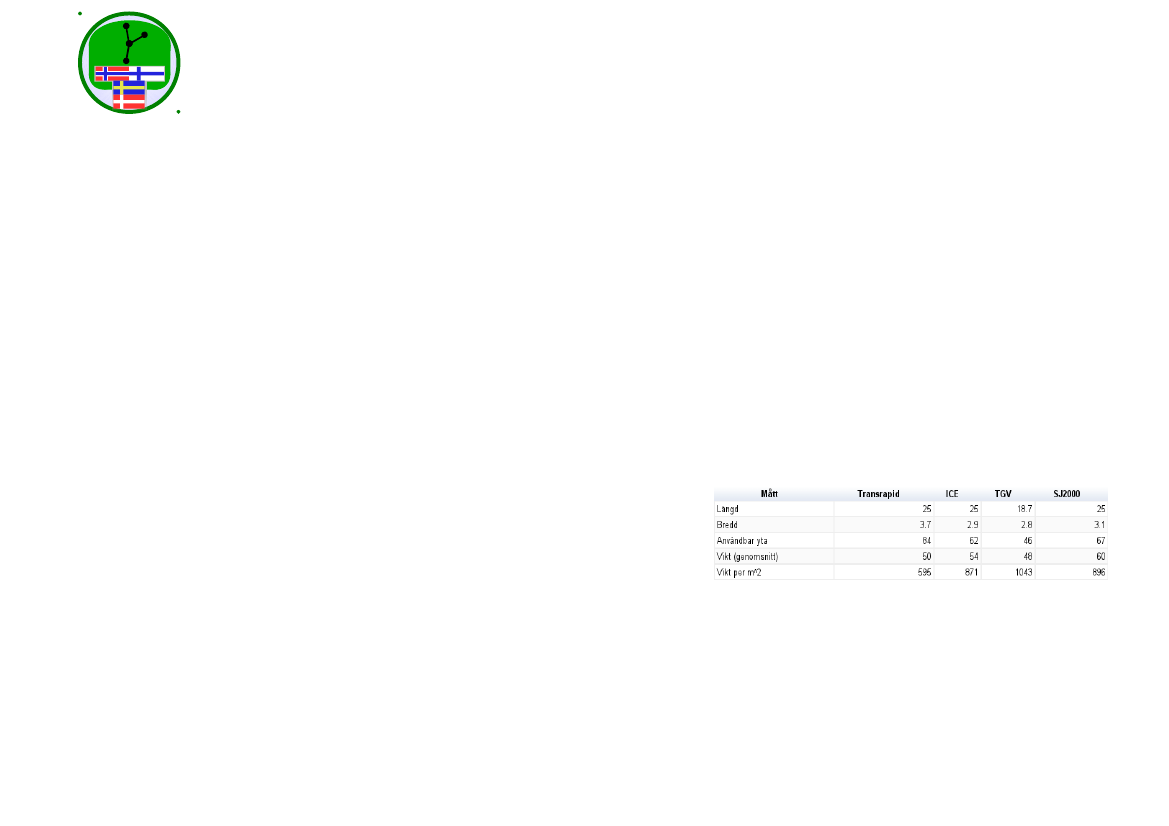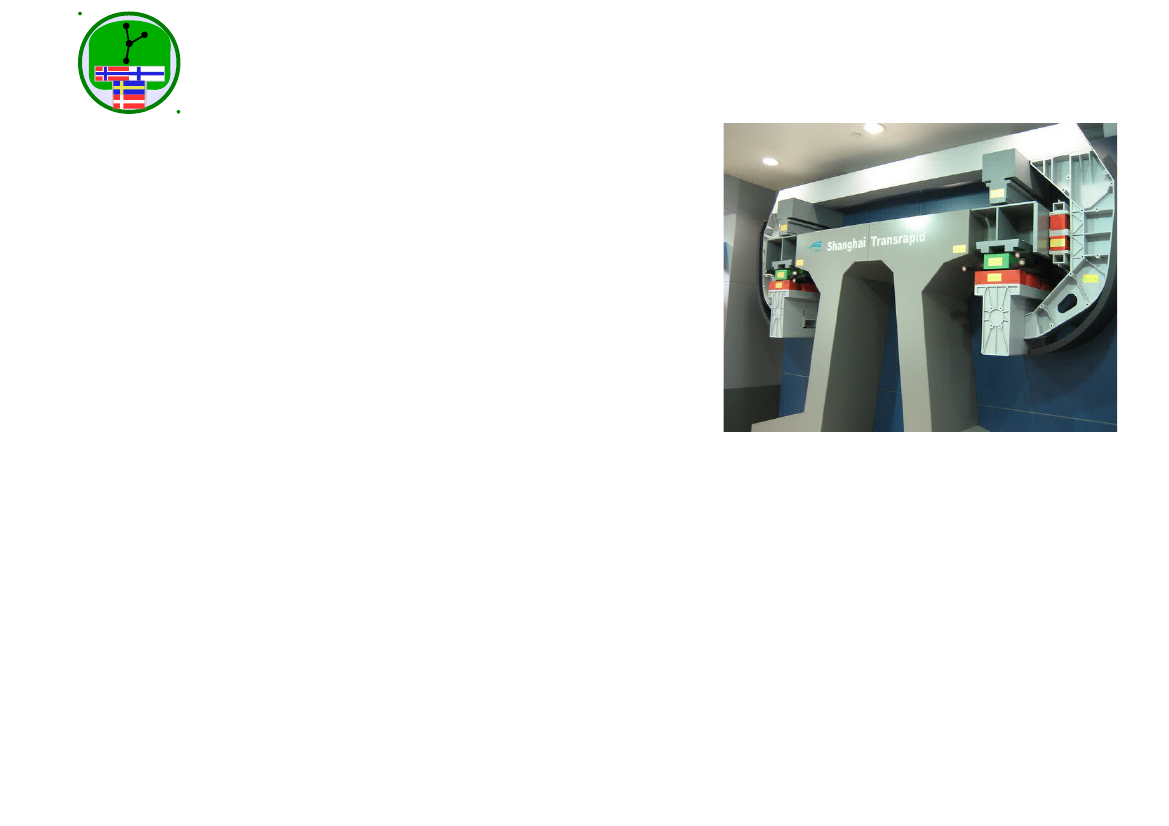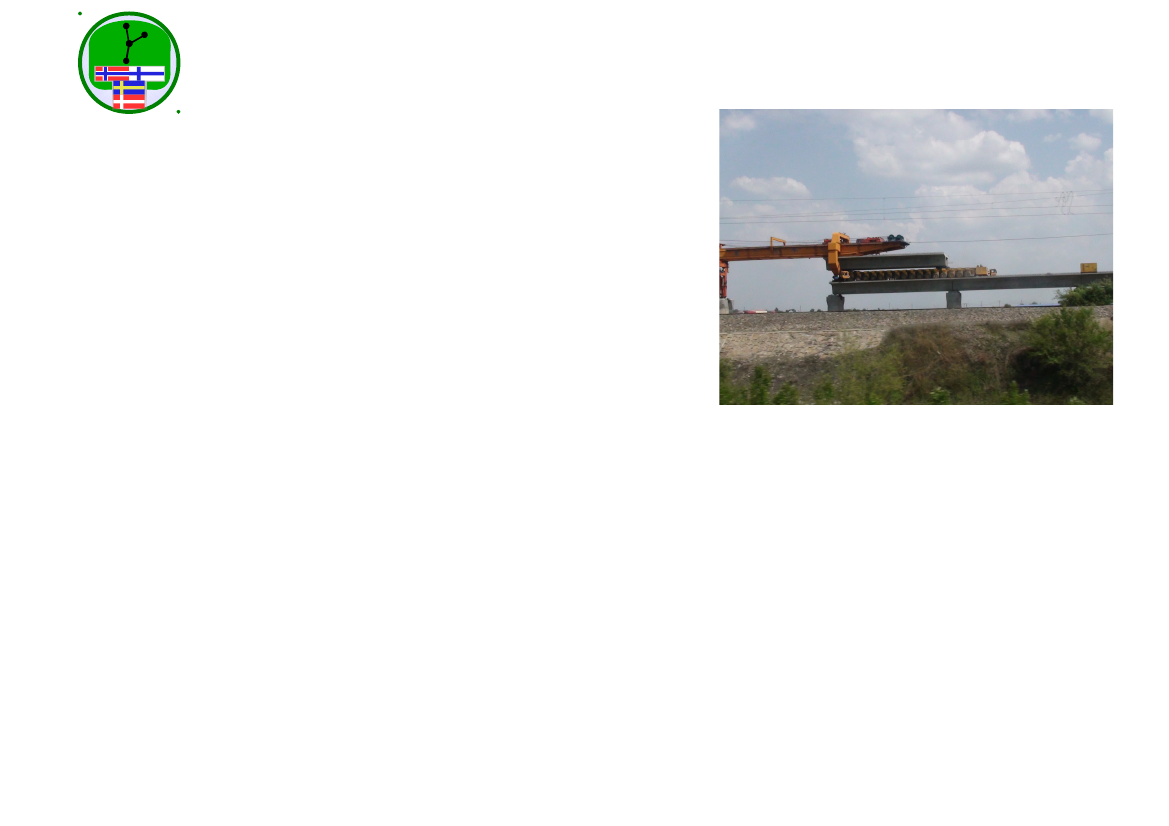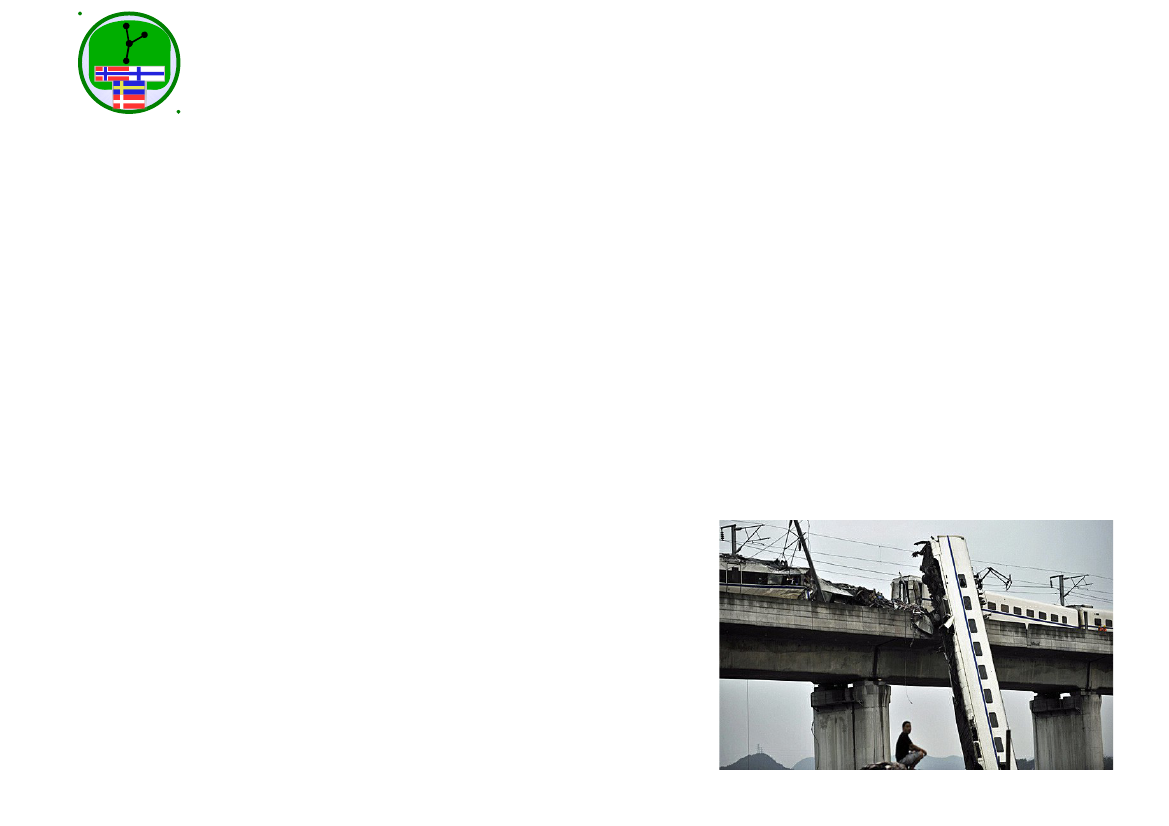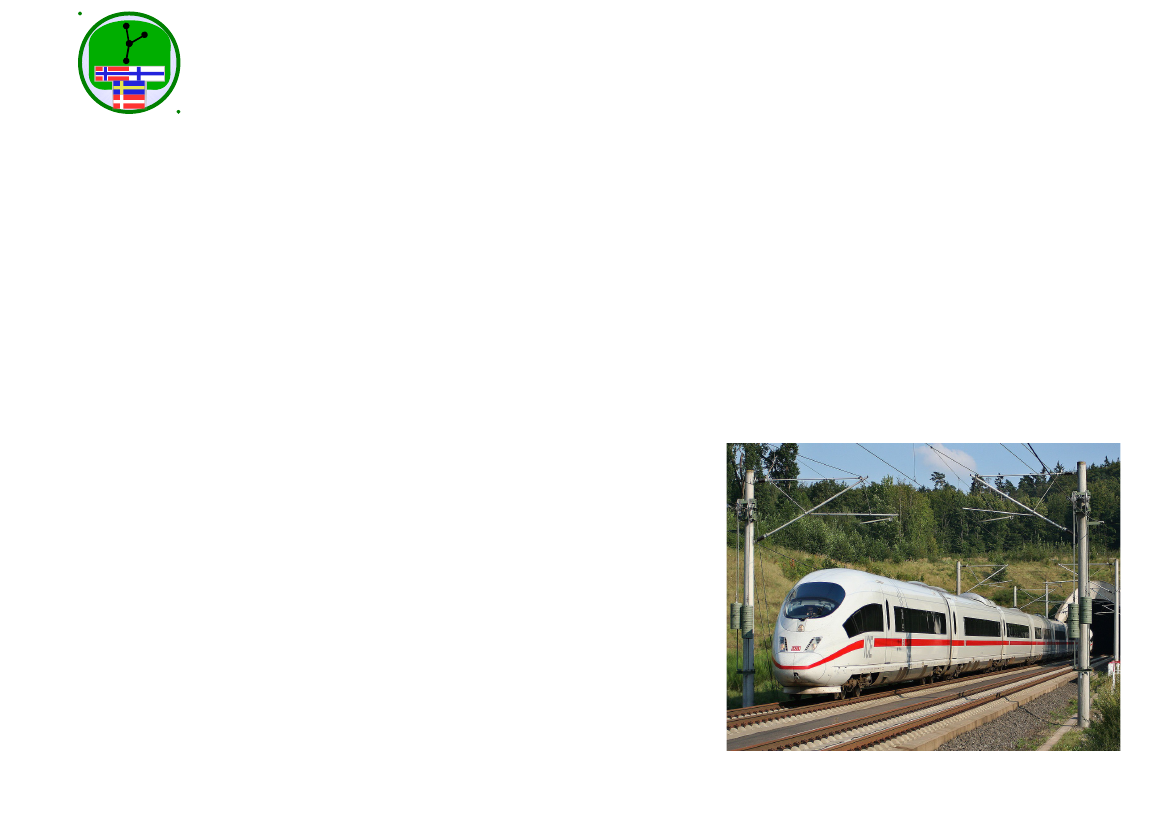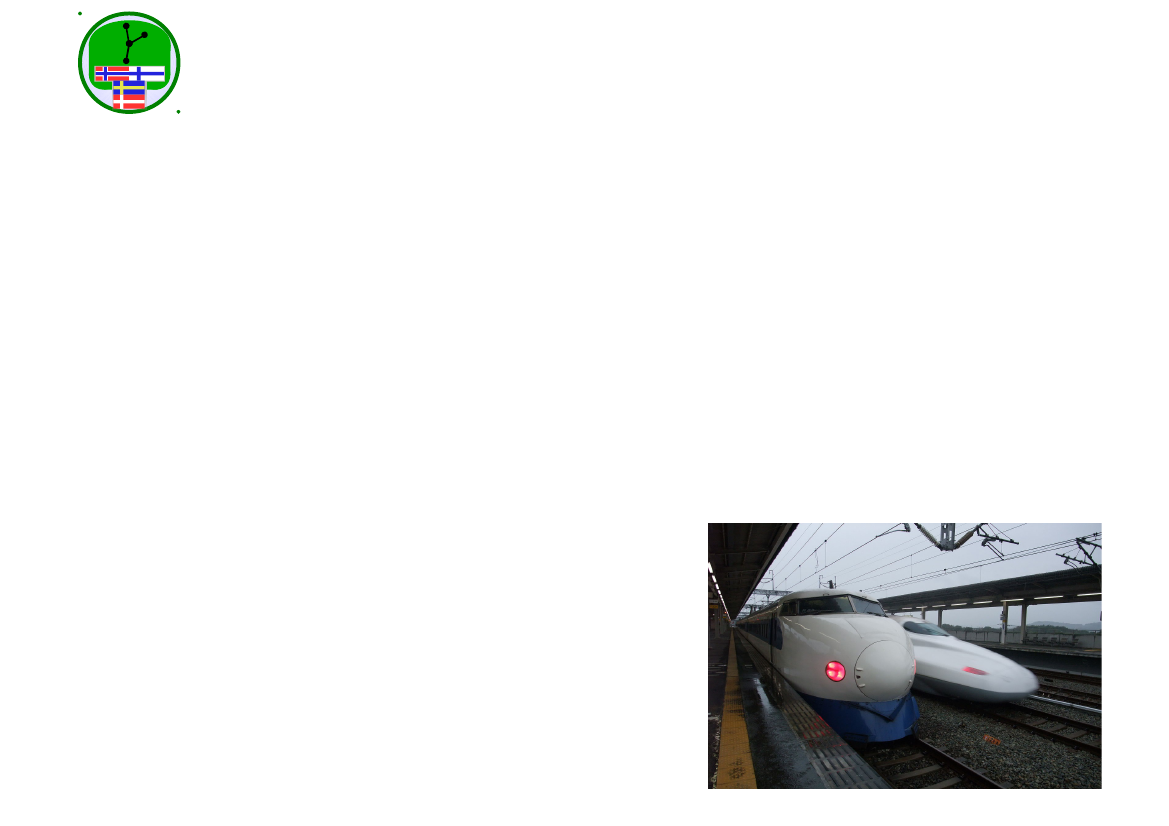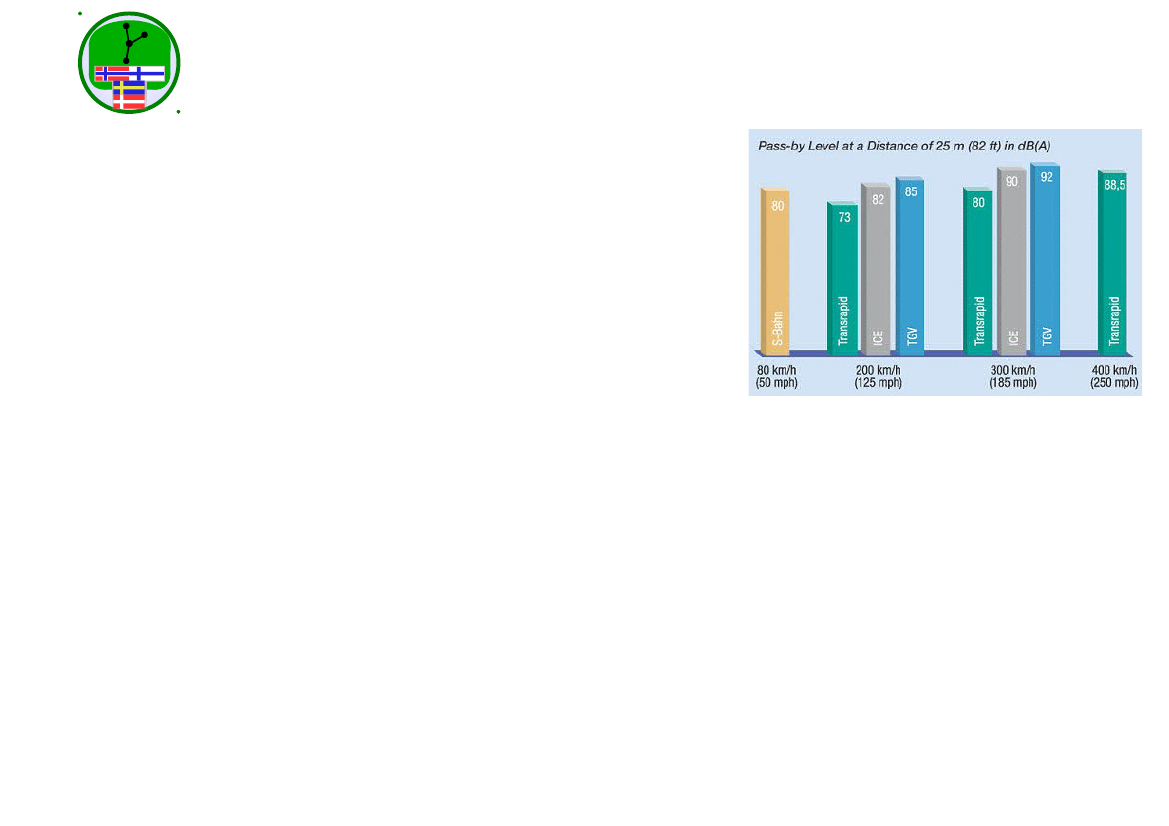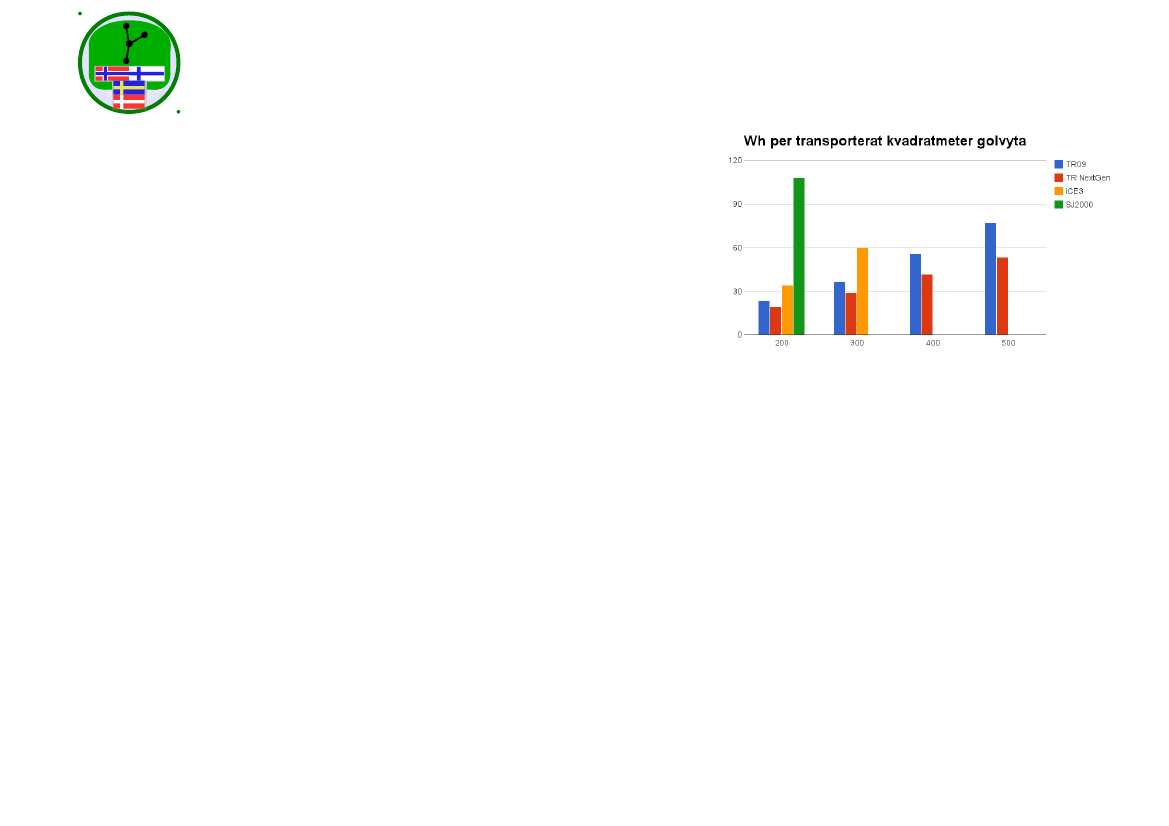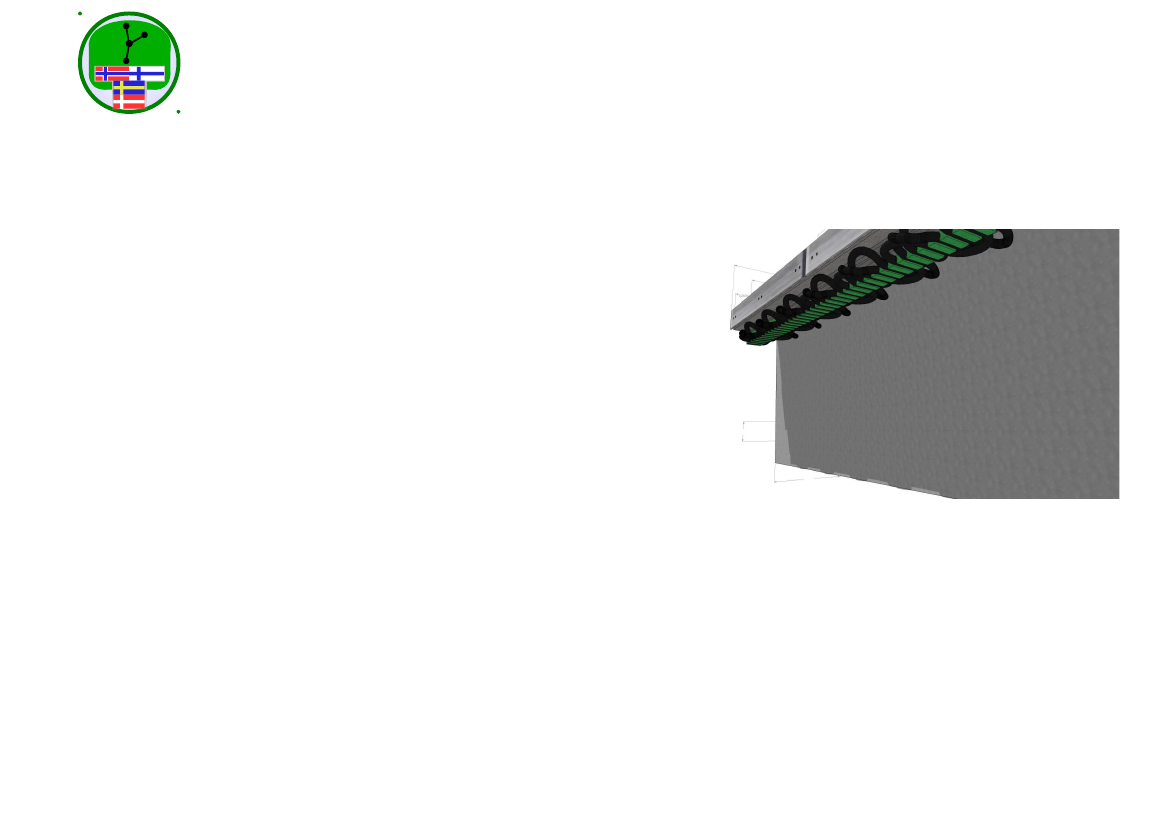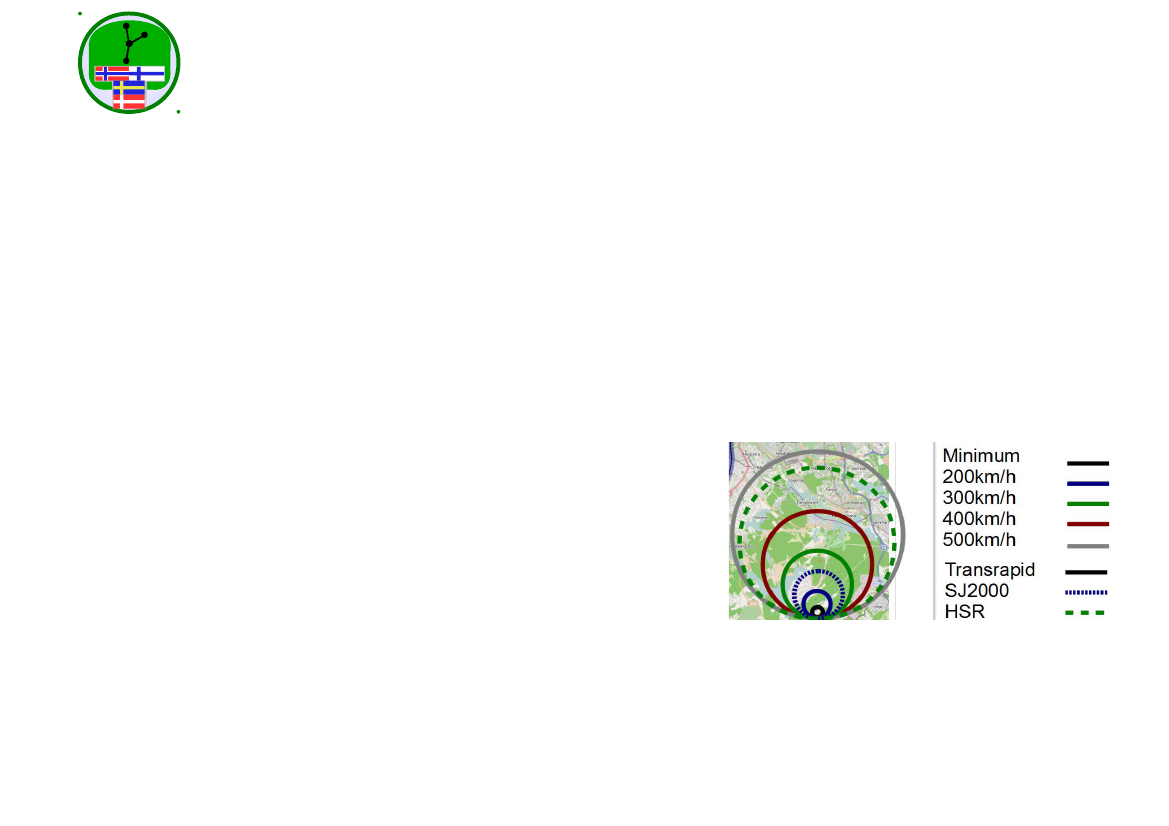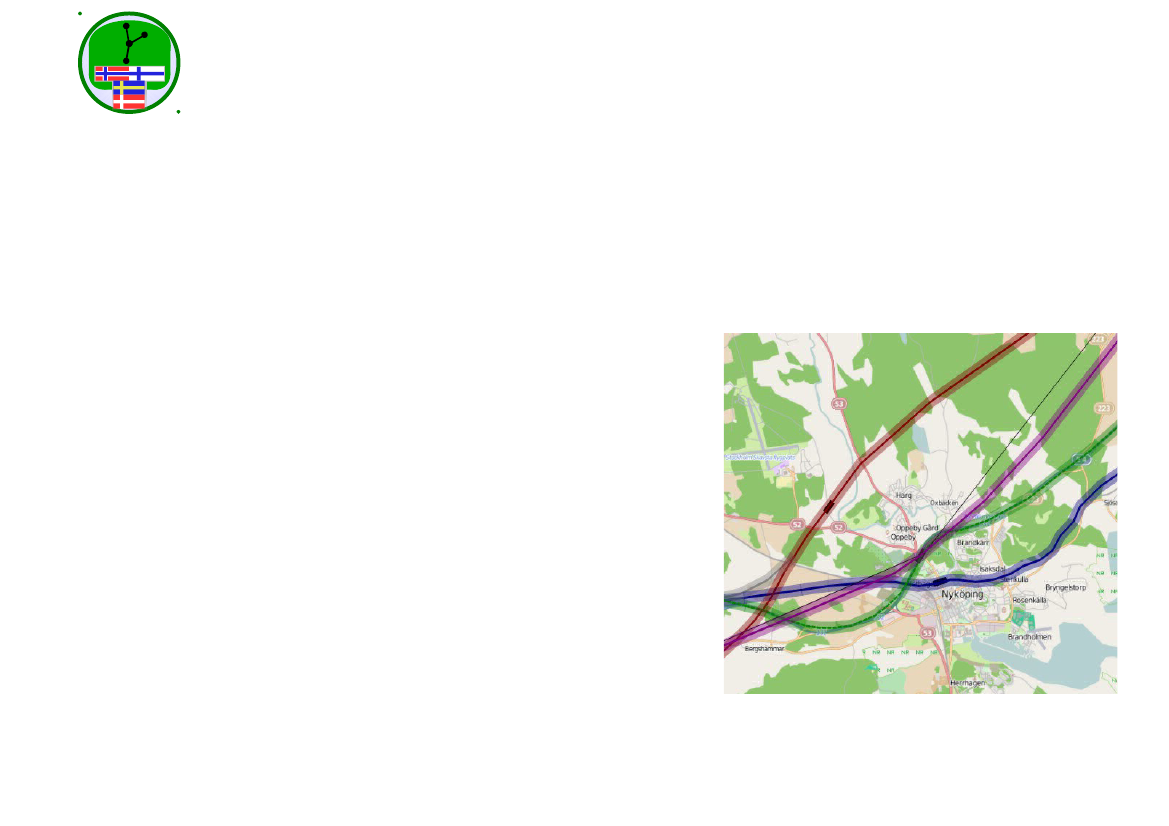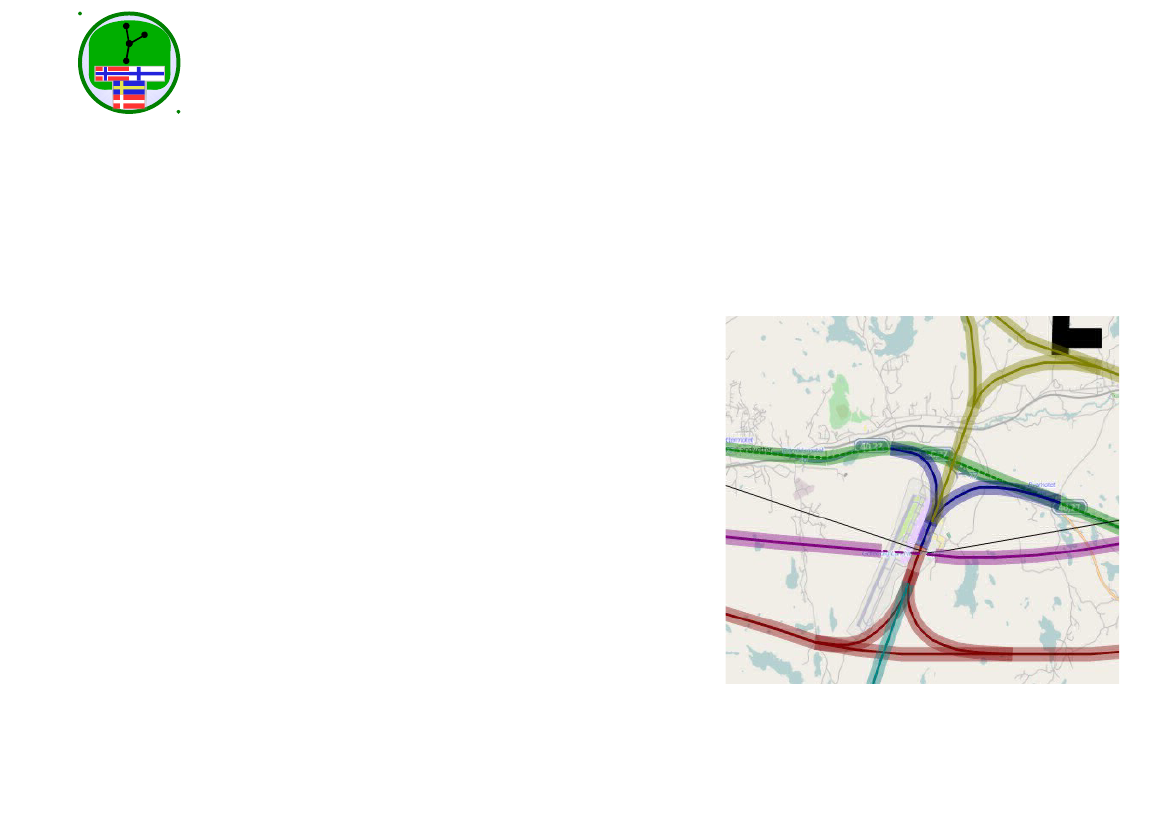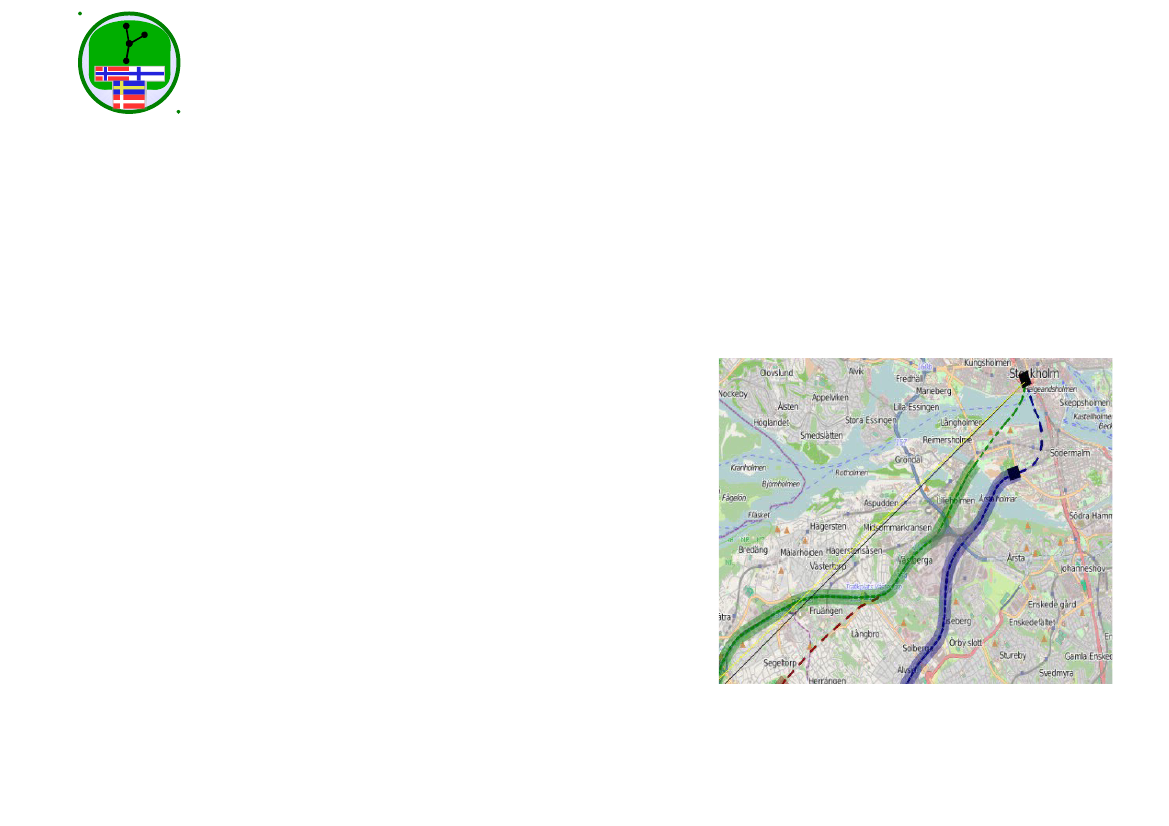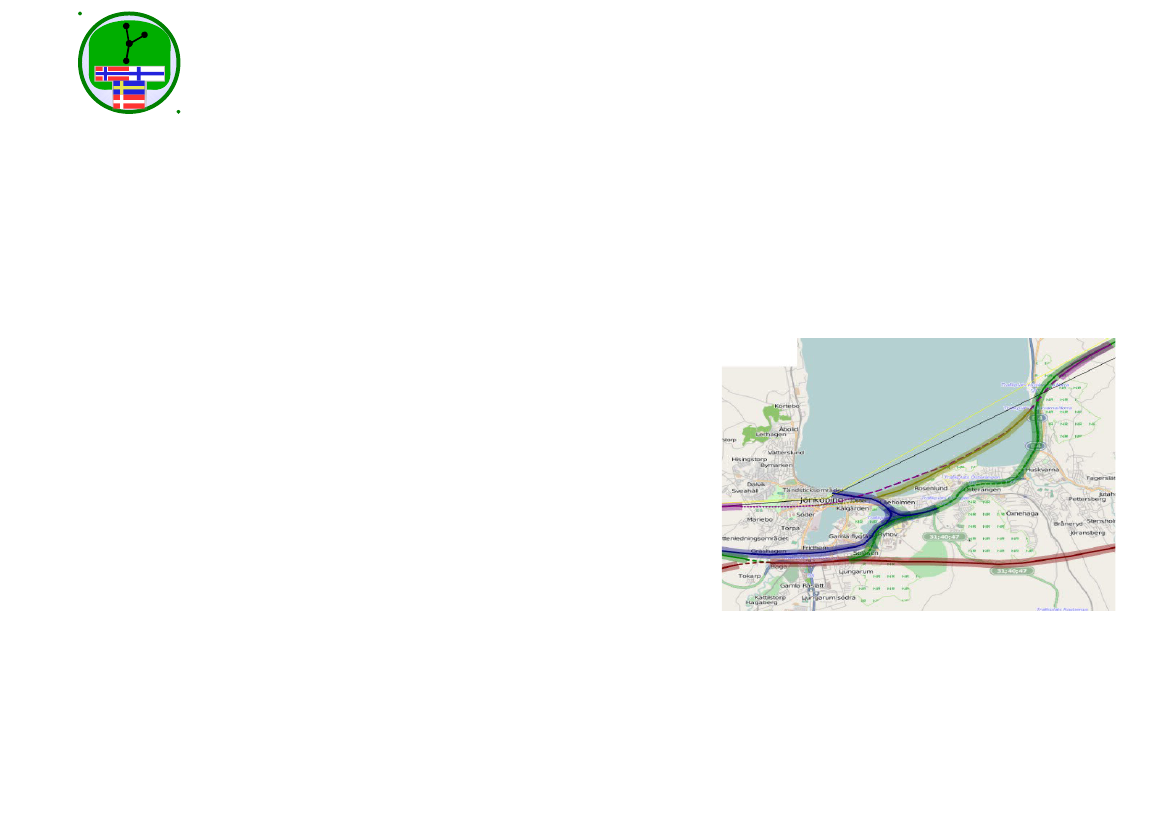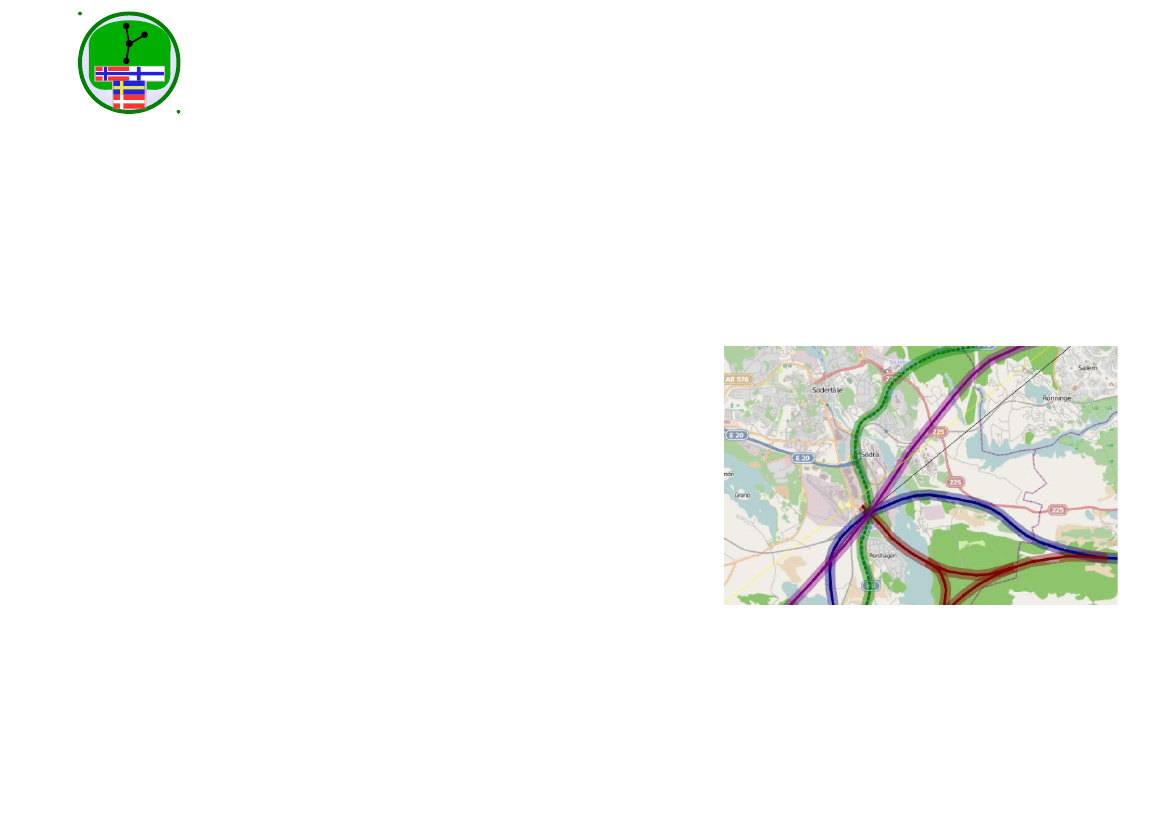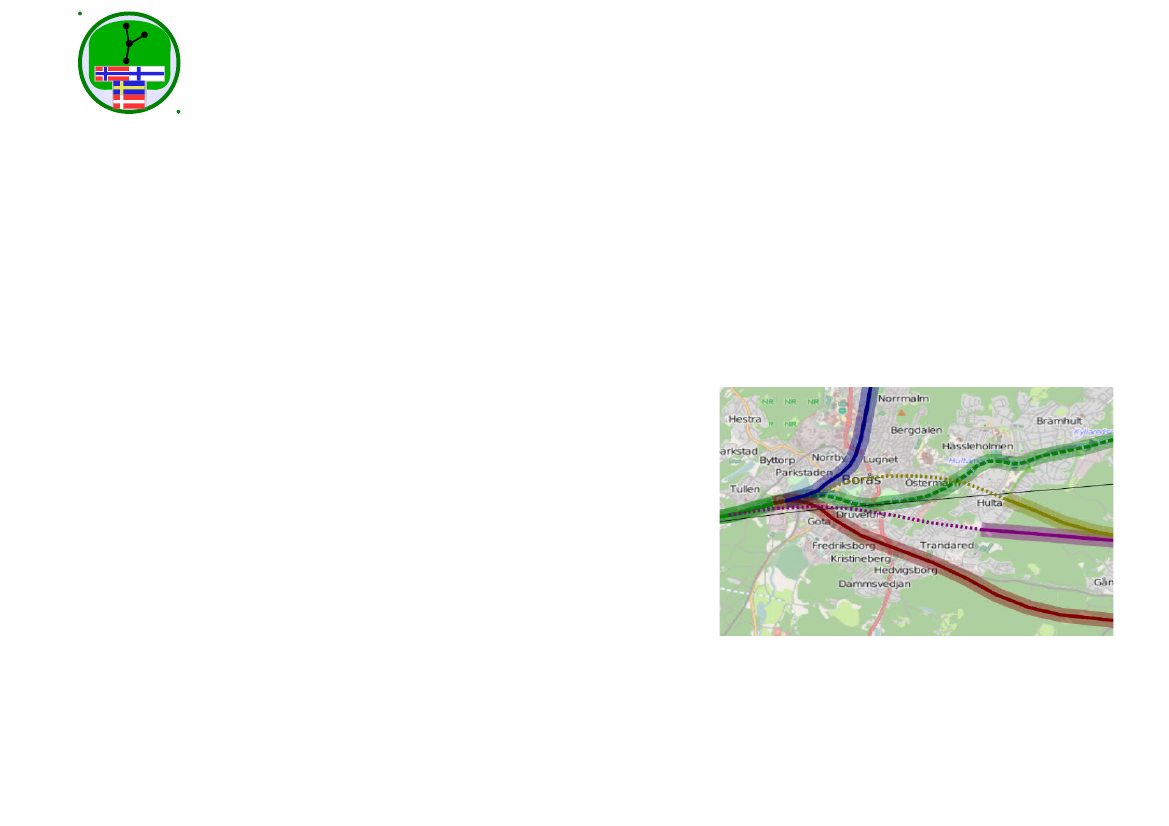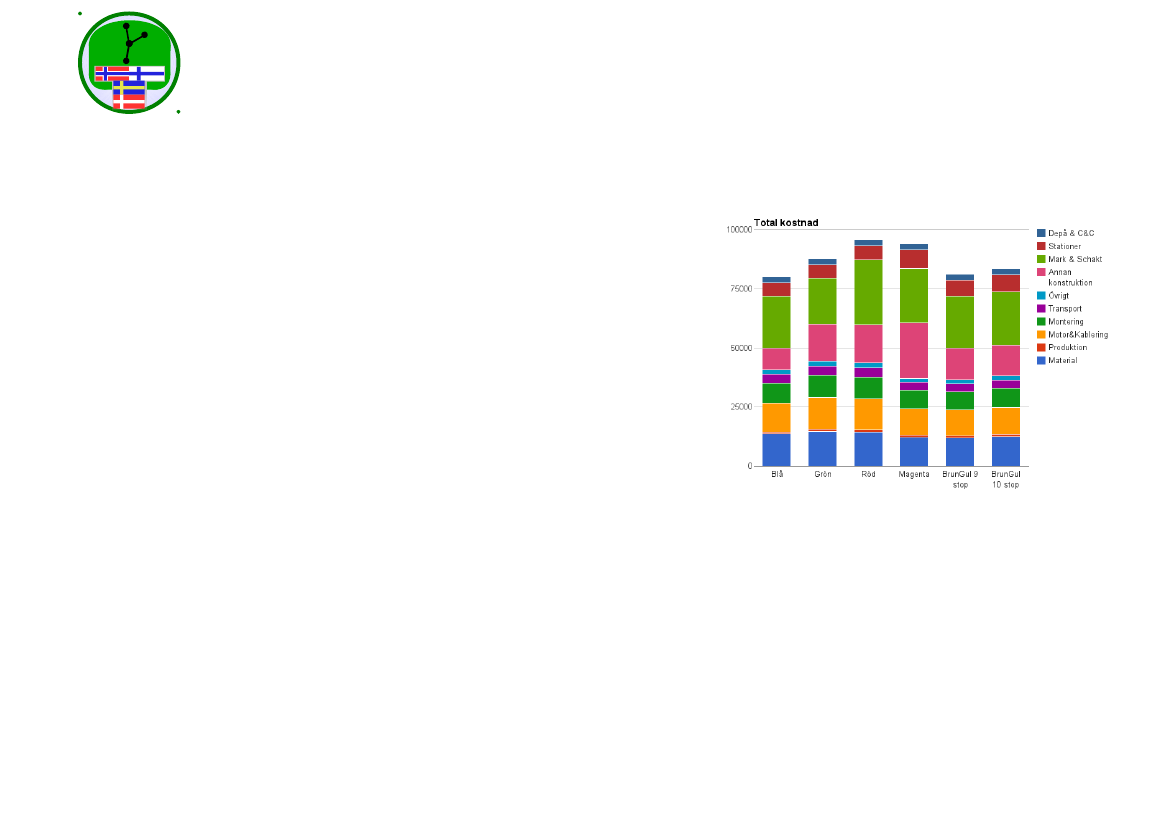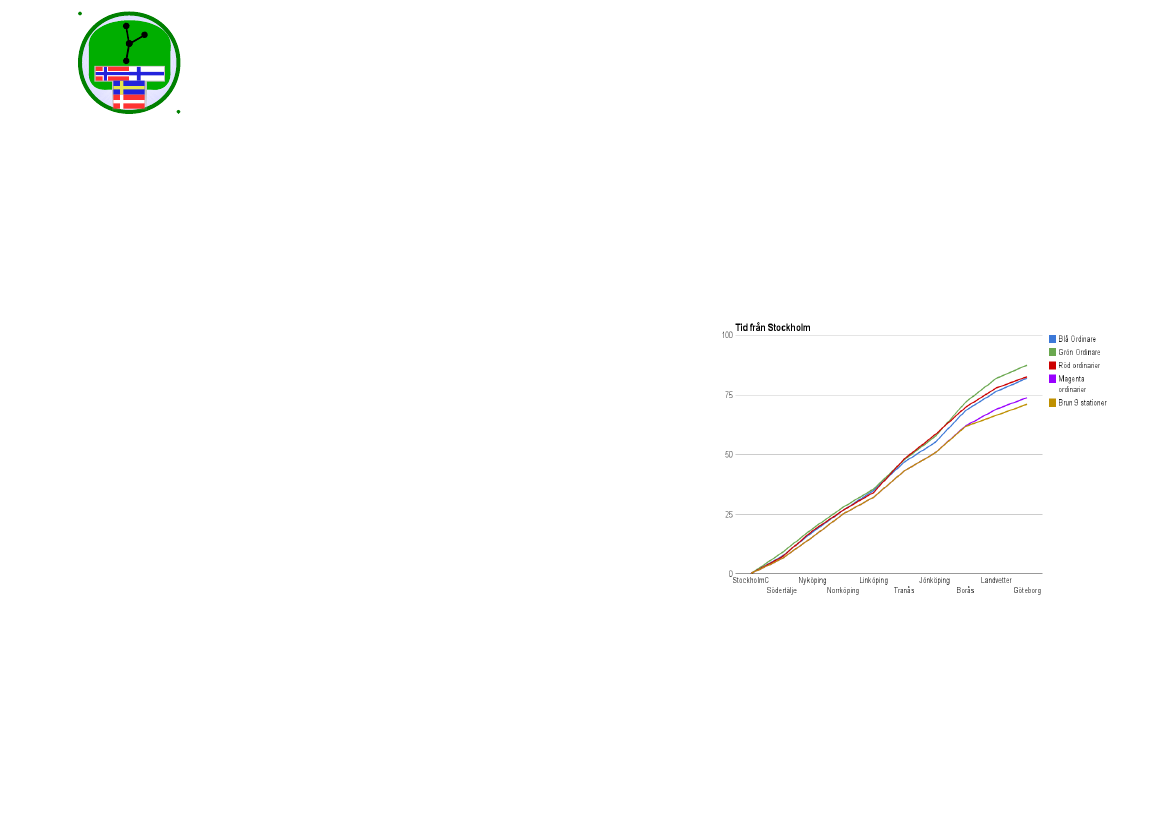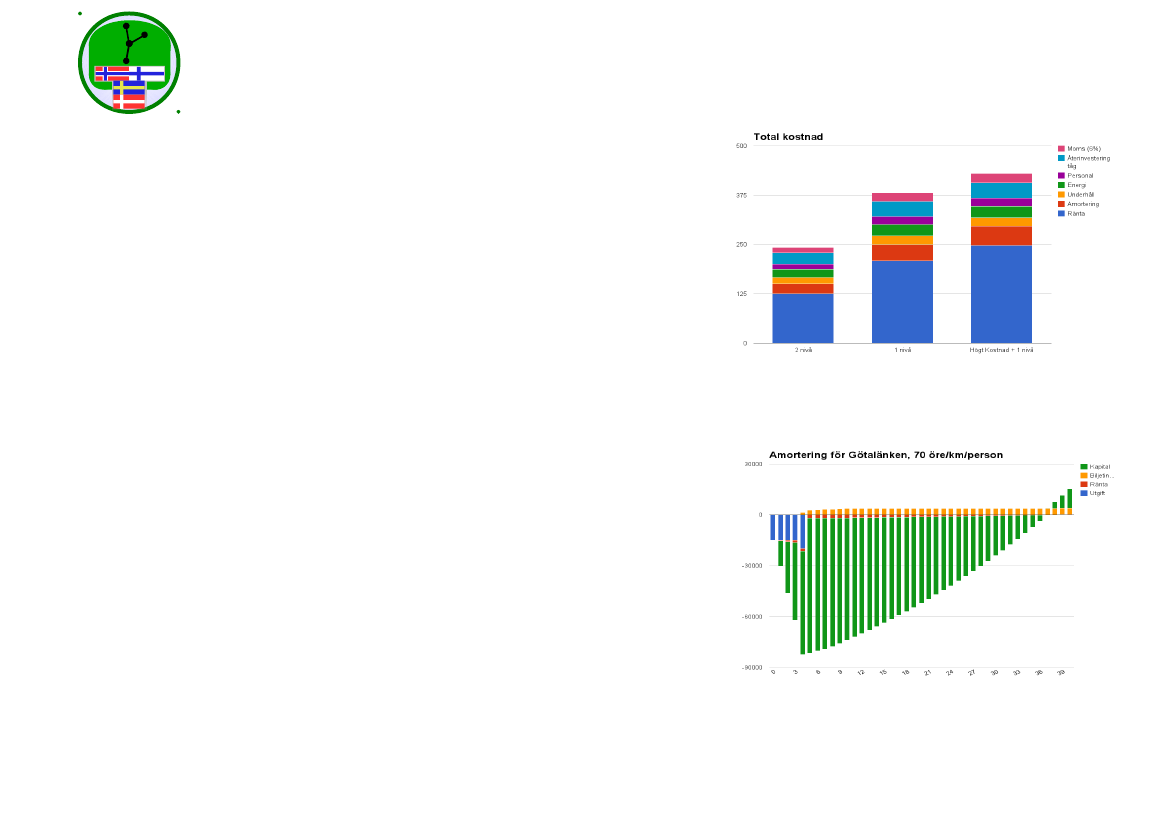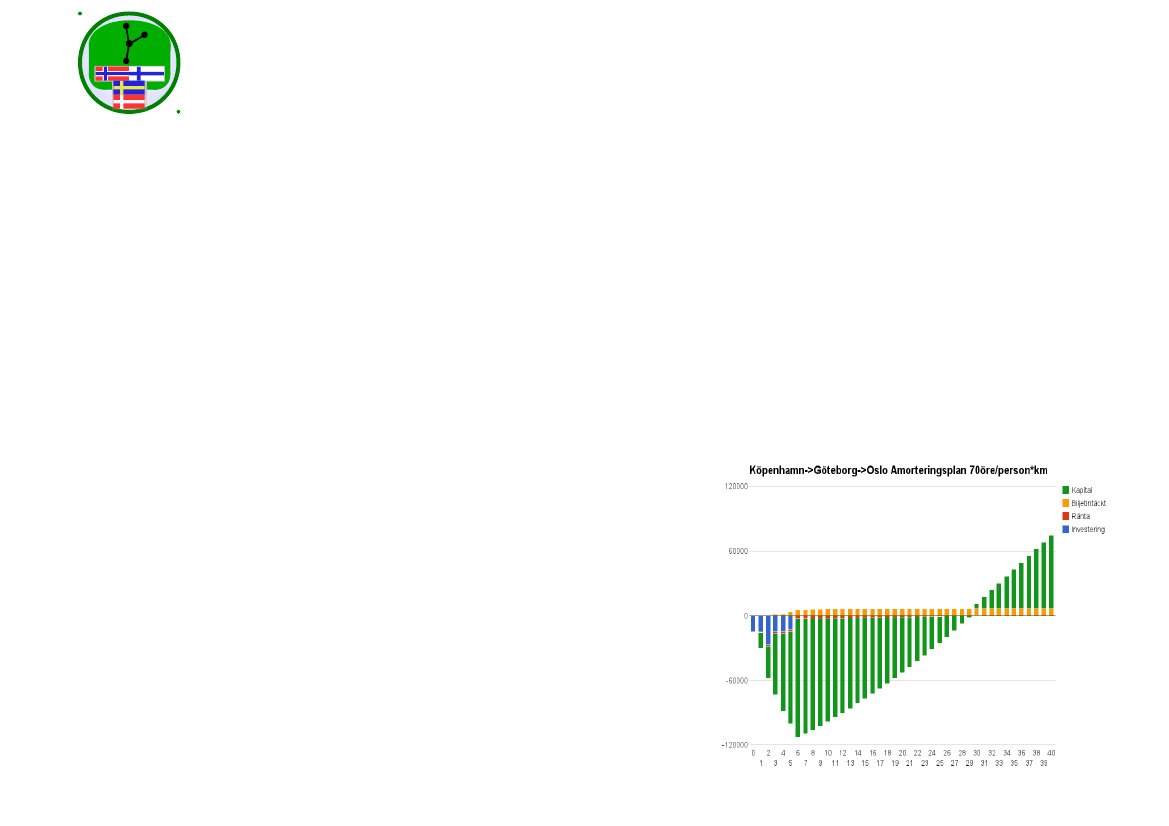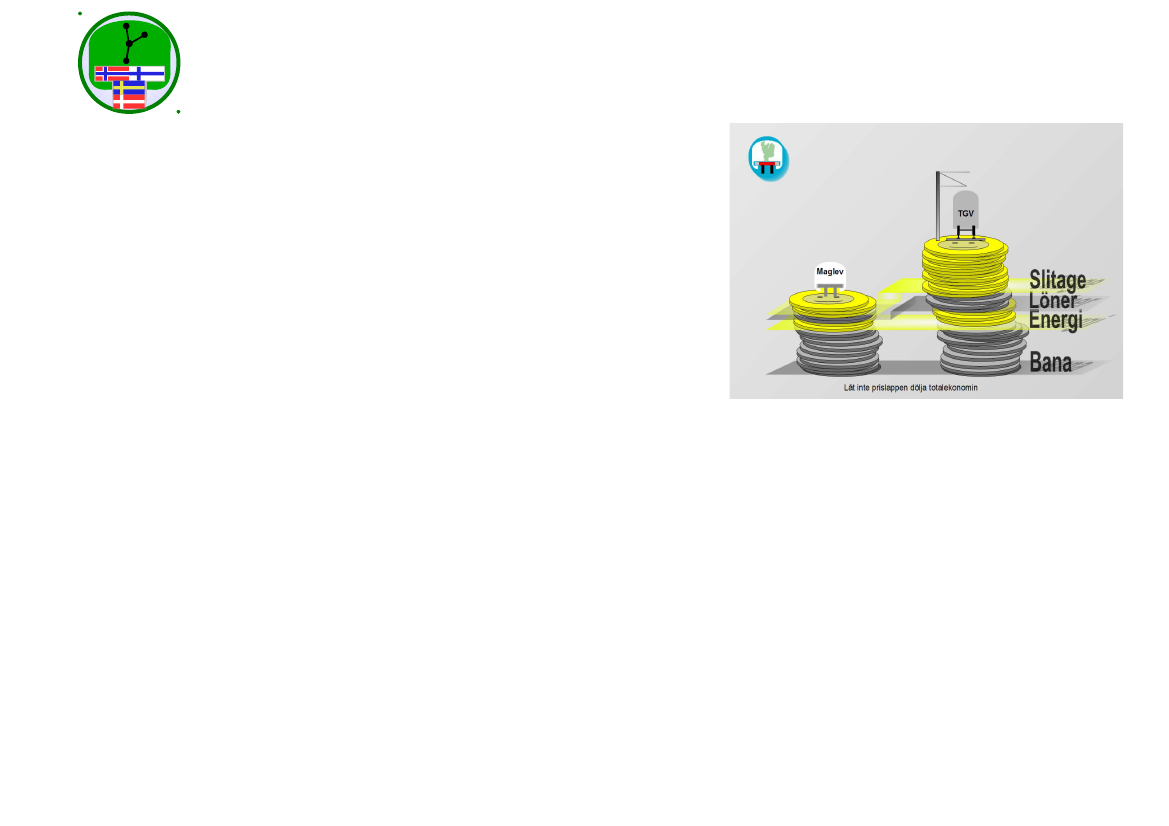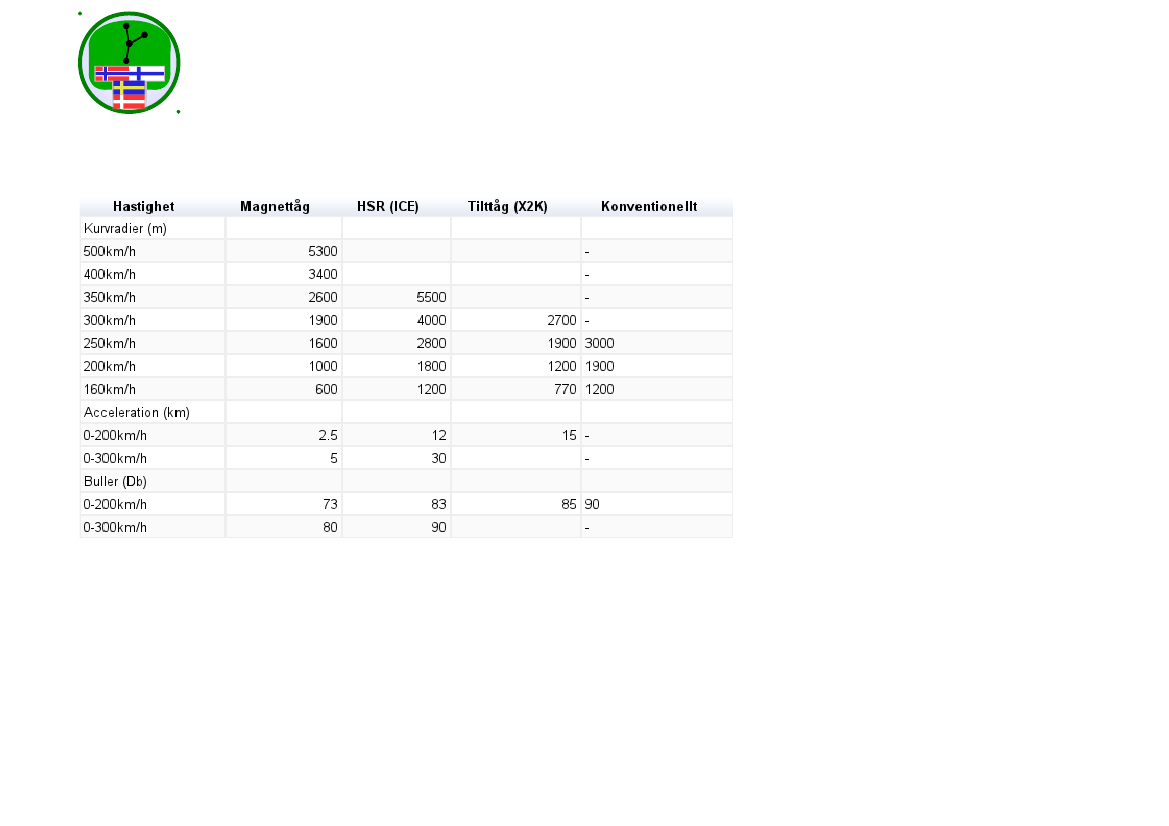Transportudvalget 2013-14
TRU Alm.del Bilag 188
Offentligt
Magnet-trains ScandinaviaStudy into magnet-trains version 1.0 2014Page 1, Chapter
Study into magnet-trains2014Mattias SvederbergAlexander BruniusMikael ThorénSpecial regards:Max BoeglTransrapidThyssenKruppMaster of Science in Electronics and Civil engineeringMaster of Science in MechanicsBachelor of civil engineering stud.Thorsten Schütte, Ph.D.Lars Abrahamsson, Post Ph.D.Rasmussen Ole, IngCarl-Åke Utterström, M.ScFredrik Larsson, M.ScÖvriga Magnettågs-gruppen
Magnet-trains ScandinaviaStudy into magnet-trains version 1.0 2014Page 2, Chapter Summary
Summary"Magnet-trains is expensive " ... This is what is usually said about the technology, but is it true? This report shows that theanswer in short is no. Today when magnet-trains traveled countless turns around the earth each year, is no longer the future, butpresent. This study describes how Magnet-trains in different stages with beginning in Sweden can be spread to the variousScandinavian countries.Countries in Scandinavia can take advantage of the technology, to develop it further, and become the world leader in bothtechnology and transport. Magnet-trains is a transport system that is better, but mainly cheaper, so that we can leave behind us acost-effective and environmentally-friendly transport systems to our children.What was once a true has for each generation magnet-trains received less and less relevance until it today not at all is the case.As for other types of traffic is plain, where running costs are relatively high compared with fixed costs is not true for magnet-trains. The lack of friction eliminates external wear dramatically reducing operating costs compared with conventional rail.A magnet train-system fits well in the sub-arctic environment in Scandinavia and offers a separated track system which iscompletely distortion-free from existing rail system. Thanks to total rail segregation so do not spread interference between thevarious rail systems. This at the same time as the elevated track reduces the risk of accidents.High speed and rapid acceleration provides short journey times even over relatively long distances. It allows a magnet train-systems compete harder with both airliners and private cars than what other systems do while the short journey time generatesnew travelers which means that magnet train-system may an unrivaled customer base to finance the course. This combined witha highly attractive system and high wages make Scandinavia very favorable for magnet-trains.There are also good opportunities for magnet-track that in the future include grid for DC voltage for medium to high voltageprobably; along track or inside the track. Through such a solution, a bearing compliment today's power grid and stabilize powergrids in the entire region.Magnet-trains is with high probability the overall economic point of view best option for future infrastructure in the region.
Magnet-trains ScandinaviaStudy into magnet-trains version 1.0 2014Page 3, Chapter Summary
InnehållsförteckningSummary...........................................................................................................................................................................................2Prefaces.............................................................................................................................................................................................9What is the magnet-trains and magnetic-tracks and why is it needed............................................................................................10Market for magnet train compared to other options.......................................................................................................................12Market for initial solutions.........................................................................................................................................................12The different systems.................................................................................................................................................................13250km/h.................................................................................................................................................................................13High Speed Track 270+km/h.................................................................................................................................................14Magnettågsystem...................................................................................................................................................................17Sweden's position.......................................................................................................................................................................19Denmark's and Norway's position.........................................................................................................................................19Passengers transferring..........................................................................................................................................................20New travelers.........................................................................................................................................................................21Suffice amount of passengers?..............................................................................................................................................21The more complete picture....................................................................................................................................................22Method and routes......................................................................................................................................................................23Olika sträckor........................................................................................................................................................................23Practical expansion................................................................................................................................................................24Express Traffic.......................................................................................................................................................................24Comparison between different primary lines........................................................................................................................26Conclusions of the passenger base........................................................................................................................................26Junctions.........................................................................................................................................................................................28Junction Landvetter....................................................................................................................................................................28Knutpunkt Jönköping.................................................................................................................................................................29Knutpunkt Trollhättan................................................................................................................................................................30Knutpunkt Linköping.................................................................................................................................................................31Conclusion magnetic train networks..........................................................................................................................................32Smaller towns........................................................................................................................................................................32More complete network.........................................................................................................................................................32Which stage should be built first...........................................................................................................................................33Further expansion..................................................................................................................................................................33Magnetic Track - How it works......................................................................................................................................................35Understanding the magnetic track parts.....................................................................................................................................35
Magnet-trains ScandinaviaStudy into magnet-trains version 1.0 2014Page 4, Chapter SummaryThe propulsion magnet..........................................................................................................................................................35Guide rail...............................................................................................................................................................................36The slide................................................................................................................................................................................36Induction power magnets......................................................................................................................................................36The guide beam.....................................................................................................................................................................37Different generations of Transrapid System...............................................................................................................................37TR06......................................................................................................................................................................................37TR07......................................................................................................................................................................................38TR08......................................................................................................................................................................................38TR09......................................................................................................................................................................................39Future Development..............................................................................................................................................................40Practical fabrication and cost.....................................................................................................................................................41Material cost..........................................................................................................................................................................41Drive system cost.......................................................................................................................................................................42Disadvantages of power drive...............................................................................................................................................42The development of inverters................................................................................................................................................43Modern technology and solution to the problem...................................................................................................................43What is the total cost of a track..................................................................................................................................................43What costs are involved.............................................................................................................................................................44Material Cost..............................................................................................................................................................................44Production costs.....................................................................................................................................................................44Cost of power distribution systems.......................................................................................................................................45Engines & Cables..................................................................................................................................................................45Assembly...............................................................................................................................................................................45Transport................................................................................................................................................................................45Rights and Legal expenses....................................................................................................................................................46What is the cost of other projects?.............................................................................................................................................46Magnetic track are cheaper....................................................................................................................................................46Different variants magnetic transport-systems...........................................................................................................................47The different types track segments........................................................................................................................................47T-shaped track........................................................................................................................................................................47U-shaped path........................................................................................................................................................................48Electronic and magnetic parts...............................................................................................................................................49EMS.......................................................................................................................................................................................49
Magnet-trains ScandinaviaStudy into magnet-trains version 1.0 2014Page 5, Chapter SummaryEDS........................................................................................................................................................................................50Indutrack................................................................................................................................................................................52Aero -Train............................................................................................................................................................................52Linear motor..........................................................................................................................................................................53Summary of the various systems...........................................................................................................................................54Other Projects.............................................................................................................................................................................55Relative cost..........................................................................................................................................................................55Next Generation - NG...........................................................................................................................................................56Real cost................................................................................................................................................................................56Trains and Traffic............................................................................................................................................................................58What separates the cars from conventional cars?..................................................................................................................58Carriages appearance.............................................................................................................................................................58Under carriage.......................................................................................................................................................................59Other parts.............................................................................................................................................................................59Magnetic trains as freight trains.................................................................................................................................................59Light goods............................................................................................................................................................................60Medium heavy goods............................................................................................................................................................61Heavy goods..........................................................................................................................................................................61Environment and Safety..................................................................................................................................................................63Accidents and injuries................................................................................................................................................................63Safety of Transrapid..............................................................................................................................................................63The accident in Lathen..........................................................................................................................................................64Consequences of the accident in Lathen...............................................................................................................................64Eschede train crash................................................................................................................................................................65Wenzhou train accident.........................................................................................................................................................65Reliability...................................................................................................................................................................................66Four levels of build track integration.........................................................................................................................................66Swedish solution....................................................................................................................................................................67Bombardier about the Swedish solution................................................................................................................................67German solution....................................................................................................................................................................67Transport Authority and the German solution.......................................................................................................................68French solution......................................................................................................................................................................68Japanese solution...................................................................................................................................................................68Proposal in Sweden...............................................................................................................................................................69
Magnet-trains ScandinaviaStudy into magnet-trains version 1.0 2014Page 6, Chapter SummaryProblems with snow..............................................................................................................................................................69Environment...............................................................................................................................................................................70Magnetic on-board the train..................................................................................................................................................70Myths.....................................................................................................................................................................................70Magnetic fields in environment.............................................................................................................................................70Barrier effect..........................................................................................................................................................................71Chemical pollution................................................................................................................................................................71Metal Contamination.............................................................................................................................................................72Acoustic pollution.................................................................................................................................................................73Pollution during construction................................................................................................................................................73Energy....................................................................................................................................................................................74Development potential for cars and systems..............................................................................................................................75Loading gauge.......................................................................................................................................................................75Changing the loading gauge..................................................................................................................................................75Voltage...................................................................................................................................................................................76Current...................................................................................................................................................................................76Effects on the grid..................................................................................................................................................................77Smart electric grid......................................................................................................................................................................78HVDC........................................................................................................................................................................................78Smart grids without additional cost.......................................................................................................................................79Design Example (Stockholm - Göteborg).......................................................................................................................................80Götalänken på djupet.............................................................................................................................................................80Fokus på Götalänk A..................................................................................................................................................................80Nyköping, Skavsta, Oxelösund eller Katrineholm................................................................................................................81Problem vid Bråviken............................................................................................................................................................81Mjölby eller Tranås................................................................................................................................................................82Förbi Jönköping.....................................................................................................................................................................82Ulricehamn, Borås och Landvetter flygplats.........................................................................................................................82Stockholm och Göteborg.......................................................................................................................................................83Olika dragningar.........................................................................................................................................................................83Färgerna.................................................................................................................................................................................83Övrig information..................................................................................................................................................................84Blå..............................................................................................................................................................................................85Från Stockholm till Bråviken................................................................................................................................................85
Magnet-trains ScandinaviaStudy into magnet-trains version 1.0 2014Page 7, Chapter SummaryÖstergötland och Tranås........................................................................................................................................................86Jönköping till Borås och Landvetter......................................................................................................................................86Grön............................................................................................................................................................................................88Stockholm till Nyköping.......................................................................................................................................................88Bråviken till Mjölby..............................................................................................................................................................88Tranås till Jönköping.............................................................................................................................................................89Jönköping och Borås.............................................................................................................................................................90Landvetter och Göteborg.......................................................................................................................................................90Röd.............................................................................................................................................................................................92Stockholm till Sörmland........................................................................................................................................................92Småland.................................................................................................................................................................................93Västergötland.........................................................................................................................................................................93Magenta......................................................................................................................................................................................95Stockholm och Sörmland......................................................................................................................................................95Östergötland...........................................................................................................................................................................95Småland.................................................................................................................................................................................96Västra Götaland.....................................................................................................................................................................96Brungul.......................................................................................................................................................................................97Jönköping..............................................................................................................................................................................97Borås......................................................................................................................................................................................97Landvetter och Göteborg.......................................................................................................................................................97Summary (Stockholm - Göteborg).............................................................................................................................................98total cost.....................................................................................................................................................................................98Travel time - Regional services.............................................................................................................................................99Travel time - Express Transport............................................................................................................................................99Which system color is best?................................................................................................................................................100Economy (Stockholm - Göteborg)................................................................................................................................................101Economics of the systems........................................................................................................................................................101Actually the ticket Gothenburg to Stockholm.....................................................................................................................102Scandinavian-X - Ticket Cost.......................................................................................................................................................102Economy (Copenhagen - Oslo)...........................................................................................................................................103Further earnings...................................................................................................................................................................104Market economy conclusion................................................................................................................................................104Other economic aspects............................................................................................................................................................105
Magnet-trains ScandinaviaStudy into magnet-trains version 1.0 2014Page 8, Chapter SummaryEconomic Impact on the system..........................................................................................................................................105Economic impact on aviation..............................................................................................................................................106Economic impact of local traffic.........................................................................................................................................106Economic conclusion...........................................................................................................................................................107Appendix.......................................................................................................................................................................................108Advantages of magnetic transport system................................................................................................................................108Airliners compared to magnetic transport...........................................................................................................................108HSR compared with magnetic trains...................................................................................................................................108Tilting trains compared to magnetic trains..........................................................................................................................112Bus, car and truck compared to maglev...............................................................................................................................112Technical comparison of different rail vehicles...................................................................................................................114Estimates of passenger base.....................................................................................................................................................115Travel-surface between two cities.......................................................................................................................................115Constants.............................................................................................................................................................................116Traveling basis between several cities.................................................................................................................................116Sources of error - Passenger Base.......................................................................................................................................116Sources of error for costing.................................................................................................................................................117Line Specification.....................................................................................................................................................................119Götalänk A...........................................................................................................................................................................119Götalänk B...........................................................................................................................................................................119Götalänk C...........................................................................................................................................................................119Götalänk D...........................................................................................................................................................................120Södralänken A.....................................................................................................................................................................120Södralänken B.....................................................................................................................................................................121Södralänken C.....................................................................................................................................................................121Södralänken D.....................................................................................................................................................................121Södralänken E......................................................................................................................................................................122Oslolänken A.......................................................................................................................................................................122Oslolänken B.......................................................................................................................................................................122Location size reference.............................................................................................................................................................124Referenser och förklaringar......................................................................................................................................................127Project map Götalänk A...........................................................................................................................................................127
Magnet-trains ScandinaviaStudy into magnet-trains version 1.0 2014Page 9, Chapter Prefaces
PrefacesThis report has been prepared as a result of the Swedish authorities, such as, the SwedishTransport Administration has shown little interest for magnet train-systems. Large amounts oflobbying money goes in to supporting the conventional route to the detriment of other optionsthat might be better. With this report, the knowledge imparted to see through these lobbyingarguments.In 2011, a collaboration with “Magnettåg i Mälardalen” with which a delegation to Transrapidand Germany were arranged on each of three members from the “Magnettåg i Mälardalen” and“Magnettåg Götaland.”The delegation was invited by Thyssenkrupp AG and Max Boegl GmbH to enter test facility inEmsland Test Facility in Lathen respective rail segment factory in Neumark. The delegation wasthe first from Sweden to officially revisit the facility, and then it was closed permanently a fewmonths later, so even the last and only.No delegation from neither the Swedish Transport Administration and “Banverket” has evervisited the Transrapid, and now when the test facility is now more closed down they will neverdo.
Picture 1: This study is written to the knowledge thatThis study is written to the knowledge that actually are about magnet-trains in Sweden should beactually are about Swedish magnet-train delegationdisseminated and once and for all put an end to the myths surrounding the transportation system.together with representative from Transrapid (far right)and a TR09 maglev (background)Transrapid has been in Germany nearly 1 million kilometers of experience and another 5½million kilometers in China, representing over 100 laps around the equator. A large part of the distance over 400km/h Which isa longer distance than any other terrestrial transportation systems together over 400km/h In total about 30 million payingpassengers traveling in China and another half million in Germany. A large majority of 400km/h Besides magnet-trains has nopaying passengers traveling in the speed of a ground-based transport systems.Magnet-trains Scandinavia is a broad Swedish and Nordic independent non-profit organization consisting of a large number ofexperts from various disciplines who deserve a big thank you to assist to this report.A big thanks to everyone who helped, mainly, we want to thank “Magnettåg i Mälardalen” who helped with contacts forTransrapid, Thyssenkrupp and Max Boegl and all within Magnettåg Götaland who helped to support the development. Thereare also a large number of smaller support organizations that have helped to spread the knowledge and deserves regards.
Magnet-trains ScandinaviaStudy into magnet-trains version 1.0 2014Page 10, Chapter What is the magnet-trains and magnetic-tracks and why is it needed
What is the magnet-trains and magnetic-tracks and why is it neededMagnetic-tracks and magnetic-trains are a complete transportation system that can be compared with the aviation industry, therail industry or shipping. Just as the railroad, the magnetic-track system a rail-based system and parables in the rail industry arecommon. However, it is important to know that just as the tram system, subway system and other rail-based system ismagnetic-track system completely separate from traditional rail. From some aspects, is a magnetic-transport system moresimilar to the airline industry than the rail industry.When rail systems are discussed in Sweden and the other Nordic countries are often mentioned X2000 (now SJ2000) or theNordic equivalent as an example. Such a comparison is dangerous if not erroneous when the X2000 is not a transport, but onlya train. X2000 running on ordinary track, which is precisely the point of the train.A better example of a transport system is the Japanese Shinkansen that has a custom made track specially designed for highspeed trains. Shinkansen Line is custom built to the degree that ordinary trains can not run on it, mainly because of the track butalso with regard to a number of other details. TGV and ICE are examples of hybrid systems where they are partially divorcedbut also partially compatible. This type of train can run on conventional rails, often at reduced speed and with increased wear.Ordinary trains can not normally run on the ICE or TGV lines due to heavy dosage of curves which can have conventionaltrains rolling over.Magnet-trains is, as the word suggests, a train with several carriages, lifted and propelled by magnetic fields. The train has nowheels, no engine, no suspension or other mechanical components for propulsion. The carriages are beyond details in the cabin,no moving parts at all. In addition to moving parts missing is the train during normal operation no physical contact with thetrack. This allows both wear and energy costs are very low compared to other transport systems.Magnetic tracks is the system which controls and propels the trains forward. It basically consists of only two components. Asupporting structure (concrete or other cost-effective material) and a driving magnet (aluminum or copper). All electrical andelectronic components are stationed next to the track at regular intervals. Magnet-train systems is a combination of magnetictrack and a number of magnetic-trains. The system also includes stations, control centers, depots and other operationalcomponents.A major advantage of a magnetic-train system is the low operating cost, which is usually only a fraction compared to othersystems, even when compared to systems with much lower performance. Historically, magnetic-train system have been costlyto build, but the development of both electronic and structural engineering has resulted in the construction cost today iscompetitive and in some cases even lower than competing technologies. The low operating costs will benefit Scandinavia foryears as transport and a base for smart grids.The performance of the magnetic-trains is good and unmatched by other land-based transport. Through a combination of high
Magnet-trains ScandinaviaStudy into magnet-trains version 1.0 2014Page 11, Chapter What is the magnet-trains and magnetic-tracks and why is it neededacceleration and good top speed is the actual transport times often close to half that of the best competitor. Even compared toair, mainly regional flights, the performance is good and often exceed the gate-to-gate travel time for distances over 1,000 km.
Magnet-trains ScandinaviaStudy into magnet-trains version 1.0 2014Page 12, Chapter Market for magnet train compared to other options
Market for magnet train compared to other optionsIn Scandinavia, there are currently no magnet train or another solution for high-speed transport. Scandinavia has historicallycombined fast and slow trains on the same track, which is often justified by the low passenger numbers. In short, goods andpassengers-trains side-by-side paying back the investments of the rails, which can make the infrastructure more cost effective.The solution is not without drawbacks. Mixed fast and slow trains so need leeway increased. Instead of the usual 3 to 5 minutesrequired on many routes intervals up to 15 minutes between a fast and a slow train. This is without counting the time it takes forthe train to pass, which for a freight train is significant.During the time when the system was built it was considered that this will not be a problem. The systems were built becauseridership was small, but as the trains became faster passenger numbers increased while the number of trains that could fit on therails fell. This has led to a crisis on the railways today where delay spread like wildfire since each train take more space on therails.Scandinavia is often regarded as sparsely populated, which compared to many Central European countries is true. This view hasoften colored transport policy in respect of rail transport. Instead of, as most Central European countries, build separate trackfor freight and passengers alternatively three or four-track systems and you have in the area usually combined freight andpassenger traffic on single or double track trails. Most rail systems are landscaped in the 1800s and then updated during the mid1900s after the needs that existed then.Besides the population has grown considerably since that period have different interests, including environmental concerns,increased pressure on public transport, notably rail mounted such. Meanwhile, the amount of goods transported increasedsignificantly over the same period. Overall, the region entirely outgrown today's railway system, and in some more denselypopulated areas is the need for more capacity today is huge.This can be contrasted with air traffic, where there is a desire to reduce air traffic in the region. Partly because of that particularenvironment, but also because of transport capacity. Regional aircraft are often smaller than others and therefore requirerelatively to the number of passengers more space at airports. Space that could otherwise be used to greater and more efficientaircraft for long-haul routes.Magnet trains itself has very good transport and also in the very busiest parts of Scandinavia capacity to almost completelyabsorb passengers from both flights and existing railways, and still have good capacity of expanding traffic.
Market for initial solutionsThe question now is whether the market is still too small in Scandinavia have separate tracks for freight and passengers. To that
Magnet-trains ScandinaviaStudy into magnet-trains version 1.0 2014Page 13, Chapter Market for magnet train compared to other optionsquestion there is no clear answer. What answer you get when you ask the experts often reflects their desire to build a new railline than actually applies in reality.Draught study has been made in the area and the result is still that the question can not be answered. The reason is thatuncertainties as increased traffic and shorter travel times can not be accurately predicted. Scientists disagree, but many believethat profitability can not be achieved without social economic effects in count. As the population and economy evolves, such asolution is likely to be profitable sometime in the future, maybe 20 years, maybe in 50 years.Research in this area tend to unambiguously interpret the economic situation for the traditional "steel-on-steel" rail, and rarely,if ever, given the different economic situation for magnet train-system.
The different systemsThere are a number of different solutions for rail, high-speed transportation systems. The systems are referred to here as<250km/h, 270+ km/h and magnet train-system. <250km/h is represented among others by the Swedish and Italian to t-trainsystems such as the X2000 and Pendalino. But even the hybrid system so that German ICX and the Chinese medium speedtrains include developed by Bombardier (formerly ABB) in Västerås.
250km/hWhen extending the new capacity which today is extreme in Sweden has three systems mentioned: 250km/h mixed traffic withGreen Train developed in collaboration between Bombardier and KTH. This solution is the one that was selected when the“Botniabanan” was built a few years ago.The solution is practically a continuation of the systems we already have in Sweden. Continued mixed traffic but with morespeed, 250km/h instead of 200km/h This also means that the capacity is further reduced due to increased leeway. The problemhas been countered by building trains are wider and have a shorter distance between the chairs. By using multiple units andshort leash, and the denser chair placement can fit more passengers, but it still means that departures need to be sparse.The solution is often described by the proponents of mixed traffic, as a cheap alternative. Today there is only a single path ofthis type in the world - “Botniabanan” - even then it was opened it was found that the low capacity was a major problem. Thetraffic became too sparse and capacity too low. “Botniabanan” uses only a single track, but when the need in southern Swedenis more than double the area around “Botniabanan” is it reasonable to assume that similar problems if not worse, would hit atracks in southern Sweden.The smaller kurvradierna often described this technology advantage. This, however, with the disadvantage that the path doesnot pass as high pitch. The climb is only 1-1.5% compared to 3.5-4% for the high-speed tracks and 10% for the magnetic path.This means that it requires significantly more bridges and tunnels. In addition, results the higher speed on 250km/hi to curve
Magnet-trains ScandinaviaStudy into magnet-trains version 1.0 2014Page 14, Chapter Market for magnet train compared to other optionsradius is noticeably larger than the X2000 in 200km / h as already tilting.In China, even 250km/h train as a compromise between high speed and lower operating costs on many routes with less prestigebut also as an appropriate speed for fast night train. In Germany, Deutsche Bahn looking at in the future to adapt its railwaysprimarily to 250km/h or lower to reduce operating costs, and only maintain a top speed of 300km/h on a small number of routeswith very high passenger base.
High Speed Track 270+km/hHigher top speed is achieved by building dedicated track for high speed trains, known as High Speed Rail (HSR). A commonmisconception is that high speed rail is identical to conventional rails except for the curve radius. In fact, there are severaldifferences and all HSR system is also not identical, which means that any differences are not relevant to all types of HSR* Large doses of curves* Flatter vertical curves* Other switches that allow for higher speed* Harder tensioned power lines* Higher voltage in the power line (25kV instead of 15kV) (some countries)* Other frequency 50Hz instead of 16 2/3Hz. (some countries)* Smaller tolerances between the rails* Flatter slope between the railsOften described erroneously that ordinary trains can run on HSR. This is not correct for the simple reason that high-speed railhas lower weight distribution and other trains will simply roll over if they must preform an emergency stop in a curve. Thus,one can never run heavy loads on a high speed track. In France, drive light goods, packages and mail on high-speed lines(LGV) in a converted passenger trains. The problem with this solution is that you are limited to around 12ton per wagon. Theadvantage is that you can run just as fast with the train as other, and thus do not interfere with traffic.One of the advantages that HSR often alleged to be compared with the magnetic tracks is that trains can run on standard rails.However, there are numerous problems with this solution:* Significantly greater wear on wheel and rail due rail-angle* Significantly greater wear on the pantograph and electricity because of the greater pressure against the power line
Magnet-trains ScandinaviaStudy into magnet-trains version 1.0 2014Page 15, Chapter Market for magnet train compared to other options* No additional new capacity will be added, making the original problem persists* The speed must be limited at the track, increasing travel times.Swedish Transport Administration argues in his report to high-speed rail has very great potential for future development. It ismentioned, for example, that people started to run for 210km/h later in the 270km / h and driving 320km/h on the same linestoday. In addition, many courses are designed for 350km/h Let's look a little closer at the realities.1964 - Japanese Shinkansen introduced at 210km / h The train was tested, however, on the same path already years earlier in256km/h1971-1971 - Japan introduces and tests the trains on the same track at up to 319km / h Even today run only 300km/hcommercial on the same tracks .1981 - France introduces TGV at 270km/h, but had already before the introduction test driving the train in 380km / h on a trackfor just that purpose. It is this path that the Swedish Transport Administration claims to have increased the speed at while todaydriving 320km/h The fact is that in 1981 drove much faster than that.1988 - Rebuilt in older TGV on to 300km/h In so doing, test the trains in 408km/h1988 - Introduced the second generation TGV traffic in the 300km/h This train is tested in 1990 in 515km/h, engines unitshared with carts that were introduced in 1994 to run for 320km / h1989 - 1991 - ICE introduced in Germany with a top speed of 280km/h, but it was tested at 400km / h2000 - ICE3 launched in Germany with a top speed of 320km/h, but was tested both before and after the higher speeds. DB hassubsequently decided not to buy more trains for this speed due to high operating costs2005 - Introduced the 3rd generation TGV train with a top speed of 320km / h This in combination with prototype componentswere used in 2007 to build four locomotives, of which 2 were duplex carriages where the locomotive was on the floor and testequipment and journalists held at upstairs, to test the train 578km/h2010 - CHR380AL and CHR380BL tested both over 480km / h Both were planned to be introduced on a commercial speed of380km / h ( hence the name ), but this was reduced to 350km / h before the introduction because of problems with highoperating costs. This was further reduced at all distances to 300km / h , again because of high operating costs.It may be surprising that the TGV Duplex, a double-decker, was the first train to run at 320km/h, which is currently the topspeed which with a few exceptions. The reason for this is that in a double-decker get the maximum number of passengers withminimal train. Building an extra floor affects the weight slightly, but the capacity significantly. In practice it means that you can
Magnet-trains ScandinaviaStudy into magnet-trains version 1.0 2014Page 16, Chapter Market for magnet train compared to other optionscarry 45% more passengers with similar operating costs.It may be surprising that the TGV Duplex, a double-decker, was the first train to run at320km/h, which is currently the top speed which with a few exceptions. The reason for this isthat in a double-decker get the maximum number of passengers with minimal train. Building anextra floor affects the weight slightly, but the capacity significantly. In practice it means thatyou can carry 45% more passengers with similar operating costs.It has never existed any conventional trains have transported paying passengers over 350km/hThis compares with three magnetic tracks which carried paying passengers at speeds of over430km/h (Emsland Test track from 1986 to 2006, Yamanashi test track, from 1995 to 2012,andresumed in 2014, Shanghai magnetic train, 2004-)The financial problems turns out to be the biggest obstacles to drive faster than 320km/h today.On the market today there are four different train manufacturers who market train for over320km/h, but in practice they are used only occasionally in prestige distances, and then rarelymore than a few minutes at speeds of over 320km/hThere are no technical barriers to increasing the speed further. Acceleration is the biggestobstacle. At low speed limits the friction acceleration. At high speeds, limit the engine powerspeed. Can you increase the power of the engine? In short, no. The last trains introduced drawsso much electricity from the wires as it goes. Raising the voltage and the utility line can not bedone with anything but extensive changes throughout the system. Record in France wasperformed with only five cars, of which three passengers ones could, instead of the normal 20.Additionally, the need for power quadratically with speed. Therefore needed 40% more poweror lower weight to accelerate from 300km / h to 400km / h as fast as 200km / h to 300km / hOne problem is that higher speed and impact means for stronger motors and wheels, which inturn more weigh. There comes a point where all factors impede the increased speed.Germany has been working on a project to reduce the problems. By combining the double-Picture 2: Typical railway for an HSR-track systemdecker, with Jacob-bogies, multiple-unit principle and single axle bogies, they will use allavailable technologies to maximize passenger numbers and minimize weight. This results in that it contained 20% morepassengers and a weight reduction of around 30%. This means that in practice can increase the top speed to 400km/h Oneproblem is that you have to halve the weight of the motors and reduce the weight of the wagons (no axles) from 18ton around8ton, something that is likely to be problematic.In short 400km/h is a goal far ahead will likely be difficult to achieve. And even if it is achieved, it provides limited benefit
Magnet-trains ScandinaviaStudy into magnet-trains version 1.0 2014Page 17, Chapter Market for magnet train compared to other optionsunder Swedish conditions.What surprises many is how incredibly wide trail corridors are. For high-speed tracks, it is not uncommon to have widths of upto 30 meters, which form a barrier in the landscape. This affects both animals and humans, but also construction cost negative.It often surprises the magnetic track with elevated guideway can cost as much as, or less than high-speed tracks. The magnetictracks costing less is not because they are cheap, but high-speed tracks simply are very costly to build.See picture 2.Roadbed for HSR is 8 feet wide at the top and 16 feet wide at the bottom and 2 feet thick. Therefore required around 40 tons ofcrushed rock per meter built track. Also needed to bridges, viaducts, aqueducts and other structures to avoid obstacles in thelandscape.
MagnettågsystemThere is a single lane in the world where you regularly run commercial operation over 350km/hIt is available in Shanghai and run in 431km/h The reason that you can not drive faster than that,neither the technical or commercial , but for the simple reason that the distance is so short that431km/h happens to be an optimal top speed.Modern magnet train-systems is completely noncontact. This means that there is no externalwear on either track or trains. In practice this means that the velocity does not affect the cost ofoperation other than for electricity consumption. Electricity consumption is also at 500km/h isquite low. It may be mentioned that the course in Shanghai is an older model that uses a slidingshoe for supplying the train with power. This component wear, yet operating costs almostnegligible.There are currently two suppliers who market solenoid track and train speeds. JR in Japan andTransrapid in Germany. The two systems operate under completely different methods. TheJapanese system has the advantage that trains are more aerodynamic and lighter, but has lowercapacity. The top speed and acceleration is probably slightly better. The tunnels can be drilled inthe smaller dimension. The major drawback is that the system is very expensive: about twice asexpensive high-speed tracks.The German system is much cheaper and runs already being exploited commercially. Costs ofconstructing path with Transrapids system is comparable or better than the high-speed tracks.Total cost for maintenance is 1/3 compared to the speed of 250km/h Energy consumption is ~Picture 3: Magnetic train-system type TR09 fromGermany
Magnet-trains ScandinaviaStudy into magnet-trains version 1.0 2014Page 18, Chapter Market for magnet train compared to other options30% lower than the corresponding rate for HSR, Transrapid has slightly lower capacity than JR-maglev has 10 cars instead of14 at 500km/h, however the carriages are slightly wider.For the Scandinavian market seems therefore Transrapids system to be most beneficial. This report deals with all the differencesbetween the various magnetic train-system according to manufacturer's specifications.The advertised top speed of Transrapids system is 505km / h The system is tested to 501km/h The reason that you have nottested the train faster, the reason is simply that you do not have a runway designed for this. The system, currently out is calledTR09 and has a number of improvements over TR08-Shanghai used in China.By comparison, it allows for a Transrapid TR09 to accelerate to 500km/h than a ICE3 or TGV Duplex to accelerate to 320km/hThe energy consumption at 500km/h is additionally rather high speed at 320km/h In practice there is no reason to run slowerthan 500km/h on the surface is good and the distance allows. TR09 can run in this speed range is already under 30 kilometers.Moreover, since the engine is in the track rather than in the train weight is saved, while one can increase efficacy withoutaffecting the weight of the train. The current system has a limit of 500km/h with 10 wagons. These carts are considerably largerthan those used in high-speed track, which means that they correspond to 16 wagons. This is what most high-speed systemmaximum handling. (TGV handles up to 20 cars but these are even smaller). Use fewer carts can increase the top speed evenfurther. Estimated maximum speed with today's system is just over 700km/h Future systems can increase this rate further. Howhigh economic top speed can be difficult to answer. But then only increases power consumption at higher speeds meanestimated an increase from 500km/h to 700km/h increase energy consumption by 30-40wh/person/km, which for Gothenburg toStockholm, equivalent to about 10 crowns (Swedish) higher cost to passengers.Transrapids runway capable of dispensing up to 21% and declines in slopes of up to 10%. This compares with the highway overHallandsås leaning 6%. In practice, no tunnel to be necessary with magnetic tracks. Curve radius varies from a few hundredmeters up to 4000 meters and curve radius is less for any given speed than all other existing high-speed rail systems.Vehicles may unload cargo in standard design of 16 ton, which is similar to what the TGV can handle when the wagons arelarger. This capacity can be increased to 20 tons, by removing chairs, windows and other peripherals. The track handling over150 tons of cargo per section.These systems are commercially available today
Magnet-trains ScandinaviaStudy into magnet-trains version 1.0 2014Page 19, Chapter Market for magnet train compared to other options
Sweden's positionOften described Sweden as sparsely populated but south of Stockholm, Sweden is similar to many other European countries.Sweden's population center is additionally located in regions and major cities in line between these regions. BetweenStockholm and Gothenburg, for example, five of Sweden's 20 largest cities. Between Gothenburg and Malmö are 3 of Sweden's20 largest cities. Between Stockholm and Oslo is also where three of Sweden's 20 largest cities. Sweden is on average verysparsely populated, but on these routes is Sweden comparable to many other countries in Europe. For example, correspondingto the ICE line 25 from Hamburg to Munich via Hannover at around 770 km and main town 'spopulation of 4.5 million people, compared to Stockholm to Copenhagen via Gothenburg around680km and the seat 's population of 4 million people.Cost State is internationally high in Sweden, travel is no exception.By using population and travel patterns of Swedes on existing as well as methods for transferringand new traveling relative to the travel time can be calculated how many passengers who will travelon each leg. Number of travelers on key routes Stockholm to Gothenburg and Stockholm to Malmöfor traveling by plane, train, bus and car are used as reference lists. The figures normalized ago bypopulation and travel time.
Denmark's and Norway's positionDenmark and Norway have not been analyzed at the same level of detail as Sweden, however, therehave been a fundamental analysis in these countries.While Denmark has a relatively high population density, there is a large part of the population in theCopenhagen neighborhood. Today, the traffic between Själland and Fyn fairly good, while the largertowns in northern Jylland has relatively long transport times of low capacity to Själland. A directlink between Copenhagen and Aarhus via the island of Samsoe provide great economicopportunities, then even the exalted character of the magnetic path provides a favorable economicscourses over shallow water. The high population density in Denmark makes further local magneticpaths favorable when technology does not create any barrier effects (See page 35).Forecast Estimates provided shows that position with only one connection between Jutland andCopenhagen is uncertain, but when such a transport link combined with a link between Copenhagenand Oslo, they bring over moving passengers from Jutland to Oslo and intermediate Swedish cities,Figure 1: Illustration of a magnet train-system can bea greater amount of passengers enough to do improves the prognosis. Majority of the transferredexpanded symbiotic in Scandinaviapassengers from flights and car (via ferry) combined with increased travel through shorter journey
Magnet-trains ScandinaviaStudy into magnet-trains version 1.0 2014Page 20, Chapter Market for magnet train compared to other optionstimes.For Norway, the only transportation to Copenhagen/Gothenburg and direct to Stockholm calculated. Oslo has in the region, themost favorable position in terms of generating passenger base overall, and relative standing only Gothenburg better with itscentral location between the three capitals. Calculations for passenger base west and north of Oslo has not been performed, butis believed to be good, as there are a number of localities with large population. The mountainous landscape in Norway doesnot preclude magnet train-sytems when they manage to climb steep stretches and bridge the great depths without any additionalcost. This gives magent train-system a great advantage over conventional rail where many tunnels need to be drilled for servicein Norway.Finland has been analyzed only in broad terms.
Passengers transferringGöteborg- Stockholm train has today the largest market share of public transport. With around 2million passengers dominate the train over flying 1.2 million passengers. Private cars carryingmore than 2 million passengers on the same route. On the stretch Skåne region - Stockholmsituation is reversed, where the carrying aviation about twice as much passenger train , whileeven private cars are significantly less. Southern mainline filled instead up primarily of travelingto and from the region of Östergötland and traveling by change over in region of Småland fortravel after the course.Göteborg- Stockholm is already quite close to the point where a train completely dominate overair traffic. For Skåne and Stockholm the situation is different. Travel time needs more thanhalved to air traffic entirely be transferred to rail. This makes a very big difference as RegionSkåne together with Copenhagen only in air traffic turnover of almost as much as theGothenburg - Stockholm total makes by train and fly together. This makes travel on the routeSkåne Stockholm who transferred from other modes of transport, especially aviation, to apotential cash cow.In the rest of southern so is domestic air very limited. Only Blekinge, via Ronneby airport hasany air traffic to speak of, but even there the traffic is quite limited. How charter affected by thefaster transport between cities and airports is very difficult to determine. There are greatopportunities to charter companies choose to centralize their departures from airports with directtrain in the future, such Landvetter and Skavsta. For example, air travelers can check in directlyFigure 2: Passenger Over Relocation at a distancecorresponding Skåne - Stockholm for HSR.Blue: Original passengers, Red: Former motorists,Yellow: Former air travelers, Green: New population,Violet: New passages due to shorter travel time
Magnet-trains ScandinaviaStudy into magnet-trains version 1.0 2014Page 21, Chapter Market for magnet train compared to other optionsat the train. Exactly how this will affect the train services is very difficult to predict and thereforewill also be omitted.These calculations have been performed from a southern Sweden perspective but should beproperly aligned with the situation in Denmark, South Finland, and to a lesser extent also southernNorway.
New travelersNew traveling to come in a variety of categories such as increased travel through growth, increasedpopulation and other factors.The largest share, new traveling embarrassed, however, by the shorter travel time. People whopreviously did not travel at all, or not as often, start traveling more regularly afterwards as traveltime decreases. Shorter travel time makes it possible to travel across the day rather than making theFigure 3: Passenger Relocation at a distancecorresponding Skåne - Stockholm for magnetic train.trip for several days.Blue: Original passengers, Red: Former motorists,The higher capacity dedicated tracks actually make that ticket prices will be stable and higherYellow: Former air travelers, Green: New population,availability. Instead of booking tickets weeks in advance would like county traffic ticket purchasevia SMS. It becomes possible to spontaneous desired.
Suffice amount of passengers?The most common argument against the transportation system dedicated to passengers in Sweden isthat they are too few passengers or a too small population. Sweden, for example, lower populationdensity than France and Germany.If we look at Spain, the country that most resembles Götaland and southern Scandinavia is so verytrue population is bigger, but the distances are also relatively large. If Götaland vicinity would havehad just as many dedicated transport system by Spain relative to its population, so had a system likethis has already been built. The economic reality is also more favorable in Sweden.Figures 2 and 3 shows an approximation of how the passengers to move across. Even for HSR so,the current rail passengers just under 30 % of the total number of travelers. The model is calculatedusing a combination of the removal under Transport's the model is as normalized for the higherFigure 4: “Magnet-trains Scandinavia numerically fittedspeeds, and a model for the traveler as magnet train Götaland model. The largest increase comesmodel here shown for the average speed of 280km / hfrom aviation, but also a noticeable increase comes from the private car. The slightly shorter traveltime also attracts a number of travelers. The number of new travelers who are attracted not only by train but also from motorists
Magnet-trains ScandinaviaStudy into magnet-trains version 1.0 2014Page 22, Chapter Market for magnet train compared to other optionsand air travelers. Whereby only a moderate increase in overall travel gives a rather large effect. For magnet trains represents theoriginal travelers only meager 15%. More motorists choose the train, but air traffic contributes the most. The certainty ofnumber of passengers numbers over relocating from air travle is in this case very high. It has proved all times something similarhas been built when the travel time for trains drops below 2 hours triggered an avalanche effect on the clientele of aviation.Fewer traveling results in higher price and fewer frequencies, which in turn leads to fewer passengers. When the travel time forcompeting modes reaches 2 hours, air travel simply can not afford to compete and all previous air travelers are forced simply totake the train. The reduced travel time also attracts former air travelers and motorists to travel more often.
The more complete pictureTo calculate the number of passengers from point A to point B under given conditions can bedone with fairly good security but the great advantage of trains is that trains can stop atintermediate stations .For example, between Gothenburg and Malmö raises a number of people, but if the train alsostops in Helsingborg, where travelers can not only travel between Malmö and Helsingborg , butalso between Helsingborg and Gothenburg. The possibilities becomes 3 instead 1. If the trainstops additionally Halmstad its chances 6. If the train also stops in Varberg, then they get 10opportunities. The complexity is further increased because the travel time for someone fromHalmstad to Gothenburg is shorter than from Malmö , allowing residents tend to travel moreoften.Car traffic competes harder on shorter trips because it takes time to get to and from the train.Traveling between Halmstad and Varberg , for example, prefer to take the car than travelingbetween Malmö and Gothenburg.
By treating every single trip on a train service as a journey from A to B and count on everydistance may be using the same method as mentioned earlier, figure out how many passengers asa rail line gets. However, the problem arises that the number of trips will be extremely large. For a line with X stop will be thenumber of trips from A to B:(X−X)=Numberof trip combinations2For a line with 10 stations generated the 45 travel opportunities. All these need to be calculated with respect to distance, time,will to travel, aerospace and competition from cars. This requires computer calculations.2
Figure 5: The same image as Figure 3, but normalized toa distance of 600km and variable speed. Blue: Train, Red:Air Travel, Yellow: Private Car
Magnet-trains ScandinaviaStudy into magnet-trains version 1.0 2014Page 23, Chapter Market for magnet train compared to other options
Method and routesBy dividing each train line in a number of travel from point to point , the number of passengers on each route are summed . Thecalculations are done in the following way.1: Stations selected and the spacing between them is calculated.2: The distance between each station is calculated in time by the train's performance. Top speed plays a big role, but at shortdistances plays acceleration even greater role . At very short distances as Gothenburg -Landvetter where neither a maglev orhigh-speed train reaches a top speed of acceleration all that matters . On the route divides time between the two even more thanat longer distances.3: All times and distances are summarized in the respective matrix where all the travel opportunities are included.4: The number of passengers on each route is calculated by comparing cities' size and the time that the journey time which isnormalized by a factor to get the actual number of travelers.5: Each trip is then multiplied by the length beyond which all trips are summed up and divided by the total web length. Theresult of this represents how many people go on the track relative to pave length. Number of passenger kilometers for everykilometer built track. This is the data of the traveling surface.After all this is done, the program is advanced by the number of trips to known points , in this case Gothenburg - Stockholmand Skåne and Stockholm. First, to calculate the normalization factor, and then to verify that this fits how passengers react tojourney times.Only international relevant parts will be translated of the folwing chapters.
Olika sträckorIstället för att i ett tidigt skede, Projekt Europakorridoren, Trafikverket eller Banverket bestämma sig för en specifik sträcka såhar vi valt att skissa upp ett stort antal sträckningar och göra beräkningar på samtliga, för att få ett så stort underlag sommöjligt.Följande sträckor har valts att beräknasGötalänk A: Göteborg-Stockholm via Jönköping
Magnet-trains ScandinaviaStudy into magnet-trains version 1.0 2014Page 24, Chapter Market for magnet train compared to other optionsGötalänk B: Göteborg-Stockholm via Eskilstuna och TrollhättanGötalänk C: Göteborg-Stockholm via Västerås och TrollhättanGötalänk D: Göteborg-Stockholm via Västerås och LidköpingSöderlänken A: Malmö-Göteborg via KungsbackaSöderänken B: Köpenhamn-Göteborg via Landvetter (för att samverka med Götalänk A)Söderlänken C: Jönköping-Köpenhamn via HelsingborgSöderlänken D: Jönköping-Malmö via VäxjöSöderlänken E: Linköping-Malmö via KalmarOslolänk A: Göteborg-Oslo via Trollhättan (för samverkan med Götalänk B eller C)Oslolänk B: Stockholm-Oslo via Västerås (för samverkan med Götalänk C eller D)
Practical expansionThe expansion is thought to occur in four stages. Primary select the preliminary example Gothenburg -Malmö, to start serviceson. In step 2, extended distance, eg to Oslo. In step 3, branched stretch of like a tree, and finally in Step 4 build furtherinterconnected branches to create a network.When everything is done by computer calculation , it is easy to convert to different types of traffic or vehicles. All calculationsare done, therefore, not only with magnet trains, but also with high-speed 320km/h (HSR320) and Green train, with a top speedof 250km/h and tilting. The figure shows the estimated number of passengers in one month pay for every given kilometers oftrack.Gota Link A is calculated at several different ways to show how the number of stations affects the number of passengers. Thefewer stations, the faster the train will arrive, but also the fewer passengers have the option to go with .
Express TrafficTo clarify the effect of travel time gives the number of travelers so have three examples simulated.Gota Link A: Normal distribution with 10 stations, eight intermediateExpress comination: Every two train stops at three intermediate stations, every other stop at all.Express 2 combination: Every two trains running directly, every two stops at all intermediate stations.
Magnet-trains ScandinaviaStudy into magnet-trains version 1.0 2014Page 25, Chapter Market for magnet train compared to other optionsClearly an Express 2 provides much greater traveling supplements than the first. It also providesuniform load between express and other trains. One drawback is that travelers from Skavsta toGothenburg Landvetter to Stockholm may go significantly longer than the time it takes to goStockholm to Gothenburg. But then reasonably most travel to the closest airport, it should be aminor problem. Interestingly, the magnet trains is benefiting the most from the use of expresstraffic. Which in itself is perhaps not so surprising given that the travel time then becomesincredibly short at just under an hour.An express train therefore provides an increased traffic of around 70 % on the route Gothenburgto Stockholm with 8 intermediate stops . If the number of stops decreases, the benefit of expresstrains with the same relative amount . An intermediate stop growing because the benefit ofhaving an express train by around 9 percentage points in the example above , where the smallerterminus ( Gothenburg ) has about as many inhabitants as the intermediate stations together . Fora route to Gothenburg to Oslo (Oslo Link A) with just four intermediate stops will thereforebenefit of an express considerably less. This is important as all travelers in this case is calculatedwhere the train stops at every stop. This gives even greater margin for profitability in practice.Figure 6: Estimated number of passengers from differentlevel of trafficFor high traffic is obviously an express line very profitable when both can carry more passengerswith fewer trains and less staff, and also consume less power when the express train is moreconstant speed.The graph shows the difference in passenger base between Gothenburg and Stockholm for threedifferent options. Maglev high-speed or Green Train . Green Train is by far the cheapest optionas it requires a minimal amount of new rails. However, it becomes even number of passengersonly marginally higher than today. The solution itself is no extra capacity , which means that theestimated increase from the current 2 million / year ( where additional 1.2miljoner flies ) to morethan 4 million / year ( which probably no one or very few flies ) will most likely result in theemergence of capacity problems on the railroad.For high-speed railway, the problem is rather the opposite. The capacity is very good. In fact, thecapacity is so good that the railroad could transport a whole month of traveling in just over oneday. Instead, the problem is that the cost of traveling parts of getting high. With Transport's veryFigure 7: Projected passenger numbers compared tooptimistic calculation on 145miljoner*km/km trail requires every travel between Gothenburg andconventional alternativesStockholm pay 290kr only the interest and principal on the track as part of the fare (the calculation was recently updated to amore realistic 230miljon*kr/km). In addition, personnel, maintenance and other things for high-speed rail is about 2/3 of thecost which implies a marginal cost of 870kr per traveler. This in turn means that the ticket will be the same or higher than today,
Magnet-trains ScandinaviaStudy into magnet-trains version 1.0 2014Page 26, Chapter Market for magnet train compared to other optionswhich probably suppresses the growth of customers.With an average price of magnetic tracks on 180miljoner*kr/km (Swedish), with the same calculations as the TransportAdministration would be much lower, so would interest rates and repayment as part of the fare on the route cost 194kr. As theemployee, maintenance and other costs represent only about 1/3 of the cost so you can expect a marginal cost below 100krwhich means that the total marginal cost per passenger of around SEK 300 per traveler. This in turn means that the ticket priceis less than half what it is today, and the growth of customers remains high.Note that all the graphs show the average number of travelers across the length of the line. So this means that eight (8) travelingbetween Jönköping and Borås here is represented by only one (1) travel. Traveling between the smaller towns represent hereonly a quarter of the total number of people traveling across the board, but represent half the number of boardings.
Comparison between different primary linesHow many then want to go? Figure 7 shows the number of passengers in the thousands whowant to go on and stretch. Note that travels only are calculated using regional trains.Gota links will take between Gothenburg and Stockholm. A goes via Jönköping, B goes throughEskilstuna but not Trollhättan. C and D go through Trollhättan where C is via Västerås but Dthrough Eskilstuna.Oslo links will take you both to Oslo, but A goes from Gothenburg while B goes fromStockholm.For South links will take B and C to Copenhagen while the other ends in Malmö and Lund. Aand B starts in Gothenburg, while C and D begins in Jönköping and E begins in Linköping.For more detailed specification, see the appendix on page 119.
Conclusions of the passenger baseLooking at Gota links so give everyone a very similar passenger base . The reason for the lowerbase of the A 's because the train stops at more stations , which means that travel time increases .This despite the fact that Option C is almost 30 km long stretch . Alternative A also has 200 000Figure 8: Projected passenger numbers for differentpeople larger passenger base in intermediate stations making it the most cost effective option forroutesexpress and regional trains combination. The shorter the distance for option A means that even without express traffic so theoption will be the cheapest for the passengers.In the case of South link it is very clear that the only option B gives good support. This is because it is the only option that has a
Magnet-trains ScandinaviaStudy into magnet-trains version 1.0 2014Page 27, Chapter Market for magnet train compared to other optionslarge city in every way. In this case, it means that the only option B is reasonable as a primary route. But the other options,especially C may be a competitive alternative when the line can be connected to Gota link.Although Oslo The links are two entirely different solutions. A connecting to Gothenburg, while B connects to Stockholm .Stockholm bigger size is evident here, and also intermediate cities is significantly higher. As is the case with the Southern Linkspreclude conclusions of overall profitability until the whole is paired.The purpose of this analysis is primarily to determine which line you should first build to later build a larger system. In thiscase stands out mainly Gota Link A and C and Oslo Link B. Although the South Link B can probably be especially profitablewith much connecting traffic.Only Oslo link A and South link B will be translated due to international relevance.
Magnet-trains ScandinaviaStudy into magnet-trains version 1.0 2014Page 28, Chapter Junctions
JunctionsEach node is analyzed each individually. In this way, which option is the best to build oninvestigated. All passenger base calculations are made without express traffic. When introducingexpress traffic will be about another 30-60%.
Junction LandvetterAs the name suggests, this solution out on that one crosses the primary and secondary route atLandvetter. This means that the Gothenburg line basis moved to Oslo Link. This can be dividedso that they are 6 lines of which 4 serving each individual part.Stockholm-Oslo with stops at every stationStockholm-Oslo with stops only in GothenburgStockholm-Copenhagen with stops at every stationStockholm-Copenhagen without intermediate stopsCopenhagen-Oslo with stops at every stationCopenhagen-Oslo with stops only in Gothenburg.It should also be noted that Stockholm to Gothenburg no longer stop in Landvetter, then thestation there now attributed to the South Link.By building up the different links increases the estimated traffic to nearly 1.3 million people permonth on average over the net. Thus, while Oslo and Gota link falls well within the margin ofprofitability.
Figure 9: Junction Landvetter
Magnet-trains ScandinaviaStudy into magnet-trains version 1.0 2014Page 29, Chapter Junctions
Knutpunkt JönköpingJönköpingsalternativet visar tydligt att vad som inte är lönsamt i en sammansättning kan bliväldigt lönsamt i en annan. Södralänken som ansluter till Jönköping är långt ifrån lönsamfristående men men när den ansluts till Götalänken blir situationen helt annorlunda.Då denna lösning precis som knutpunkt Landvetter ansluter de tre stora städerna på ett mycketsnarlikt sätt kan man anta att lösningen blir lika lönsam. Samtidigt har den här lösningen fördelenav att ha runt 8 mil kortare resväg mellan Stockholm och Köpehamn, vilket kan antyda att detpåverkar trafiken där signifikant. Detta är dock inte fallet då mil motsvarar bara 10 minuter i fullhastighet, dessutom finns det fler stora städer som ansluter till Stockholm på Västkusten.En nackdel med denna lösning är att trafiken mellan Oslo och Köpehamn påverkas negativt. Detgör att denna lösning primärt är positiv ur en Stockholms-synvinkel, och likaså positivt förÖstergötland och Jönköpings län, men negativ för regionen. Framförallt drabbar det Göteborghårt negativt då staden helt förlorar tillgänglighet till Varberg och Halmstad.Totalt beräknas knappt 1.2 miljoner passagerare genereras per månad i genomsnitt. Detta är 7 %mindre än Landvetter alternativet. Förutom det minskade antalet resande, behöver dettaalternativ mer räls, vilket resulterar i att antalet resande relativt till nätverkets totala längdminskar med 9 %.
Figur 10: Knutpunkt Jönköping
Magnet-trains ScandinaviaStudy into magnet-trains version 1.0 2014Page 30, Chapter Junctions
Knutpunkt TrollhättanLösningen Trollhättan kan knappt räknas som ett Götalands-alternativ. Då hela länken genomÖstergötland samt Jönköpings län försvinner påverkar det Götaland kraftigt negativt.Det beräknade passagerarunderlaget är nästan exakt desamma som för Landvetteralternativet,bara 1,5 % lägre. Då man samkör banan mellan Trollhättan och Göteborg sparar man hela 2 % påbanans längd, dock är den besparingen redan inräknad i passagerarunderlaget. I praktiken betyderdet att lösningen generar knappa 5 % färre passagerare. Detta betyder att denna lösning har ca 3% mindre underlag än Landvetteralternativet.Lösningen har fördelen av att gå norrut från Stockholm, vilket förenklar byggnationen. Dessutombinder lösningen ihop de två medelstora städerna Västerås och Örebro, men missar Linköping,Norrköping och Jönköping städer med liknade storlek.Nedre sträckan täcks redan idag till stor del av Västra stambanan. Lösningen erbjuder en någotkortare restid till Oslo, men en signifikant längre till Köpenhamn.Lösningen sparar en del räls, men gör det på ett sådant sätt att rälsen primärt flyttas bort från därde medelstora städerna ligger. Det gör att landsbygden mellan Stockholm och Göteborg drabbasnegativt. Samtidigt är Västerås och Örebro idag två städer med tämligen svag infrastruktur.En lösning på problemet skulle kunna vara att bygga Oslolänk A, Stockholm till Oslo viaVästerås, Örebro och Karlstad som ett utbyggnadstakt 4 till en komplettering till KnutpunktLandvetter. Detta skulle minska restiden mycket mellan Stockholm och Oslo, utan att påverkarestiden Stockholm till Köpenhamn negativt. Dock till ett betydligt högre pris.
Figur 11: Knutpunkt Trollhättan
Magnet-trains ScandinaviaStudy into magnet-trains version 1.0 2014Page 31, Chapter Junctions
Knutpunkt LinköpingLinköpingslösningen visar tydligt hur viktigt de är att ha stora städer i ändpunkten. Det primäraproblemet med denna lösning är att banan inte slutar i Köpenhamn. Skåne är förvisso somregion tämligen stort, men då banan inte ansluter direkt till de stora städerna i varken södra ellernorra Skåne så är underlaget ca 30 % motsvarande en Köpenhamns anslutning.Denna lösning generar 40 % mindre resande än Landvetteralternativet. Dessutom kräver dennalösning 20 % mer räls.Lösningen är bara ett verkligt alternativ om man bygger Söderlänken med enkelspår samt fårmedfinansiering av bygden. Med enkelspår på Linköping till Malmö skulle marginalkostnadenför den delen av spåret öka med ca 50 % jämfört med de övriga delarna.I praktiken kan denna lösning vara mycket positiv för den småländska landsbygden, nordöstraSkåne samt Blekinge. För södra Skåne är det dock troligen mer ekonomiskt att stödja alternativLandvetter och sedan bygga en länk upp till Helsingborg vilket bara är ett par mil.Vad som dock är viktigt att tänka på i detta alternativ är att detta inte skulle vara aktuellt attbygga ett spår som detta med konventionell teknik, inte ens kraftigt subventionerat. Men i falletmagnetbanesystem behöver subventionerna bara vara måttliga och i praktiken mycket mindre änpå många andra linjer i som redan finns i Sverige. Subventionerna kan troligen täckas av ensamhällsekonomisk vinst.
Figur 12: Knutpunkt Linköping
Magnet-trains ScandinaviaStudy into magnet-trains version 1.0 2014Page 32, Chapter Junctions
Conclusion magnetic train networksWhat surprises many is that distances such as Stockholm to Göteborg or Gothenburg to Copenhagen has a population densityequivalent to or even better than at many international high-speed lines. For example, the route Hamburg to Munich an averagecentral population density of nearly 6,000 people per km double-track. This is very close to what most such distances areaveraged.When the magnetic path construction cost is very similar to what HSR in Germany has cost, it is reasonable that the coverageshould be similar. According to the estimates, on routes with high population, around 6,000 persons per km, so does thestatement well. Interestingly, Stockholm, Oslo and Copenhagen distance to Gothenburg very close relative to the size of cities,where Copenhagen has some what of an advantage.Since most high speed lines in general have been more or less subsidized , in combination with the lower and marginal costs ofmaglev, so they end up most routes involving one or more of the major Scandinavian cities well within the profit margin for amarket economy path.What this shows, however, is the importance of having a large city as "anchors" at the end of the runway, providing a basiclivelihood to the other endpoint, which in turn disseminates its information to the intermediate localities.
Smaller townsFor smaller communities, in this case, typically 80,000 to 100,000 inhabitants becomes a path just economical with a goodendpoint. The endpoints need to be at least in Gothenburg size. A branch in Skåne between North and South could produce asimilar effect, but for alternative (Gota link D and E) which have been investigated, it is all too inadequate.Smaller communities simply need a network to connect to. For Malmö and Lund, it could be profitable with an expansion, butthen probably only with single track. A solution could be to split the track in Helsingborg and let a song go to Copenhagen andMalmö/Lund.In the case of Kalmar and Blekinge County would stretch to be profitable with a single track if a connection is available in bothLund and Linköping to a larger system.
More complete networkWhen the web structure changes from a tree structure similar to a network problem arises that it is possible to go from point Ato point B in two different directions. Then falls the calculation model used. However, you can still make a good estimate byreducing to only the fastest routes.
Magnet-trains ScandinaviaStudy into magnet-trains version 1.0 2014Page 33, Chapter JunctionsFor example, standing passengers who travel directly between Stockholm and Oslo under Option Node Landvetter for about16% of the total traffic. Then the travel time for Oslo Link B is significantlylower than for the corresponding stretch Landvetter would then probably allthe traffic moved, resulting in a corresponding decrease in the other sections.This decrease is reduced by more passengers on the route because of theshorter travel time combined with more connecting traffic from intermediatecities.
Which stage should be built firstWhere the first stage should be built is both a political and practical question.By building Oslo to Gothenburg first (as in Figure 13) may be the shortestpossible distance before traffic can begin. The track can then quicklyextended to Copenhagen to boost profitability at the track.If, instead, start building Stockholm to Gothenburg to get a first stage withbetter profitability, the cost to phase becomes longer and therefore takeslonger to build.The proposal in Figure 13 is adapted to create the largest possible number oftravelers between the Scandinavian countries to enable collaboration andsharing the initial higher cost of construction between the three countries. TheFigure 13: Examples of how a court could exapnderas in varioustwo stages (stage 1 and 2) constitutes a main line for the respective threestagescountries to join national centers to thus reduce the diet convince debatewould then be developed and written as the amount of passengers maximized. This method offers three (Sweden, Norway andDenmark) have relatively small countries that cooperation to act as a larger unit, for their respective countries, then will takefull benefit of the expansions further into the national territories. Stages 1 and 2 are carried out by a collaboration, while Phase3 and beyond can be carried out by each country
Further expansionThe greatest coverage has hub Landvetter closely followed by option Trollhättan. For further expansion gives Landvettertogether with Oslo Link B is by far the best results, with pass transfer that probably can be compensated. As the links are built,the possibility to predict ridership to improve, which means that the distances with lower profit margin can be built with lowrisk.North towards Norrland it becomes more difficult. To the north, there is only one fairly large city to call at Uppsala. The city is
Magnet-trains ScandinaviaStudy into magnet-trains version 1.0 2014Page 34, Chapter Junctionsboth too small and also too close to provide adequate power.Stockholm-Helsinki represents the top level of population density in Scandinavia. Straight line distance is only 40mil, but whenthe sea is blocking the route will be a detour of over 5 mil to navigate across the Åland Sea.East of Åland consists stretch of cutting and shallow water. The majority of the route is shallower than 20 meters, which can bebridged with a standard magnetic path or immersed tunnel . West of Åland is the water much deeper . With a depth of 100-200meters, where the deepest water is the lining on the shortest distance across . A tunnel on this route would be the third longestunderwater rail tunnel in the world after the Seikan Tunnel in Japan and the Channel Tunnel between Britain and France. Thegreat depth is far greater than any other railway tunnel in the world, which makes them difficult to determine whether a boredtunnel or immersed tunnel is a practical option . A new option for the tunnel in deep water is known as a floating tunnel . Afloating tunnel is constructed using the same method as an immersed tunnel , but the difference to a floating tunnel has a lowerdensity . The tunnel is anchored on the ground and can float on the typical 20 to 30 meters depth.Such a connection is not up to date until Stockholm to Oslo is built . In that case, the path length is saved by connecting webover Åland to Balsta or Enkoeping and go over Uppsala, and in that way get a significant contribution of the passenger base . Itmay sound might seem like a big detour. But the fact is that the Stockholm-Helsinki only getting 15km long , whichcorresponds to over 2 minutes in handy extra travel time, but saves the entire 40km path from Stockholm.
Magnet-trains ScandinaviaStudy into magnet-trains version 1.0 2014Page 35, Chapter Magnetic Track - How it works
Magnetic Track - How it worksAmong the costs of magnet track is by far the largest. Many believe that the reason that the track is expensive would be a big,complicated design. The truth however is quite different. Compare, for example, with traditional railway considering the overallconstruction of the magnet track uses 9 tons per meter, while regular rail weighs about 20ton per meter.Common rail complete with ballast and rails consist of approximately 93% crushed rock, about 6% concrete and about 1%Other, primarily steel and copper to rails and power wiring. Or about 20 tons of crushed rock, just over 1 tonne concrete and acouple of hundred kg of metal per meter. This is true for rail over level ground with good or average underpinnings.A magnetic path actually consists of about the same commodities. One meter magnetic path contains about 8 tons of concrete,which in turn consist of one ton of cement and seven tons of sand and crushed rock, about 400kg metal, mainly steel, and about50 kg Other, mainly rubber and plastics.
Understanding the magnetic track partsA magnetic path consists of a number of different components. Among other things, the electromagnets that gives the track itsname, but also the metal of the train to act against and the course itself that give the magnets a stable platform to lie against. Byplacing the banana in the air suspended between two properly due Colored dots so it is easier to make banana stable and levelwhen only two points need to be adjusted. In addition to the advantage that the ground work is required only every 25 meters,which both reduces the cost but mainly reduces risk, then landscaping is one of the biggest risks in all infrastructure projects.
The propulsion magnetA magnetic path and the associated magnetic train has a plurality of magnets. There are several different types of magneticpaths and many use the magnets in various ways. Transrapids systems reviewed here almost has the drive magnet lying on therunway base. In this way, the magnet is both protected from the weather but is located far from the passengers, which meansthat the magnetic fields in the cabin is very small.The drive magnet is called a long -stator and looks nothing like magnets usually looks. In practice, the drive magnet of onlythree heavy cables that go zig-zag according to a specific pattern, like a three-phase winding. Each cable is a twin conductorcable with rubber insulation with an outer network of aluminum as soil protection. This makes the cable completely safe totouch if you accidentally pulled. The drive magnet is controlled from the converter and circuit-breaker cubicle which of thelatter (as) along the rails with a distance that can vary between 300 and 4 000 meters. There is a set of three cables on either
Magnet-trains ScandinaviaStudy into magnet-trains version 1.0 2014Page 36, Chapter Magnetic Track - How it worksside of the track, a total of 6 wires. Until Operation is carried out according to conventional vector principle that applies to allAC drives.Those who expect to see something very high tech becomes sadly disappointed.What is often described as advanced isnothing more than three cables running on each other.The drive magnet has dual functions. Partly drives the train forward, and lifts the train up. As always with magnetism neededtwo magnets to get a reaction. The second magnet is on board the train's lower portion and is also the one electromagneticsolenoid. This magnet is controlled by a computer on board the train in order to constantly keep it at a distance of between 5and 10 mm depending on the train configuration and speed.
Guide railTo train is to run on the track needs it guided. This takes place by two stålpåtar, one on each side, which is attracted bycorresponding electromagnets on the train. This is done under exactly the same principle as for the lifting magnet. The onlydifference is that instead of lifting up the train against gravity, so there is a guide magnet on each side of the train, one to steer itsideways to the right and a left.If the train gets energized work guide rail also as an additional physical protection. When the train gets energized goes a Teflonblock against guide rail and sliding along the track to the stop.This guide rail is also used for emergency magnet on the train have to stop suddenly, for example when the power fails.
The sliden top of the track there are on each edge two rails that the train can slide on using Teflon pads like those on the guide rail. If thetrain is energized so they fall down on the slide rail and slide it until the train stops. A friction coefficient of 0.1 gives a smoothand effective braking. Since no metal-to-metal contact, there will be no spark.
Induction power magnetsIn the latest version of the Transrapid the old power transfer system is replaced by a new induction power transfer that uses noncontact induction power similar to wireless chargers. This method significantly reduce wear and tear on the system and lowermaintenance cost. Its totally weatherproof due to non contact. It can transfer power both stationary and at speed, superior toprevues systems.The one drawback is that the maximum power transferred is limited making an overhead limit on the maximum power theinboard equipment cane use. This problem have been overcomes by using higher specification and more efficient air condition,
Magnet-trains ScandinaviaStudy into magnet-trains version 1.0 2014Page 37, Chapter Magnetic Track - How it workslighting and lifting magnet.
The guide beamThe most visually striking piece of a magnetic path, the beam that holds everything in place. This is also the part of the solutionchanged most over the years. Each new generation has a new solution. Initially used beams that were primarily based on steel,but gradually so it has been released for beams with increasing concrete condo. The reason that early use steel was steel beamsweigh less and therefore it was easier to transport. But today the technology of transportation and concrete constructionprogressed and therefore new lines are constructed of 95% concrete, which is both cheaper and easier to shape than steel. Usingcomputer models can conveniently form the concrete beam for a near optimal shape so that they become strong and relativelyinexpensive.Concrete is also very cheap to shape as it can easily be molded into the right shape. A form can be used 100's of times and cantherefore be manufactured with very good quality.
Different generations of Transrapid SystemTransrapids track systems have been developed over the years. This is natural since generations 7 and 8 (TR07 and TR08) werethe first to be considered ready for use. Generation 8 is what is now used on the Transrapid line in Shanghai. Today there isanother generation, generation 9 (TR09).Transrapid is a transportation system, and not just a train. The generation code is not just about the cars and trains, but to thesame degree on the guideway. It is also noted that technological developments in practice is gradual and generation of theaward is more a way to understand the differences than it actually would have been no work to do discrete generations, which isnot the case.
TR06Generation 6 was the first generation that built on the track standard Transrapid sell. In previous generations saw path selectedin a variety of ways. TR06 was developed primarily as a test platform and was never intended to be marketed or sold. A testtrack was built on the TR06 concept. The golf course was the first path segment of the 100% metal, but even before the testtrack was finished they had begun to build hybrid segments consisting partly of concrete. The segments of the metal wascertainly easy and simple to operate, but very expensive. Therefore it was decided early in the construction phase of the testtrack to build parts of the course that the hybrid segment. This was one of the first lessons learned from the test track.* Track all-metal* Train with a height up front
Magnet-trains ScandinaviaStudy into magnet-trains version 1.0 2014Page 38, Chapter Magnetic Track - How it works* Base and superstructure visually separated* Already in this version were pillars made of concrete* Top speed at 400km / h
TR07Generation 7 contains the lessons learned from the test track and generation 6. The first lesson was that the metal track was tooexpensive. Even lessons on the wagons aerodynamics emerged and therefore it was realized quickly that the form needed to bechanged. Under the hood, however, TR06 and TR07 very similar* Hybrid Court, albeit mostly in metal* Improved aerodynamic, both in front and between the wagons* Platform is otherwise almost identical to TR06* Top speed raised to 450 km / h because of better aerodynamics* Around 40 tonnes per wagon
TR08Generation 8 is in practice in two different formats. One is a set of test track in Germany and secondly a set on the track inShanghai. The two are, however, very similar and they endå significant differences is how the doors and chairs are placed.New cheaper path segments made in around 85% concrete was constructed. These proved to be very heavy and when the trackwas built in China had to be because of poor roads in many parts shorten segments.The wagons got stronger magnets and more lifting power which made them slightly heavier, but at the same time got the highercapacity.* Shape and appearance almost identical to TR07* Heavier cars, around 50 tons, with a lift capacity of around 15 tonnes net* Increased top speed to 500 km / h* New cheaper and rougher path segment was both cheaper and quieter than the older
Magnet-trains ScandinaviaStudy into magnet-trains version 1.0 2014Page 39, Chapter Magnetic Track - How it works
TR09Generation 9 was more than the previous generations focused efforts to create a new better product. After criticism that thetransport was too expensive was Generation 9 's focus on improving the performance butprimarily to reduce costs.Then generation 8 traffickers in China, so are the few who know that they are yet anotherversion, generation 9, completed in 2007. This version is also the most significantimprovement. Following criticism about the hard time they have , among other things,modified the trains in TR09 to be suspended from a secondary pneumatics suspension for asmoother ride. TR09 has a completely contact-less power transfer between track and trainssignificantly reduces both installation and operational costs.The track is made with new segments consisting of 95% concrete is cheaper, easier tomanufacture and less than segments in TR08. A 25meter long segment can with easetransported on a trailer behind a truck on most major roads in Sweden. All installations on thetrack are also made directly into the factory which greatly reduces the cost and time ofinstallation on site.* New, improved orbital elements, which are significantly cheaper than previous versions* Pneumatic suspension between cabin and chassis, means smoother operation.* Minimum curve radius reduced to 270 meters from 350 meters for previous versions* Increased top speed, formally at 505km / h* New IGBT transistors for power supply instead of thyristors in older types. This results in better efficiency and force feedbackwhen braking* Contact-less power transfer which reduces operating costs* New more powerful and faster lifting magnets that are more efficient and allows for tighter tolerances, and therefore drawssignificantly less power.* Improved collision protection* Driverless trains, reduces operating costs and increases punctuality* Lower noisePicture 4: Image Source maglev Götaland - A trackelement segment here shown with the short end open
Magnet-trains ScandinaviaStudy into magnet-trains version 1.0 2014Page 40, Chapter Magnetic Track - How it works
Future DevelopmentTransrapid currently runs no further development of the system. Large parts made entirely ofthird. Customers are free to choose where they buy components. In Scandinavia, for example,ABB will provide power electronics and (EricssonCable)can deliver cables and linear motor.Molds to the path segments are leased from Max Boegl, but there is nothing to prevent buyers toimprove the design. Even the cars are built under license, so there is nothing to prevent aSwedish company to build cars in Sweden, if desired. There are also a number of improvements,as exemplified below.* Replacement of IGBT transistors to SiC transistors, reducing losses and pull down costs.* Replacement of relay stations to direct drive motor controls, reduces losses and the amount ofgear required cables.* More streamlined carriages for increased top speed of around 700km / h* Easier and more efficient construction of wagons to reduce energy consumption and increasethe rate of acceleration* Advancements in transportation permits longer path segments that have already beendeveloped.Picture 5: Image Source - Transrapid: Photograph of aTR09 segments on the test track in Germany (centralimage)
Some of these improvements could probably be made directly at the start of construction. Forexample, switching from IGBT to SiC is practically just about to order the equipment fromanother vendor that manufactured ready for installation. Other improvements, such as new track segments can be developedand phased in as needed. And some improvements, such as new trains, can be made after the start of services, such as theincreased traffic needs.
Magnet-trains ScandinaviaStudy into magnet-trains version 1.0 2014Page 41, Chapter Magnetic Track - How it works
Practical fabrication and costHow path segments is constructed and what it is made of has changed significantly last years.Initially produced two variants of court. A variant which consisted almost exclusively of steeland a variant which consisted partly of steel and partly of concrete. Right from the start wasmade, and large entirely in concrete.Even before the track was built in Shanghai realized Trans Raid that both path segmentsentirely of metal and semi -metal was both too expensive from a materials and manufacturingperspective. The company Max Boegl was commissioned to make a cheaper segment.Extensive experience in the construction industry meant that a solution largely in concrete waschosen. Generation 8's segment was therefore chosen to build a standard concrete girder thatthe each side attached equipment to deal with the train.Generation 8 was shown to be successful, but there was still a lot of work and expensive steel.In generation 9 chose to do virtually the entire path segment in concrete and simply hone in onFigure 14: Weight for different generations of track,details that previously were constructed in steel. The only exception is the side plate that wasincluding pillars and underpinnings.necessary to make the steel, then concrete is not magnetic.Generation 9 is a well-optimized design. The steel is reduced to an absolute minimum byupdating the drive and adjust the length of path segments. Path segments was originallyplanned to be 31meter long, but because of transport difficulties cards they were down to 25meters. Advances in heavy transport and a relatively good infrastructure in Scandinavia (alsowith German standards) makes 31-meter segment today is a realistic option.
Material costThe material is often considered a major expense for the magnetic path. Previously it was a lotof truth in the claim, but nowadays with modern construction techniques and modern materials,is the material for a cost that is comparable to all other types of track systems. Figure 14 clearlyshows that when the steel is replaced with concrete, the cost for the material considerablydecreased.Aluminum is used in electromagnets and power lines to the magnets. Since the energy transferFigure 15: Relative material cost. Cost is approximateoccurs contact-less need magnet track not have wiring in expensive and environmentallyand will vary with the market rates. The figures arehazardous copper as ordinary railway use. This also makes the lines considerably less attractivecalculated based on reverse engineering.
Magnet-trains ScandinaviaStudy into magnet-trains version 1.0 2014Page 42, Chapter Magnetic Track - How it worksto thieves.For a layman can 15 million per km of tracks seem expensive, this can be compared directly with conventional railway andHSR which normally cost 50 - 100miljoner per km of track everything included. As with existing rail, roads and all otherinfrastructure that is material cost a pretty small part of the total cost.
Drive system costThe drive system in a magnetic path functions in a way that strongly resembles ordinary trains. There is electricity supply,power supply, inverter and motor.In a conventional train sits a substation or converter station next to the runway that convertselectric power for use on the railway. Instead of 22kV 3-phase 50Hz AC voltage using Railway16 & 2/3Hz, 15KV 1-Phase. Since electric power is distributed via electric wires across thetrack and taken up by the locomotive, which converts it to DC and then to an inverter thatcreates 3-phase AC voltage to be fed over the engine.In a magnetic track is exactly the same components, but they are organized differently. Theinverter is standing next to the track directly adjacent to the substation, which direct the inverterto the motor. When the engine sits in the rails need energy nor transmitted to the train. Thissystem results in significant savings when equipment can be manufactured for permanentinstallation and therefore is considerably cheaper, the whole system is additionally energyefficient. Switch connects each section of path where the train is located.
Disadvantages of power driveA common misunderstanding is that it needs very many expensive inverters, in practice, theFigure 16: Approximate relative cost of different drivenumber of inverters needed only slightly higher than the number of trains required to operate.systems. As both technology and production expenses areThe system works in such a way that an inverter dedicated to a train on a stretch, and thencounted is a completely fair comparison impossible to do.manages to break stations distribution of power to just the section where the train at the momentBlue: High voltage transformers, Red: AC converters,are.Yellow: Power distributes, Green: Power transfer cables,Violet: Long stator enginesClever as this system is, it has a serious flaw. It requires a very large amount of cables todistribute the energy. If two trains are at the same stage of the route at the same time calls for not less than 12 active distributioncables, four trains needed the full 24 pieces. When the force is distributed alternating directional relatively low voltage is alsolarge losses. Between 10 and 25 % of all energy used is lost in this part. When the system was originally constructed were thesecables a small fraction of the cost while the inverter stations were very expensive.
Magnet-trains ScandinaviaStudy into magnet-trains version 1.0 2014Page 43, Chapter Magnetic Track - How it worksFigure 16 shows how the cost of the inverter stations have become cheaper with each generation, while the cost of the cableshave remained the same. With the 2007 TR09 system is the cost of distribution cables and break stations (relay stations)approximately equal to the cost of inverters.
The development of invertersIn the 80's became the transistors and integrated circuits every man's property. But the power electronics are often a fewdecades after. It was therefore forced to use thyristor inverters, here called GTO (Gate Turn-Off thyristor). Thyristors were verycost-effective; to the point that when the track was built in Shanghai chose to use thyristors instead of transistors although thetransistors for the effects were available in large quantities at the time.Then TR09 system was designed for Munich runway was efficiency an important issue. When the transistor controlled invertersunlike thyristor basic design is capable of re-supplying electrical power to the grid when braking so it became cheaper solution.The track was never built, but the system was tested on Transrapids test station, which allowed an energy efficiency of around10% for short trips. This solution is called the IGBT (Insulated-Gate Bipolar Transistor).
Modern technology and solution to the problemThyristors can handle basic design of high voltage, the same is not true for transistors. The IGBT has this quality is improvedby a complicated structure . However, this leads to a larger, more expensive and more complicated construction . But then otherequipment need not be so large , it means that a whole IGBT is considerably cheaper than the GTO today.By replacing the material that the transistors are made of silicon to silicon - larbid , here called SiC ( Silicon Carbide) , then thesame and better characteristics IGBT solution achieved with a much cheaper standard construction . You can also , if desired ,using different combinations to achieve significantly higher performance.The great advantage of SiC solution is to price , size, and weather sensitivity of the inverter is improved many times . Theinverter is becoming so cheap that the solution to break stations (relay stations) becomes meaningless . It is simply cheaper andmore efficient to put an inverter on each section.The reason that this solution is not used is because SiC has only been commercially available since 2011 and no courses havebeen built since then.
What is the total cost of a trackWhat specific details costs matter little if it turns out that something else has become much more expensive. The total cost iswhat needs to be funded in the end. Magnetic trains has a reputation for being very expensive. When the system wasconstructed in the 70 's and 80's, the goal was to make it better than conventional high-speed on all points, but the cost was
Magnet-trains ScandinaviaStudy into magnet-trains version 1.0 2014Page 44, Chapter Magnetic Track - How it worksnothing to put the focus on. After fierce criticism of the high cost made during the early 2000s, an effort to reduce the total costof construction. This was successful and they managed to reduce the cost of the Shanghai track with just over 20%, and again toMunich railway line with a further 30 %, to a total reduction of 45%. This combined with increasing demands for high-speedlines made at the 2007 update of the Transrapid cost one kilometer magnetic tracks about as much as the high-speed rail. If thetrend continues with higher demands and higher speeds on high-speed trains, the magnetic paths to the future to be significantlycheaper than the high-speed tracks.
What costs are involvedMagnetic Tracks has many advantages over conventional rail, but an advantage is particularly the planning point of view. Thesegments are produced on an assembly line in a factory. It is therefore possible to very accurately calculate the total cost toactually build the track.While TR06 and TR07 manufactured by a mainly manual process is the new track segments in TR09 using a robot in a nearlycompletely automated process where the operator only monitors the machine. The cost of production and assembly so this onlyrepresents a few percent of the total cost, even under Swedish conditions. The cost of labor is so small means that, for example,China does not have a major advantage in building magnetic tracks compared to Scandinavia, while concrete, cables and high-grade steel can actually be cheaper in Scandinavia than in China.Calculations are based on raw materials and labor costs on the Swedish market. Interestingly, there are many potential suppliersin Sweden or with close ties to Scandinavia. For example, NKT Cable, potential for producing linear motor as ABB, ABB andBombardier power electronics and suppliers of concrete structures has Scandinavia abound.In these cost statements is the net cost per track mile indicated. Other costs, such as land and planing costs handling.
Material CostThe cost of the material is what changed the most and perhaps somewhat surprising. Meanwhile, it is still one of the biggestcosts. The change has been so great is because this is the main focus to reduce costs. Material costs in this section does notinclude costs for motor and wiring that is located in a separate section.
Production costsThe cost of production includes not only labor but also the rent of factory premises and machinery. The most expensivemachine is the grinder that grinds down the concrete elements of the right fit and is therefore the design machine. When themachine rental is substantially more expensive than labor costs, it is viable to run multiple shifts. This cost estimate isgeneration 9 and "next generation (NG)" computed with three shifts of production.
Magnet-trains ScandinaviaStudy into magnet-trains version 1.0 2014Page 45, Chapter Magnetic Track - How it works
Cost of power distribution systemsThen the whole drive system is purchased as units from suppliers, there is not much that affects this cost. But the cost is largelycomposed of electronics, and electronics tend to be cheaper every year. A smaller part of the drive system consists of generation9 of electromechanical relays. Since it's mechanical components, so is the price trend is not as favorable.By using modern distributed force disappears, the mechanical switching station complete full.
Engines & CablesOriginally, the engine and other cables was a very small part of the cost, but then other costsdriven down over the years, these parts represent a fairly significant portion of the total cost ofgeneration 9. Although this represents a switch to SiC is a great advantage as it reduces thenumber of cables considerably and allows use higher voltage in the distribution, reducing theneed for cables and losses during operation.
AssemblyOnce in place, need track segments mounted. In Germany and China were mounted track froma temporary road that was first built, later to be torn up after construction is completed. Theproblem with this method is that it takes away the advantage of the raised path somewhat,specifically in the environment such as the Swedish forest with partly rocky, partly marsh andpartly muddy fieldBy using only off-road vehicles for the construction of foundation and pillars require no roadbuilt. Path segments, in turn, delivered via web hindsight that it is built according to the sameFigure 17: Cost of all components, here for double track.Note that land costs are not included. Blue: Rawmethod used when modern prefabricated rail and highway bridges are built.materials, Red: Production cots, Yellow: Drive systems,Green: Cables, Violet: Assembly, LightBlue: Transport,TransportPink: Royalist and legal costs.The segments can be easily transported to the assembly via truck. Modern trucks sold todaycan handle with ease of transporting a 25-meter long segment. The segment size is dimensioned so that no escort is normallyrequired to transport them on Swedish roads. With segments of 31 meters is required escort, but then that means lesstransportation is needed compensates partly for the increased cost.The weight can be a problem, and was so when the track was built in China, but when Swedish roads in general, especially forstate roads, have high standard, there is no problem except for occasional minor roads.
Magnet-trains ScandinaviaStudy into magnet-trains version 1.0 2014Page 46, Chapter Magnetic Track - How it worksSince the segments are transported last piece on the complete path, it is possible to lift the segments from the truck from anappropriate way. If problems arise on one road, easily another can be chosen.
Rights and Legal expensesA portion of the structure is covered with license fees. When parts of the design today is approaching the limit of patentassumed this cost decline afterward. The costs are estimated here compared to other projects.There is am agreement with current license holder to inherit the licenses on the geographic area on an actual deal. Makingfuture local expansions license free. Also some of the licenses is currently being expired. Building a totality censer free copy ispossible, as is China selling today.The improvement on the later versions are however quite significant making the extra license-fee well worth.
What is the cost of other projects?Today there are a handful magnetic tracks over earth, only two of them use Transrapids system. In addition to these courses,there are a number of projects as planned in detail what each project is expected to cost. Most famous is the Munich projectwhere the budget was exceeded properly. This was however the project was half underground and the majority of the cost was atunnel and an insurance of the tunnel. If we compare the Malmö City Tunnel, which was considered a relatively successfulconstruction, so it cost about 260 million per km of tracks which can be compared with magnettågsbanan in Munich which wasestimated to cost around 210 million per km of track (in 2011 prices) . Count the cost of the tunnel away as ports project inMunich at around 90 million per km of tracks which are compared with Botniabanan which cost around 80 million per km oftrack. The official cost includes countless costs have with the building to do. As both Munich's mayor and DB's chairmanopposed the project, it is possible that the requirements for insurance was developed to stop the project.
Magnetic track are cheaperIf you look at the numbers mi for miles often appears magnet pathways significantly more expensive than conventional rail.This is because the magnetic paths are often presented as the total project cost while the conventional route normally presentedonly as built rails. Shanghai project, the total cost of the trains that are included in the project cost to around 8%. train houses,which also included, about the same amount. Stations excluding track, approximately 4%. Then the command center, training,commissioning, and a number of smaller expenses.This is because the railway is normally operated by a service company that pays its own trains and other costs, it has not beenthe case in any of the magnet-track project examined to date. In order to compare the different rates calculated. The total projectcost in blue, the theoretical tracks cost in red, and the actual track cost in orange. The various projects are Transrapids test
Magnet-trains ScandinaviaStudy into magnet-trains version 1.0 2014Page 47, Chapter Magnetic Track - How it workscenter, Shanghai magnetic-track respective Munich excluding the cost of tunnels.Transrapids test track has 35km track, in Shanghai there are around 68km track and in Munich calculated 80km track built.
Different variants magnetic transport-systemsMagnetic track consist primarily of two components. The physical track element and the electronic and/or magnetic parts. Putsimply, the track element are there to keep everything in place, and the electronic and/or magnetic parts are used both to controland drive the train forward.Both the track and the electromagnetic systems are significant costs, both have both developed for lower costs in each newgeneration.
The different types track segmentsToday is marketed mainly consist of two types of track elements. The T-shaped path including Transrapid uses, and the U-shaped path including SC-maglev using. Today dominates the T-shaped runway almost total. The length of the vertical andhorizontal track vary both between different makes and types of segments. The U-shaped tracks is now represented only by SC-maglev, but was previously popular with prototype installations and also for aerodynamic trains. For early prototype systemwas also I-shaped path plain, which is also used for the Monorail.
T-shaped trackIn addition Transrapid T-shaped track types almost completely dominates today. Both systems developed in China use T-shapedpaths, one for high speed and a lower speed. In South Korea and Japan are the two individually developed systems for low-speed magnetic-trains that goes under the names Rotem and Linimo that uses the same track structure. Even in the U.S. thereare two systems, one developed by General Atomic and one of American Maglev.Advantages* Strong form that provides natural and long span, reduces the cost of earthwork* Sections can be manufactured in a factory and shipped ready for installation* Train and path overlap, resulting in low overall profile* No risk of derailing, the train warp the track* Free access around the train allows easy boarding, good visibility and easy evacuation* Low cost of design
Magnet-trains ScandinaviaStudy into magnet-trains version 1.0 2014Page 48, Chapter Magnetic Track - How it works* Vehicles may be wide and high, without affecting the cost, more avalible space for the same cost* Integrated placement of engines provide both protection and low costDisadvantages* Since the train warp track is the aerodynamic profile is big, requiring larger tunnel diameters* Undercarriage of the railway cars need to be heavily built, increasing the weight slightly.* No protection around the wagons making that noise can be freely distributed* Shock waves spread around the cars demanding oncoming trains need to have a good margin at high speeds
U-shaped pathThe type is currently used only in Japan. One of the major advantages of this type of course is that the shock waves meetingand through tunnels is kept to a minimum. In Japan, tunnels very common both geographical and legal reasons, said U-shapedpath therefore was considered to be beneficial. SC-maglev is the only system today that uses technology and it has not soldoutside Japan yet. A project on the U.S. east coast to link the major cities are the only project been interested in the system.A major drawback is the price. Since a U-shaped path itself is not load bearing the need probably be built on a building or undera bridge. The track needs to be built with a substructure according to the methodology of conventional rail. The methodcombines the cost of conventional route with the costs of the magnetic path which results in the total cost of track type becomesvery high.Advantages* Excellent tunnel and meeting properties* Very good aerodynamics* Easy to convert conventional route to a U-shaped magnetic track and then a 50% higher cornering speeds* Low cost to build the combined conventional and magnetic track, because the track is built on a traditional underpinningsDisadvantages* Almost twice as expensive to construct compared to the T-shaped path* The cars must be built narrow and the height is limited* Track segments can not be transported in one piece to the track
Magnet-trains ScandinaviaStudy into magnet-trains version 1.0 2014Page 49, Chapter Magnetic Track - How it works* Track must be much higher and wider than the trains* Entry and exiting the cars is more complicated, so is evacuation
Electronic and magnetic partsIn a magnetic track electricity is used exclusively for generating magnetic fields to directly affect the governance and operationof the cars. This differs from a conventional cars in which the magnetic fields used in an electric motor which in turn drives thetrain forward through the gears and wheels. Since the magnetic fields are used directly and in itself is a non-mechanicalcomponent is no wear on the system for a magnetic track.Magnets are available in three different variants. Permanent magnets, electromagnets and magnetic material. Permanentmagnets is a material that is physically magnetic, such as a refrigerator magnet. An electromagnet is a magnet which is poweredvia electricity and therefore can be put on, turned off, change the strength and polarity. Magnetic material such as iron is amaterial that becomes magnetic only when exposed to a different magnetic fields, such as a refrigerator door.The magnetic transport-system uses the different principles in several different ways depending on the system used. Today thereare three main principles for the systems. EMS (Electromagnetic Suspension = Electromagnetic suspension), EDS (ElectroDynamic Suspension = Electrodynamic suspension) and Indu Track (track induction).In addition to the fully electromagnetic rail systems, there are other systems that use similar techniques. The most commonlyused is the linear motor and aero-trains. Linear motor uses an electromagnetic system similar to those for the maglev-track todrive the train forward, but not to lift it up. Aero-Train is a solution using aerodynamic features to lift the train from the runwaylike an airplane.
EMSThe most common system is EMS which is used not only for Transrapid, but also for Rotem, Linimo, Beijing S1 and AmericanMaglev. The system combines dynamic lift and propulsion via electromagnets. Lift and propulsion is done with each set ofmagnets, so that they can be advantageously combined to attract or repel each other, which includes Transrapid and Beijing S1use.For such a system to work it is required that one system is placed in the path and the other system is placed in the carts.Commonly placed drive in the track making the design simple and easy to train.American Maglev has instead chosen to place the two systems in the cars. Both systems operate on a passive magnetic sheets.The system reduces the cost of the runway system but increases the weight of wagons and limits top speed. Moreover, when themagnetic field is fed from the wagons, the electric power transferred to the wagons which in itself is complicated when a
Magnet-trains ScandinaviaStudy into magnet-trains version 1.0 2014Page 50, Chapter Magnetic Track - How it worksmagnetic-train unlike an ordinary train does not have any physical contact with the runway. This system exists today only as aprototype.Additional method to use EMS can be used by allowing attracting magnets lift the train against a steel profile similar toAmerican Maglev, but let a single linear motor driving the carriage forward. In practice, halving the drive system and the costof it. The downside is that the power is reduced and eddy currents in the rails reduces the maximum speed of the trains.Systems of this type are used today only on T-shaped tracks, but the system could in theory also be used on a U-shaped tracks,but only in the repulsive configuration, no system currently use.Advantages* Provides a relatively low cost when only one type of system to be installed in the track* Provides a relatively low vehicle weight* Provides high power, typically 10MW per engine. (two for Transrapid)* Provides high top speeds of 500km/h experimentally today, probably up to 1000km/h on other parts of the system allows* Relatively simple technology both in track and cars* No superconductors or expensive permanent magnets needed* No exotic material is needed. Only the iron, aluminum and/or copper required* The energy to drive the train forward transmitted through the magnetic field, which means that the energy consumption onthe train is very low (except American Maglev)* Allows "hovering" (the train can stand still levitating)Disadvantages* Lifting magnets are driven by on-board power.* Electro-magnets to lift the train, which implies a certain energy consumption, however, is relatively low* Top speed is limited by a combination of excitement and train length. Allowing the maximum length of the train is limited* The magnets need to be very approximate, typically 10 mm
EDSThe system is currently used only by the JR- maglev. The technique is based on the propulsion and lift all done from magnets in
Magnet-trains ScandinaviaStudy into magnet-trains version 1.0 2014Page 51, Chapter Magnetic Track - How it worksthe track. The train is lifted by a magnetic pole placed in front of the train and one attracted pole placed just above the runwayand a repellant just below. Propulsion is achieved by the magnetic fields in the path gradually shifted forward.By both lift and propulsion is in the path required no onboard power for it. However, the wagons have poles of the path to actagainst and aboard wagons. These have been solved by using helium or nitrogen -cooled superconductors . Previously, whenthe helium-cooled superconductors used was that a big problem because helium is relatively expensive. Nitrogen is bothinexpensive and relatively safe and is what is used in the new trains to be introduced in 2014.Another drawback of the system is that trains can not be lifted stagnant. The trains must travel forward before the system canlift them. At JR- maglev has wheels mounted under the trains to roll up to the speed of the train takes off.EDS is currently used in connection with a U-shaped path. The system can also be used with a T or I shaped path. But U-shaped path seems to be the best combination for this system because it offers more space for the train to move, and takesadvantage of EDS 's ability to function at long distances.Advantages* Enables very high top speed and large number of wagons* The distance from the runway to the carts can be large, about 30cm* Very little force is required on board* The carts can be made very easy* Can use very high power, there is no technical limitation on the maximum powerDisadvantages* Expensive system* Requires wheel* Very high magnetic fields, problematic for people with pacemakers* Requires superconductors* Extremely technically complex* Requires high speed before lifting (typically 100km / h)
Magnet-trains ScandinaviaStudy into magnet-trains version 1.0 2014Page 52, Chapter Magnetic Track - How it works
IndutrackThe system itself is not a complete solution but offers only levitation. The system itself is not driving. The advantage of thissystem is that it is completely passive. It requires no electrical power to operate. If the carriage is moved forward lifted the cartpassively by rail. The price for this option is that an additional system needed to power the cars ahead. It can be combined witha linear motor system as well as a mechanical system or even an airfoil such as a jet engine. Vehicles may be driven byelectromagnets on board that acts against the rails, but this requires. There is two basic system, one uses the magnets in track,and one in the cars.Advantages* Passive lifting systems require no power at all* The system is not affected by power outage* Provides very light trailers* Can lift very heavy payload, equivalent to freight trainsDisadvantages* Requires wheels (or skids), but lift at a slow speed (typically 5km/h)* Uses expensive permanent magnets which use exotic earths* Has no built-in propulsion system* The heavier cars are the more magnets needed* Unsuitable for high speed
Aero -TrainSeveral different systems of airborne trains were developed in the 1950s and 1960s as a competitor against both HSR andmagnet-track. The trains were very fast but had low capacity, driven often by jet engines, which used large amounts of fuel.During the oil crisis put projects down in favor of electric trains. However, there is no theoretical obstacle to power aero-trainelectrically.Aerotåg works more like an airplane than a traditional train. Each car has two wings short wings that control the air down underthe train. The train travels therefore presented on a cushion of air generated by the wind. In contrast, raising the wing not thewagons direct and train a risk that does not fly away from the track. Aerotåg normally uses of the U-shaped path, but there arealso models used T-shaped path.
Magnet-trains ScandinaviaStudy into magnet-trains version 1.0 2014Page 53, Chapter Magnetic Track - How it worksAdvantage* Requires no infrastructure other than a flat surface to ride on.Aisadvantage* Requires other form of propulsion* For electric propulsion requires linear motor, which makes the system complex* The track will need to be extremely broad, typically 5 meters, to take a normal sized train* High standards of infrastructure makes the system relatively expensive* Requires wheel before the train lift* Train lift at a relatively high speed* Aerotåg has proven difficult to stabilize and tend to swing or self-oscillate
Linear motorAlthough this system is not in itself a complete transportation system. But unlike InduTrack and Aero-train provides linearmotor propulsion but not lift. A linear motor is basically a half EMS system.Linear motors are quite common in everything from commuter to mountain & coasters. A linear motor system can be combinedwith Aero-Train or industrial track. Then a linear motor itself can both lift and drive trains ahead you lose half the functionalityif it is combined with another system to lift the trains. Using linear motor in the path but not an EMS system in the cars makesthe complexity of the course will be as large as for an EMS system, which in turn makes the cost becomes EMS system incombination with the system that lifts the train. The result is that a linear motor system, in principle, all combinations may bemore costly infrastructure than an EMS system. When infrastructure costs many times more than the cars is one such solutionhesitant.For Aero-Train is a linear motor, the only way to drive the train electrically without first transferring the power to the train.Such a solution is often used only where Aero-Train itself is an end in itself and is not economically viable in comparison toEMS.Advantages* Short-contact propulsion* Can be combined with virtually any other system
Magnet-trains ScandinaviaStudy into magnet-trains version 1.0 2014Page 54, Chapter Magnetic Track - How it works* Provides relatively high power (typically 10 MW per engine)* Is a cost effective way to use a stationary engineDisadvantages* The linear motor itself is such a big part of the EMS system that in practice can build an EMS system for almost the samecost as only linear motor* Offers no advantages over what the EMS system has already
Summary of the various systemsToday, no system in addition to EMS at Subway and EDS on the U-track of any significant part in addition to those EMS andEDS already has. EDS main advantage is good tunnel characteristics and extremely large capacity. Then Transrapid systemonly expected to be used at a fraction of its full capacity in Swedish conditions and that very few inclusions over 10% are inSouthern Sweden provides EMS at the U-path no practical benefit in Sweden. The disadvantage of EDS on the U-path in frontof the EMS at Subway is primarily that the system is more expensive, about double the cost. While EMS has a cost of typically150-200miljonerkr / km will cost EDS today 300-400miljoner kr/km.EMS has been under Swedish conditions all the advantages and virtually no disadvantages against any of the other systems.Transrapid is one of the largest companies that market well tested EMS systems today for high speeds. EMS systems for lowspeeds are currently marketed by Hyundai Rotem. These systems are suitable for public transport in medium and large cities.General Atomics currently offers an induction track magnet-transport system for transporting containers between containerterminals, for example from a marine terminal to a rail terminal.
Magnet-trains ScandinaviaStudy into magnet-trains version 1.0 2014Page 55, Chapter Magnetic Track - How it works
Other ProjectsComparing the Hangzhou project in China with Ultra Speed 500 project in the UK, so it seemseasy as strange that there is so much more expensive in the UK than in China, where the cost oflabor plays such a small role while the project in China was projected to Generation 8 and theproject in the UK at generation 9.In the UK, the company needs to redeem large amounts of land to create a wide enough trailcorridor for the course. In China made rail corridor simply very slim and the land acquisition islow. Can also be noted that land acquisition is a much greater cost for conventional railThe track to Las Vegas in the U.S. is calculated using the same model as the one in the UK, andhere you can clearly see that the more rural environment between Las Vegas and Los Angelesare much cheaper to build. Total cost for the track in Las Vegas was estimated to be 74% of thetotal track cost. This means that of the 97 million (Swedes krona equivalent) per km as projectcosts represent the physical track is approximately 72 million. As the Las Vegas track iscalculated primarily with the foundation in Generation 8 system to indicate consistency withFigure 18: Comparison of different projects. Note that the“Magnettåg Götaland” estimated cost of their data with the 71miljoner (swedish) kr that there iswestern projects are competitive with the Chinese.low fault tolerance in the numbers.UltraSpeed 500's increase in costs is due to the high costof land acquisition. (normalized to inflation, per track kmRelative costsingle track)If the magnetic path is compared with the traditional high-speed rail so it clearly shows thatwhile the cost of high-speed line increases slightly year on year, so reducing the cost of themagnetic path. This is mainly due to high-speed lines tend to be constructed with a betterstandard to cope with higher speeds. 2007 was laid out most tracks with a target speed of350km / h, although few trains actually ran in the rate. Tracks magnet constructed usually witha speed of 500km / h, which have not changed in recent years. But as technologicaldevelopment favors magnet courses, but not high speed trains to the same degree, it brings asubstantial reduction of costs in the magnet courses, but not for conventional speed lines.In practice, this cost shift to the magnetic lines becomes cheaper than conventional rail and thedifference will only increase the magnetic tracks advantage as time goes on. If conventionalroute begins today is a great risk that Scandinavia builds itself into an outdated system that willFigure 19: Least compared between theoretical andbecome more and more expensive every year.practical cost. Blue: Total system cost, Red:Per km actualtrack cost, Orange: Theoretical calculated per km cost
Magnet-trains ScandinaviaStudy into magnet-trains version 1.0 2014Page 56, Chapter Magnetic Track - How it worksMagnetic Tracks, however the future and there is nothing to prevent the doubling relatively high speed in the near future.Without losing compatibility with the TR09, the power and the top speed can be increased significantly.
Next Generation - NGIt is clear that the magnetic lines is already a competitive alternative, although it has a highpotential to reduce costs further. TR-NG 2014 represents cost savings that can be implementedwith smarter use of the systems that already exist today. By using more optimal path segment,order cheaper inverters and organize the system for motor drive in a more intelligent manner.TN-NG in 2030 shows how the costs can be further developed in the future. Electronics willprobably continue to become cheaper and better and stronger concrete and reinforcement canfurther reduce weight and increase strength in segments, this means less materials and longerspans, which in turn reduces costs at every stage.
Real costWith a track cost of 40-50miljoner per km cost is competitive with all types of rail traffic. Butbuilding the track and set it in place is not the full cost. Much of the cost is in urban areas. ThisFigure 20: Cost increase compared with the high-speedis partly due to track corridor and what is called "Right of Way". Just as some vehicles havetracksright of way in traffic, have older roads right of way in front of the newer roads. This meansthat if a road, railway or ordinary road, built over the canal, for example, is the designer of the road required to ensure that thechannel is still in usable condition.Conventional rail, this is one of the biggest costs. To run a train over a regular route railways must first rise six meters, whichnormally takes a half miles, then build a bridge over the road, to fall again 6m, which takes another half a km. In southernScandinavia, this is a big problem because the intersecting roads are often more frequent than once per km. The normal way tosolve the problem is to simply let the road go over the railway. This means, in which case substantial additional costs. Formagnetic track, this is a complete non-issue because the track usually goes at 8 meters high and therefore passes all theunderlying paths by a good margin.Rial Corridor is a more complicated factor. In agricultural and forestry land has magnetic track is a great advantage of beingable to pass the landscape closest undisturbed. At the office and industrial buildings need not be particularly wide corridor, butnext to residential buildings need it often 200-300 meter buffer zone (typically 150+150m). Alternatively, reduced speed incongested area to 200 km/h, at what speed the train emits 79 dB. Noise deflecting walls mounted on the track can also reducethe noise as well as HSR magnetic path.
Magnet-trains ScandinaviaStudy into magnet-trains version 1.0 2014Page 57, Chapter Magnetic Track - How it worksHow the various problems are solved and what they cost depends on the local situation. More about this in the section onplanning.
Magnet-trains ScandinaviaStudy into magnet-trains version 1.0 2014Page 58, Chapter Trains and Traffic
Trains and TrafficA transportation system is nothing but the actual vehicles. Transrapid has developed four generations of the current version ofthe magnetic path. Another couple of pieces have been developed independently in China after project in Shanghai ended.In addition Transrapids system so there are carts developed by American Maglev in the U.S., Rotem in South Korea, Linimo inJapan and S1 in China that everyone uses a T-shaped runway. Besides the shape so build some of them on a similar technology.In addition to these, there is another magnetic transport-system in Japan based on a U-shaped path. The U-shaped path hasadvantage in tunnels and in narrow sections, but allows the trains need to be narrower and makes the design becomes moreexpensive.
What separates the cars from conventional cars?Apart from the obvious to a magnet train cars missing wheels, there are countless other differences. While a conventional traincar is divided into bodyshells and bogies, so have a magnetic train-ca lifting magnets underneath instead of bogies. As withregular trains have Transrapid suspension (air springs) between the car body and chassis. But for magnetic trains suspension isonly for passenger comfort and the suspension is then between the building and the car body instead of directly to the wheelaxles.
Carriages appearanceThe bodyshell of trans rapid trains sitting on top of the chassis and is therefore unlike regulartrain perfectly flat underneath. This means that the entire floor is completely flat. The carriagesare tightly coupled to provide the best possible aerodynamics, this also makes the walkwaybetween vehicles wide and short, more like a tram than a normal train.The carriages are also relatively heavy compared to ordinary wagons. Transrapid wagonweighing between 45 and 55 tonnes, which compares with a middle carriage on SJ2000(formerly X2000) weighing around 45 tonnes and most TGV carriages weighs not even 20tons.Table 1: Comparison of different vehicle bodies. Size inmeters. Length, Width, Usable floor surface, Weight(average, including engines, weight per usable floor area.Kg per square meter.
Merely looking at the weight is very misleading. Transrapid cars are significantly larger thanthe TGV carriages, and slightly larger than SJ2000-carts, additionally require both SJ2000 and TGV a traction unit that weighsmuch more than what the cars weight.Compare with the average weight and the actual usable area (inner), the picture is very different. Taking into account that themajority of the surface of the Transrapid is gained because of greater width, the difference is even greater.
Magnet-trains ScandinaviaStudy into magnet-trains version 1.0 2014Page 59, Chapter Trains and Traffic
Under carriageThe electrical and mechanical parts look obviously very different. Just like a regular wagonaxles so have a magnetic trains magnetic axes. But instead of wheels sits a magnet on each sideof the axle. Lifting magnets on the cars sitting in the track.Contrary to a wheel sits under the magnet and pulls the train's underside toward the runwaybottom and lift up the whole train in exactly the same way as a refrigerator magnet stuck to thefridge. The big difference is that the magnet is an electromagnet that can be controlled so as tomaintain a permanent distance from the groove bottom. Alongside sits steering magnets thathold the cart centered on the track.
Other partsIn addition to the superstructure and magnets contains the wagons some other components.Among other things, battery, inductive pantographs, computers, air conditioning, fireextinguisher, driver electronics and sensors. The older cars also includes air compressor.The TR09 has air superseded by electric propulsion and the magnets have been measured up toPicture 6: Image Source - SMT. Picture depicts section ofhandle more passengers and be more energy efficient. New sensors and effective control, thea TR08 system.distance between the drive and lifting magnet has been reduced from 10mm to 7mm. Thisallows the load capacity has been increased from around 10 tonnes per wagon to around 15 tonnes per wagon net with lesspower consumption.
Magnetic trains as freight trainsTransrapids system was originally developed to outperform conventional-speed trains on all points, but it was never intended tobe used for freight trains. This does not preclude that there is a need to transport cargo on magnetic tracks. For example, theymay be a need to transport goods with very high speed. In some situations, other infrastructure to be so poor that the magnetictracks are the only option. Under certain circumstances, it may simply be wanting to compete with other modes of transport inorder to fill up the track with more traffic.Goods are classified into three categories, light goods, medium heavy goods, and heavy goods. There is no clear definition ofwhat each option does, but practically, they can be divided in the following way.* Light goods:Passenger, mail, parcels, air containers, cars (typically 0,8 ton per meter or less)Containers, trucks (typically between 0,8 and 2,5 ton per meter)* Moderately heavy cargo:
Magnet-trains ScandinaviaStudy into magnet-trains version 1.0 2014Page 60, Chapter Trains and Traffic* Heavy cargo:Timber, iron ore, other bulk commodities (typically more than 3 ton per meter))
Due to limitations in the system has been chosen here as examples to share the load of up to 800kg/m for light loads up to2500kg / m for medium heavy goods, and over 2500kg / m for heavy goods.
Light goodsThe carts can handle the basic configuration of lifting approximately 15 tons per wagon. Chairs, windows and AC weighingaround 7ton allowing an empty train can lift about 22ton payload. Building a train to transport mail, private cars or aircontainers is basically no problem. However, there are other difficulties.* The cars are expensive, to get the economy in transport wagons have to be used very frequently* Large doors can not be installed at will because they need to be robust because of the high speed* The speed is limited by the system, the maximum speed is 5000km/h*car. A train of 10 wagons can max traveling at 500km/h,but only 250km/h for 20 cars.* Slow train blocks the faster train which costs much rail time.* Vehicles may not be shunted in the traditional way because they are permanently attached to the train.There are a number of proposals to solve these problems and instead turn it into an advantage. One method may be to use thesame carts as daytime running passengers to run freight at night. By simply lifting the entire superstructure and replace it with afreight wagon superstructure over night. Another solution is to use the space below or above the superstructure in order totransport cargo in specially built smaller containers while the train carries passengers, and thus offer express cargo that arrivesjust hours after it was sent. One option is to simply use a wagon as part of a regular train that continuously carrying goods.In Scandinavia, all of these options may be well worth investigating further. Since the tracks do not even daytime is expected tobe filled to more than 25 % with only regional or 50% of the combined regional and express traffic there is plenty of room towithout increasing costs to use part of the capacity to transport mail, parcel or air containers.Building custom-made trains to transport cars is also an idea that is further investigated. A loaded car weighs normally between2 and 2.2 tonnes. A Transrapid wagon is expected to unload five cars in a row. However, this means that the cars can not beloaded to full capacity, but only to around 10 tonnes. One solution would be to load the cars into two levels and thus make roomfor 10 cars per wagon. This would be an option to go on the highway longer distances and instead have the ability to quicklyand relaxed able to travel the route on board a train, and despite it having the car with upon arrival. Transporting a car with 4 or5 cost about 2-3 times as much more than transporting passengers in second class. But when the train does not stop on the sameand just as many stations can top speed is limited and the train can use the 15 wagons instead of the normal maximum 10 cars.
Magnet-trains ScandinaviaStudy into magnet-trains version 1.0 2014Page 61, Chapter Trains and TrafficIf the trains are used to fill the capacity they can get a discount on infrastructure charges (which is the major cost for magnetictrains) and then get a reasonable ticket cost.This could be an alternative for passengers who need to take the car with him on the trip and then having to drive on thehighway for hours.
Medium heavy goodsTransporting medium weight goods is more complicated. It is not enough to use a standard trailer and only remove windowsand chairs. To bring in 40 to 60 tons in a wagon requires major changes. What can be done is to reduce the distance between thelift and drive magnets from 7- 10mm to 3mm. This would limit the top speed, due to shorter response time, but then youprobably want to run longer trains regardless it makes little difference.The usual magnetic carriages using iron cores in lifting magnets to concentrate magnetic field so that the impact on passengersis minimal. For coaches who run goods, it is not necessary. It is therefore possible to load 40ton in a wagon, which then has atop speed of around 300km/h with a maximum of 16 cars. A conventional container train (400- meter passing loop, which is themost common in Sweden) has 20 carriages, each able to load equivalent to 3 pieces TEUs per wagon, with a total capacity of60 TEU and for a 16 wagon magnetic train would the capacity with a capacity of 64TEU.The capacity entails some limitations. A TEU normally has a maximum weight of 31ton, but a Transrapid wagon loading 4TEUs can only load 10 tons per unit or 2 FEU which loads each of 20 tons per unit.Limiting the weight of the containers is not as big a problem as it might seem. Most containers are namely not loaded tomaximum capacity, and very many are loaded far below. By using computer programs to calculate the load and weightdistribution, a magnet train wagon have a heavy container placed in the middle and two lighter next.Exactly how much freight as a wagon can lift is hard to say, but probably is the line somewhere between 40 and 50 tons per 25meter-wagon.
Heavy goodsTo load heavy goods, mainly bulk goods on the magnetic carts on magnetic track can easily be seen as absurd. Just asmentioned above is the maximum capacity of a modified train 16 carriages of 40-50ton and about 300km/h top speed. Thisresults in a total transport capacity of around 640 to 800ton which is about a tenth of what a train on the Ore Line manages orabout half of a heavy trains on other railroads. But the difference is not as great in practice as a magnetic train capable ofrunning four tours at the same time as a heavy freight trains capable of running one.
Magnet-trains ScandinaviaStudy into magnet-trains version 1.0 2014Page 62, Chapter Trains and TrafficThe cost of the carts and electric power becomes higher, higher speed provides naturally higherpropelling force, but the cost of maintenance and service are lower than for conventional rail.Replacing heavy freight trains with magnetic trains across the country is not an option today,however, they may be the occasional routes where such a solution can be practically useful. Thesolution is mainly useful if a path for the passenger had already been built when the transport ofneed, and it also assumes that transport demand is moderate. Should such a need arise isprobably the best solution is to simply transship goods in containers and ship it as if it weremedium weight goods.While lifting magnets are only capable of 70-80 tons per 25 meter segment manages theconcrete structure itself over 150ton per 25 meter segment. The reason the track is designed inthis way is because there is not strength which is the design factor, but deflection. To cope withthe demands of deflection so must the concrete segments over dimensioned. This in turn meansthat for example, it is possible to transport goods on rubber wheels on top of the track but atrestricted speed (typically 50 to 80km/h). A product which may be transported in that way, thetrack itself. By transporting new path segments while building the track on top of theconstructed path, then path segments are transported directly to where the track is built. ThisPicture 7: Image source - Wikimedia commons. Imagedepicts the construction of elevated conventional rail. Thiseliminates the need to build a temporary road and use expensive mobile cranes.method can be used for magnetic track.
Magnet-trains ScandinaviaStudy into magnet-trains version 1.0 2014Page 63, Chapter Environment and Safety
Environment and SafetyRailway traffic is considered one of the safest forms of transportation in western Europe, and Sweden is no exception. It isextremely rare that someone killed or even injured as a result of train accidents in Sweden. To travel by train, with domesticflights far the safest way to travel in Sweden. That someone is killed on board a train is so rare that it is hardly possible to keepstatistics on it.Unfortunately, this is only part of the truth. The reason people rarely injured or die on board railway vehicles is simply becausethey are so heavy so that the train fare, while those who are hit by cars dies.To people who are not on the train dies in train accidents are unfortunately relatively common. The vehicles are hit by trainfatalities are unfortunately relatively common and occurs a handful of times per year. A person of one reason or another end upon the track and are hit, almost always fatal, occur regularly.Apart from the obvious tragedy that a person loses his life generates accidents of this type a number of subsequent problems.As the Swedish railway is an integrated railway system that means an accident almost total standstill at the line where theaccident occurs. This often leads to synchronization problems in the rest of the rail network. Because the margins today are sosmall, a single accident lead to a temporary collapse of large parts of railway system always fatal, occur regularly.
Accidents and injuriesIs Transrapid safer than regular train? The question has no simple answer, but Transrapid has myriad safety systems, bothpassive and active as conventional rail lacks.
Safety of TransrapidTransrapid has a range of safety benefits over conventional rail. The most obvious is that the system is raised, which means thatanimals and humans can not normally stay on the track. But there are a large number of safety benefits.* No mechanical parts that can break* The track is naturally raised, which means that the cars are designed to be evacuated in the form of accident from height.example other slide of the same type used in ship evacuation.* No unprotected electrical cable. Fallen or broken cable is always protected with insulation and RCD (Residual-currentbreakers/device)* Because the motor is positioned in the track, two trains do not travel in opposite directions on the same track section, which
Magnet-trains ScandinaviaStudy into magnet-trains version 1.0 2014Page 64, Chapter Environment and Safetyprevents head-on collision. Only the/those sections where the train is energized* Raised track reduces the risk of dangerous objects on the track* Trees and other items falling to the track, you tend to hit the track with the lighter upper part instead of the heavier base.* When the track is capable pitch of up to 12.5 % needed very rarely tunnel, this reduces the risk of deadly tunnel accident.* Automated, Driverless, trains with computer monitored control system, reduces the risk of errors due to human error* Sensors in the path is always active and emergency brakes the train automatically if the path were damaged.* All trains have built-in monitoring for deterioration of the runway causing the problem in the path can be detected longbefore they become dangerous* The train encircles the track, so even when the collision is minimal risk of derailment* Because the trains are driverless, the platforms always with automatic doors like elevators. This reduces the risk of platformaccidents drastically.
The accident in LathenOn 22 September 2006 a tragic accident occurred outside Lathen on Transrapids magnetic track. The accident was acombination of human error and the traffic was carried on what was a testing ground. A total of 23 people were killed and 10injured.The accident revealed a number of deficiencies in the construction of the Transrapid generation 8 that was involved in theaccident. Among other things, it proved difficult to evacuate the train, the first carriage was too meager built to withstand acollision, and there was no external system to detect objects on the rails.The accident was a collision between a service vehicle and a magnetic train. After the collision was the track was rebuilt togeneration 9 and a new train that was built with more powerful front, evacuation ramps and computerized cameras and lasers totrain emergency braking if a foreign object is in the path. Also the train was made driverless to eliminate the possibility ofhuman error.
Consequences of the accident in LathenAfter the accident in Lathen was great pressure on the Transrapid. Both high costs and safety criticized. The development of theTransrapid TR09 was the direct result of the accident. Instead of increasing the performance as in previous versions, the focuswas in the areas of safety and economy.
Magnet-trains ScandinaviaStudy into magnet-trains version 1.0 2014Page 65, Chapter Environment and SafetyEven before the accident, it was realized that a driver no time to react if obstacles arise on the track. Generation 9 was thereforedeveloped to be driverless. A computer can activate the emergency brake on the train in a split second. And the new sensors candetect problems on the track considerably farther than a driver.While the evacuation was improved in generation 9. New slides to exit the train was installed so that the trains can be evacuatedwithin minutes. Emergency slides are made to automatically adjust for height and can be used up to the height of 30 meters.The front of the end cars was extended and reinforced with impact zone to deal with obstacles that are too small for the sensorsto detect in time. End cars are designed to withstand frontal impact with a large concrete block without risking injury topassengers. The trains meet and exceed your safety requirements for conventional rail in Europe.
Eschede train crashAlthough positive experience came out of the Lathen accident, especially the train stopped there on the track, and the track was.This compares with the accident in Eschede with a conventional high-speed where 101 people were killed and 88 injured.When the process is compared bit by bit and you'll see an accident like the following1: A wheel breakage due to metal fatigue - This can not happen on magnetic trains because the wheel are missing2: The bogie derailed as a result of point 1 - This can not occur when the magnetic trains encloses banana3: It derailed wheel unravels a protect rail at a switch - This can not occur when the magnetic path changer lacks protect rail4: The derailed wagon hit a bridge pier - This can not occur when the magnetic train can not derail5: The bridge falls down the track - the risk of this happening on a magnetic path is minimalwhen the magnetic path usually lies above the other infrastructure6: The carriages lay on top of each other and smashed the front will carriages - It is veryunlikely that this happens on a magnetic trinas because they are stuck in the rails7: The rear power heads pressed together carriages - This can not happen on magnetic train asthey lack the power heads.
Wenzhou train accidentAccidents on high speed traicks are very rare , but when they do occur tend the number ofcasualties will be very high. In China occurred in 2011 a serious accident on an elevated high-speed line. The accident occurred at one of China's new high speed elevated tracks withconventional technology. Building raised conventional high-speed track was considered when itPicture 8: Image Source - cbc.ca. Picture of accident offWenzou. Bombardier Regina carriage to the left andCRH2 carts to the right and vertically.
Magnet-trains ScandinaviaStudy into magnet-trains version 1.0 2014Page 66, Chapter Environment and Safetywas built as a much safer and better than building on ground level. By manufacturing path segments following a similarapproach as for maglev track could be raised relatively inexpensive to create a safe passage without affecting the ground underthe railway. The idea was that the system would be as a compromise between the magnetic courses and traditional HSR. Whenthe railway tracks are not designed to be built in this way, this method of building the railway proved to be significantly moreexpensive than building the magnetic path, while parts of this construction method, many of the benefits of elevated rail withmagnetic pathOn 23 July 2011 stayed a CRH1 train between Hangzhou and Fuzhou due to weather problems. CRH1 is the Chinese thecovering on the Swedish Bombardier Regina trains in Sweden run under the name X50 - X55. A behind the current train of typeCRH2 slowed down but had not yet stopped and drove straight into the stationary train at around 100km/h Two carriages fromthe front train and four cars from the rear train derailed and fell off the track. The accident killed 40 people and more than 200injured. Torn down contact cables and inaccessibility made it difficult evacuation. It took 21 hours to get everyone out alivepassengers from the train. Official sources said that the accident was due to a signal failure.
ReliabilityArriving on time is not something that the Swedes have become accustomed to. The last few years, most travelers have becomeaccustomed statements worn down power lines, door failure ice in the switches, signal errors and other problems that causedelays. These problems account for only a small fraction of all the delays.The majority of delays on the Swedish railway system is because it is a so-called integrated rail system. Integrated rail systemeffectively means that all trains run on the same track. Freight trains, passenger trains and express trains share the same track. Ifa train is stopped because of a problem, is all behind this train have to stop as well. The result is that all the trains are delayed,despite the fact that only one train is initially caused it. In most cases, the problem is solved in just a few minutes, but even insuch a short time, dozens of trains delayed.Another problem is synchronization. On the Swedish railway system departs express trains on the crowded lines about every 45minutes. But on most other lines operate trains more frequently, typically once an hour, or once every 80 minutes. If a train isdelayed getting traffic management choose to retain several other trains, or allow passengers to miss connecting train. Becausepassengers are then often have to wait an hour or more, it is something that normally tries to avoid. This leads to the delayspread to the rest of the system.
Four levels of build track integrationIn Sweden, the trail system is in principle fully integrated. There are a few exceptions in some parts of Stockholm where thecommuter train in places has its own rails. But overall all share the same train track straight across the country. In Germany,France and Japan, which are the three major HSR nations, all countries have chosen different ways of handling trace
Magnet-trains ScandinaviaStudy into magnet-trains version 1.0 2014Page 67, Chapter Environment and Safetyintegration. In Germany traces the integration is relatively high, but with dedicated high-speed lines between major cities. InFrance, the track system almost entirely segregated and integrated only on some sections of less congested sidings, thesesidings also often have a degree of segregation. Japan has chosen to make the tracks 100% segregated and moreoverincompatible.
Swedish solutionThe solution used in Sweden noticed very positive as X2000 introduced. The concept has been tested in China and Norwaywho ran similar traffic with some success for a while. 2008 the Chinese railway to stop the use of the X2000 because of runningcosts and other problems, they chose instead to invest in high speed rail. The Regina that China bought from Sweden today goas high speed rail. Norway still uses X2000 derivative trains.After the meteoric rise of rail traffic in Sweden over the last few years, the concept of full integration proved to handleincreased traffic very bad. The more traffic mix, the more rarely can express trains depart. During peak hours, the fast trainsrarely resign more than once an hour due to other trains, such as commuter and long-distance trains have to use the rails as well.With limitations on how long trains can be reached Southern Main Line to its capacity in the early 00s.
Bombardier about the Swedish solutionBombardier is developing a new concept train based on Regina train that drives the Swedish lineon. When tested with the X2000 at launch showed that the bogies were self-oscillation problemsat speeds of around 260km/h and at 270km/h increased difficulties to the extent that the traincould accelerate more.Bombardier is working on a solution with an electronic computerized bogies that control eachwheel axle with a steering shaft to force the train to steer in the right direction instead of whatnormally happens. This solution solves the most likely problem with wobbling axles, but limitsthe maximum top speed. An added side draw back is that the capacity of the track is furtherreduced due to high-speed differential.
German solutionIn Germany, a solution has been chosen where the tracks are integrated on routes in the cities,while they have full track segregation between cities. This increases the capacity significantly,but limits the speed of the trains into and out of major metropolitan areas. Since both freight andhigh-speed runs on certain sections of the railway required a compromise of the track angle.Picture 9: Image source - Wikimedia commons. ICE3,Siemens Valaro family. With a top speed on paper atbetween 320 and 380km/h, so the speed is limited mostlyto 250 to 300km/h
Magnet-trains ScandinaviaStudy into magnet-trains version 1.0 2014Page 68, Chapter Environment and SafetyNormally, you use less track and wheel angle, the faster the train is expected to go higher, the slower. With high angle becomestrains unstable at high speed, and low angle toil harder on the rails. The solution used is to allow the angle of the train wheelsdiffer from the angle of the rail on the low-speed routes. However, this is no easy task because the rails cut into the wheel, andthey need to be replaced much more often than otherwise needed.This problem has been recognized and DB has decided to solve it by simply letting the trains run slower. ICE3 originallydesigned to run at 320km/h is limited to 300km/h New trains will be built to go even slower to 249km/h and 230km/h to reducethis problem.It is also so that the trains often must travel at relatively low speeds (typically 130 to 160km/h), which means that the top speedof the other sections do not provide as much relative time gain.
Transport Authority and the German solutionThe solution to the transport department advocates with 320-350km/h between cities and the standard 160-200km/h in and outof the cities is very similar to how the system is solved in Germany. Swedish Transport Administration has not commented onthe issue around the German railways and has not presented any solution.
French solutionIn France, the railway network almost completely segregated . With Paris as the hub goes specialize TGV tracks (called LGV)like the spokes of a wheel. The tracks are completely segregated out to end stations in the LGV network. Then continue thetrains out on the other routes that are not included in the LGV network. Many of these trails are, however, adapted to run TGVtrains and very few of them run heavy freight trains.Using only integrated rail system on low- siding France has survived largely excludedcapacity problems with German and Swedish railways suffered.Outside the LGV network operates TGV trains normally courses in the 200km / h for coursesthat are specially adapted to 130-150km/h in courses that are not specifically tailored. Sinceonly a fraction of the departures continues beyond the LGV network means traffic is often nota major problem for the capacity of these pathways. The disadvantage of the system is thatdepartures outside LGV network occurs very rarely and irregularly.
Japanese solutionIn Japan, discovered in the 60th decade the problem of the wobbling wheel axles. Even beforethe problem was discovered had Japanese railroad decided to build the new high-speed trains,Picture 10: Source image - Wikimedia Commons: First-generation Shinkansen next to one of the latest.
Magnet-trains ScandinaviaStudy into magnet-trains version 1.0 2014Page 69, Chapter Environment and Safetythe Shinkansen, to standard gauge. In Japan, the majority of the trail network in 1067mm narrow gauge. This in turn requiresthat the track system was 100% segregated and there were no problems with the wheel angle because all the vehicles on theShinkansen, high-speed vehicles.Off track segregation point of view the Shinkansen in the same manner as a magnetic tracks in Sweden.Segregation betweenShinkansen and other trains is the foundation for reliability in the Japanese railways.
Proposal in SwedenIn Sweden are often well-functioning French TGV and the Japanese Shinkansen up as an example for express traffic throughrail discussed. Despite this proposed simultaneously a system of integration between express and urban traffic similar to thesolution adopted in Germany and Sweden today.The solution is to share the rails into and out of the cities is often justified in that it can be built at substantially lower cost. Theresult is that costs are reduced by 10-20% but the capacity and travel time deteriorate to a greater extent which reduces theprofitability overall economy.The Swedish railway philosophy in the last 50 years has been based on that you should minimize the losses by minimizingspending, a philosophy based on that rail is always at a loss.But when a magnetic path in Southern Sweden is expected to generate market financial gain profitability that coordinatedrailroad and thus falls the only argument for the extension of existing rail in favor of segregated tracks using a model similar tothat of Japan.
Problems with snowSnow represents a much smaller problem for Transrapid than conventional trains.The magnets are almost completely immune to snow as they lie in the path. A sharp steel edge of the cars scrape away snowand ice built up too much. Snow on top of banana scraped by end cars up to a specified level . In continuous operation time thesnow never collected up to a critical level. In extreme snowfall overnight stay may be special plow vehicle to incriminate thetrack before the traffic starts to the dayThe gears are often a problem. Common rail switches sprung into place. Transrapids gears occurs unspringed with a powerfulelectric motor. An air gap of about an inch left between the flexible and the rigid part of the switch. If snow and ice accumulatecrushed by the power of the switch.Cool for common rail can be a problem. Extreme cold causes the steel is brittle and can lead to problems with the rails. For theTransrapid is cool only an advantage when driving magnets becomes more efficient the cooler they are. This means that a
Magnet-trains ScandinaviaStudy into magnet-trains version 1.0 2014Page 70, Chapter Environment and SafetyTransrapid system actually uses less energy in the winter than in the summer. This property helps to balance the energy systemas the Scandinavian environment tends to burden the grid harder in the winter than in the summer.
EnvironmentMagnetic on-board the trainUnlike a train AGV, ICE-3 or Shinkansen trains so are not the engine on the train but is located in the rails. In most modernlocomotives are motor, power converters and transformers just a few centimeters below the floor. This can give rise to ratherstrong magnetic field, especially of the switched type.On the Transrapid is the engine about one meter below the floor of the train. The motor is a synchronous motor and switchingtherefore directed. But for the Transrapid train is in the stator. This means that even if the magnetic field is alternating directedfrom a global perspective, the magnetic field is measured from the train regimented.Lifting magnets are also the foremost DC, but the effect varies slightly according to the needs of the lifting effect. Theseelectromagnets are located further further from the passenger than the engine, causing the magnetic field of the motor interactin a way that minimizes the fields for the passengers.Comparing the magnetic field with a refrigerator magnet can be said that a normal refrigerator magnet has a thrust ofapproximately 3hg/cm � compared with a 60-tonne transrapid caras which has two rows of magnets that are 25 meters long and40 cm wide, a total of 20m �. Resulting in a thrust of 3ton/m� or if you like 3hg/cm �, in practice, about as much as a refrigeratormagnet.
MythsSometimes there is talk of people with pacemakers can not go maglev due to the magnetic fields would be too heavy. The claimis not corect for Transrapid or any other system that uses long-or short-stator. In Japan there is a system called SC-maglev andused "Chou" Shinkansen which because of the way it works, generates magnetic fields 1000 times higher than for Transrapid.JR-maglev also use superconductors, which Transrapid not use. Earlier cooled SC-maglevs superconductors with heliumcooling, but has in the last version has been replaced with environmentally friendly nitrogen gas.Another myth is that magnet trains would generate "radiation". Transrapid produces no ionizing radiation of any kind.
Magnetic fields in environmentAlthough no magnetic field on board the trains is generally unidirectional, so the magnetic fields next to the runway geartargeted. The magnetic field has a maximum frequency of 400Hz and a close field of more than 30cm. Since the track is
Magnet-trains ScandinaviaStudy into magnet-trains version 1.0 2014Page 71, Chapter Environment and Safetynormally built between 5 and 8 meters in the air, the magnetic fields at ground generally so small that it is drowned in theearth's natural magnetic fields.The field is also enabled only just over 1 minute before the train passes and up to 30 seconds after the train passes. Atmaximum traffic, the field is switched off 3 to 5 minutes between each time it is activated. If no train passing the course iscompletely turned off.Since close field is so short, the risk of bird migration patterns changed minimally. Contrary, there is the possibility ofactivating the magnetic scare away birds from the track direct proximity in time to prevent damage to the train.
Barrier effectRailways and even ordinary roads, especially highways, creates something called the barrier effect. This will prevent peopleand animals passing infrastructure risk. Farmers are often forced to parcels of not having to pass over roads with decreasingproductivity. Animals are often forced to pass around to a game-tunnel or risk their lives to cross over the tracks.For trains with lower speed time to train and people often react to audiovisual signals from the trains and get off track. But fortrains at higher speeds, so often an animal or person on the track less than two seconds to react, which is often insufficient. Thisproblem has often been attempted to be absorbed with the help of wild game fencing and tunnels and level crossings. Despitethe fall, thousands of animals on the trail each year, and people and vehicles on the tracks each year.For magnetic track does not exist the problem of barrier effect. The track can be continually raised without the cost affected.Animals and humans can pass safely over the tracks. There is no need to block off areas. Although the areas directly adjacent tothe foundations can be operated normally. If necessary, there may fundamentals completely buriedGround under the track can be operated normally for example agriculture . Forestry requires a narrow area next to the runwaycleared to a certain height. Trees beside the path need not be divulged to the same degree as conventional rail. If a tree after allfall towards the web is no electricity line could be damaged. At the front of the trains is an impact zone that receives smallerobjects such as branches or the top of the low trees.In urban areas can usefully roads for vehicles and protected road built directly under the track, and thus utilize the landeffectively. Even lower buildings such as parking garages, warehouses and other insensitive operations can be applied directlyover the web without any problems. All repairs of the track is from the track itself.
Chemical pollutionRail is often described as very environmentally friendly. Typically, low power consumption one of the major factors why thetrain is environmentally friendly. Although diesel locomotives have over other types of vehicle low power consumption and
Magnet-trains ScandinaviaStudy into magnet-trains version 1.0 2014Page 72, Chapter Environment and Safetygood transportation.Embankments are often dry places. Grass and shrubs that grow in the spring dries therefore often in the summer. This can leadto fires after sparks from the wheels. To prevent grass fires sprayed because the embankment so that grass dies in an earlygrowth stage. For magnetic paths do not exist this problem. There is no dry zone, where the ground is left generally untouched.No sparks formed when all surfaces where mechanical contact can occur covered with Teflon.Lubricants and oils used in bearings and gearboxes also on electric trains and carriages that have no traction. Lubricants mayaccidents or normal operation leak into the embankment on to the groundwater. Then the train as opposed to ordinary roads arerarely drained to sewage treatment plants, this was a big problem. Then transrapidtåg completely lacks external mechanicalcomponents needed nor lubricant.
Metal ContaminationPollution in the form of metallic debris is a huge problem for the railroad. Firstly, metals such as chromium and copperextremely toxic to microorganism, and it costs the railroad large sums of money.Conventional rail, the problem is limited. The wear on wheels, rails and overhead is on par with the need for maintenance ingeneral. For HSR increases the wear on heavily. First, having power gantry pressed against the contact line with the higherpower to maintain contact at high speeds, and increases wear on the wheels with the speed.The wheels are fitted with quick hitch, and all axles for an entire TGV can be faster than a home fixer changing to winter tireson the car. The reason is that the wheels need to be replaced regularly. On the fastest routes need axles often exchanged up to 6times per year. Each time has 100s kg steel alloy disappeared from the wheels. The metal has turned into particles that aredistributed on the route.Even the rails torn hard. In France, on LGV problem has been solved by a shift in the schedule during the summer months sothat the rails can be replaced on one track while traffic continues as usual on the second track. This solution is effective, butalso quite expensive. A further disadvantage is that the web can not be constructed as single-track as a total shutdown would berequired each time the maintenance is performed.Pure copper is extremely toxic in nature. At high speeds increases the wear on the grid were considerably, and for high-speedtracks, the levels of copper next to the tracks.Magnetic trains are completely free of chemical pollution due to traffic.
Magnet-trains ScandinaviaStudy into magnet-trains version 1.0 2014Page 73, Chapter Environment and Safety
Acoustic pollutionNoise is a serious problem for HSR and also a problem that the Transrapid is not exempt from. Atlow speed, over 200km/h, the train is barely audible. When the train passing in and out of the citiesthey travel most of the urbanized area at speeds of around 200km/h At 300km/h the noise levelbecomes more pronounced, but still on par with the commuter train system. During off-peak andodd times the speed can be reduced to minimize the acoustic pollution.Then Transrapid absolutely no mechanical contact with the rails is all sound from the trainaerodynamic. The train, however, induces resonance in the track which generates a low-frequencysound. In version TR09 was constructed path segments with respect to noise, which greatly reducedthe low-frequency noise.Aerodynamic noise from the trains are of a more high-pitched character, minor changes inaerodynamics has been made since the TR07, but no major updates have been made. There is reasonto believe that further development can take place at this point. Magnetic train has the greatadvantage of not having any wheel that dictates the shape of the lower part of the vehicle.
Figure 21: Image Source - Transrapid: Noise comparisonwith Transrapid against ICE and TGV. The comparison isPollution during constructionmade with the TR09 and TR07 version track.When building has historically roads constructed after the route affects the local environment during construction. The roadshave since been in active service or removed.Then at a future construction is expected to build the track with a combination of off-road vehicles and longitudinal track layingmachines based course without touching the ground is expected to actuation of the environment is further minimized.Since only the base touches the ground, which in turn contains only reinforced concrete, chemical leakage is expected to beminimal. Then Transrapid is designed to minimize the number of tunnels expected impact of soil during construction beminimal and can be compared to the construction of smaller homes rather than large infrastructure projects. The foundations arebetween 10 and 15 m� in size and placed normally at 25 and 31 meters apart. This means that the surface land affected duringconstruction is less than a normal leisure area.Concrete has in itself some environmental concerns during manufacturing. The amount of concrete required is estimated to bearound 8000 tonnes per km of track kilometers. That compares with around 50 000 tonnes per kilometer for a medium sizedlanding strip or 20 000 tonnes per mile for concrete highways of the type used in Germany. Takes into account life expectancyis estimated at 80 years material consumption is lower than all other types of infrastructure equivalent capacity .
Magnet-trains ScandinaviaStudy into magnet-trains version 1.0 2014Page 74, Chapter Environment and Safety
EnergyHow much energy as the train consumes is not possible to answer without taking into account amultitude of factors. Factors such as how close the seats are, how long trains as they run with,how many passengers who travel with, how many stops that the train stops at. Moreover, ifaccount is taken of pollutants depending on how electricity is produced, the calculations aremore complex.The calculation of the figure counting on a train with 6 cars traveling along a 300km stretch ofthree intermediate stops, sections of 75km. The calculation is based on the number of chairs, theoccupation does not affect. Can also be noted that the energy consumption is measured from thesubstation in case of Transrapid, but from the contact line in the case of ICE.Can also be mentioned that ICE is internationally a fairly energy efficient trains. SJ 2000 isequivalent to 73 wh/km/seat. Some locomotive in Sweden is estimated to consume up to120wh/km. Since Transrapid not been fully tested at 500km/h, energy consumption can not beestimated precisely. But taking into account losses, aerodynamics and static energy needs areexpected Transrapid in the above example, consume about 75wh/km/seat at 500km/hHow various factors affect energy consumption.* Seat density - Affects consumption linearly.* Load factor - Is not counting in the example, but when calculating the impact is linear* Number of stops - One stop consumption increases by around 10%, calculated on a km. The reason why the impact is so lowis because during acceleration and braking, energy consumption is less than full speed, and that TR09 uses energyrecuperation when braking, causing the losses are small.* Switching to SiC or MVDC system - Estimated at a decrease in energy consumption between 10 and 15%.* Number of carriages - Laying the length of the train with a carriage calculated reduces energy consumption per seat, with2.5%. Halving the length of the train is an increase of 19%. (from a base 5 cars)What is the interesting thing is that the engines are exposed resistance is changed, and thus the efficiency of the enginedepending on the temperature.This means that a Transrapid system in Scandinavia becoming more energy efficient inwinter when electricity is more expensive,and therefore equalizes the load power between summer and winter. Because thetrain is moving very fast, so is the energy consumed by the heating or air conditioning relative to passenger kilometers far lessthan conventional trains.Figure 22: Relative energy consumption. It counted onactually transported floor space to get away from problemwith chair packing. Transformer losses and distributionlosses accounted for.
Magnet-trains ScandinaviaStudy into magnet-trains version 1.0 2014Page 75, Chapter Environment and Safety
Development potential for cars and systemsSome limitations of the magnetic field's roadway system, but otherwise the system can be expanded or changed in differentdirections. The current system has a maximum capacity of 500km/h for 10 cars or the equivalent rate for an equivalent numberof cars. This is due to limitations in the isolation of the motor cables which can give a maximum voltage of 8000V.A train with 5 carriages could in theory travel at 1000km/h, but the overall effect is combined with the air resistance limits thetop speed to somewhere between 700 and 800km/h Trains with more carriages may lower top speed. 16 cars giving a maximumtop speed of 310km/h and for 20 cars at 250km/h
Loading gaugeJust as for ordinary railways are a loading gauge for magnetic trains. For the Transrapid, just as for ordinary rails, there is nodirect limitation built into the system load profile. But because the trains encloses a T profile also includes the track in thegauge.While regular trains based on the track, which in practice means rails, sleepers and under construction, so include Transrapidparts or entire track system in the gauge, which primarily plays a major role in the tunnels. While rail traffic in Sweden hasloading gauge between 4.5 and 4.8 meters in height and 3.4 to 3.6 meters in width have Transrapid a standard Gauge of 4.7meters in height and 3.7 meters in width. The height includes about 1.5 meters of the building that encloses the track. There isno direct limitation to changing the loading gauge.The profile gives trans rapid trains relatively large cargo space in width, providing good space for extra passengers, withoutincreasing either the weight or aerodynamic drag significantly.
Changing the loading gaugeThere are no barriers to change the loading gauge. Increasing the width provides a limited profit, then the carriages alreadyrelatively wide. Increasing the height could allow for double-deck trains.In France built the TGV duplex on two floors after getting insufficient capacity. However, this proved to have a number ofadvantages. By building two storeys capacity was increased by about 40% despite the fact that the air resistance increased byonly 4% and costs for wear did not increase appreciably.For magnetic train can double-decker reduce energy consumption per seat, especially at high speeds. A six-wagon train withtwo floors can replace one ten-car with a floor, providing lower train weight and energy consumption per passenger.Because magnetic trains lacks "wheel wells” because of their lack axles so requires a two-storey magnetic train be significantlyhigher than a conventional train, between 5.5 and 6 meters. However, this means that the train can be two floors across the
Magnet-trains ScandinaviaStudy into magnet-trains version 1.0 2014Page 76, Chapter Environment and Safetylength and therefore increase capacity by 70-80 % instead of 35-40%. As is the case with TGV duplex even this improvementmay require a significant reduction of weight.As the largest loaded part in Sweden is expected to be about 1/5 of the maximum capacity of the system, so it is a natural questwhy several floors can be beneficial. In addition to capacity, there are several points which benefits from double storey.* Shorter and cheaper stations* More space for luxurious train* Lower weight and faster acceleration* Less air resistance for the corresponding number of passengers.* More accessible rail time for more competing operators in the groove.* Separation between long distance travelers and commuters* Cheaper cars because the substructure forms a major part of the carriage cost* For large "Event-trains" to concerts, matches and other events where a large number of people need to be transported for anoccasion.* Increased capacity for routes that are built with a single track.
VoltageThe current system is limited to 8000V, which is an excitement that was considered to beappropriate in the 80's when it was constructed. Today, the voltage would be increased further,but when the system was designed for 8000V requires increased tension more insulation. Thespace for the insulation around the engine is limited, which means more insulation require eitherminor leaders, more space or better insulation. If any of these requirements are met, the voltageand thus the performance of the train is increased, mainly top speed.
CurrentThe other factor that plays a role in driving magnets is the current passing through them. Thepower affects acceleration and load carrying capacity for the trains. The current is limited mainlyby the resistance and the temperature of the track. In Sweden, which are generally cold, higherFigure 23: Image Source - Rice University: Aluminum andCopper Conductor (1 and 2) of the same type but lowercapacity than those used in the magnetic path. Nano-tube-wire (3) currently under development and possible futuredevelopment (4).
Magnet-trains ScandinaviaStudy into magnet-trains version 1.0 2014Page 77, Chapter Environment and Safetycurrents than used for example in tropical Shanghai. By reducing the resistance can also current is increased in other ways.Some ways could be to increase the cable diameter or replace to a better material.The leaders today are mostly made of aluminum, replacing the copper would increase performance significantly, but also thecost and theft-prone unit. Development in carbon-based conductors can also increase the performance significantly but alsoreduce the conductor diameter to thereby allow for increased insulation. This would in the long term with a simple enginechange could lead to much heavier trains.
Effects on the gridUnlike the railway in Sweden (and also Germany and Norway) is the power station on magnetic transport-system connecteddirectly to the mains. As well as TR09 SiC/MVDC solution to eject a power section from both sides. Around 40km to 100kmTR09 and around the SiC/MVDC solution. One can therefore to some extent in TR09 and fairly large extent in SiC/MVDCsolution choose where power is to be taken. It is even possible to configure the power supply in such a way that the power canbe used uneven from the three phases to compensate for unevenness in the main.A magnet track network can therefore be used for supplying the grid stability. If local loss of power occurs in any specificregion, for example, space in the timetable used to reduce the load of the space to further stabilize the grid. Then the wholetransport system is centrally controlled by a computer, this is much easier to be accomplished with a magnetic transport systemthan conventional railroad . While magnetic transport-system does not suffer from any of the problem as 16Hz systems have theconverters alternatively 50Hz system (as used in Denmark), with phase stability.
Magnet-trains ScandinaviaStudy into magnet-trains version 1.0 2014Page 78, Chapter Environment and Safety
Smart electric gridIf the magnetic -path system is built with SiC/MVDC solution, the entire course itself be used as a smart grid. When the trackin the solution distributes electrical power as a direct voltage completely independent of uneven load or phase stability toelectric power supplied and denied system arbitrarily without affecting the stability. Since the magnetic path in nature withfeedback and input must be able to handle power supply in both AC > DC and DC -> ACdirection of the network can only be by means of software used also for transferring, modulateor shifting the phase AC mains. It is also possible to connect power sources with very lowintrinsic stability and to bring a degree of stability over AC converters. It is also possible via theinverters that are built into the system to directly convert the voltage to 16Hz or 50Hz trainvoltage without the problems that are otherwise associated with the solutions. When such aconversion then takes place on top of the existing magnet track infrastructure would cost afraction of the functionality to do separately.With a maximum capacity 1000A and +-20kV, a double-track magnetic path maximumredistribute 80MW in each direction. For example, lowering 160MW from a certain point andtransferring of the other points, or consume it in the system. Redistributing power works greatboth with and without traffic on the track. But when a train braking can be supplied as much asfurther 15MW for short periods.On a 100km stretch of the magnetic course itself at maximum load lowering just under 100MWmaximum effect. But by drawing up the timetable in a smart way, this figure is reduced to aboutFigure 24: Image Source - maglev Götaland. Closeup ofhalf the maximum traffic. At the Swedish traffic ratio is expected to maximum effect on such athe linear motor.distance never to transgress about 35MW when the maximum traffic density are unlikely to occur.
HVDCTrack elements are also a good mechanical protection for different type of cable infrastructure. For example, the HVDCunderground cable located in the track element to form a corridor for high voltage networks. This could give a realstrengthening of the grid without the uglification and magnetic field folds issues normally associated new power line corridors.Both positive and negative terminals may be added in the track element, and as they move on DC becomes the electromagneticfields minimal. 200 mm reinforced concrete encloses the cables on all sides and forms a virtually bombproof solution forprotecting cables and their surroundings.
Magnet-trains ScandinaviaStudy into magnet-trains version 1.0 2014Page 79, Chapter Environment and Safety
Smart grids without additional costThen each leg magnetic track itself can be a smart grid, a wholly own smart grid in medium voltage class built completely freeof charge. In practice, you get a smart grid in the bargain. Inverters of the same type used for linear motors can be configured toconnect to other medium voltage AC networks.It is also possible to force feeding stations positioned adjacent to the HVDC nodes that already exist in Sweden which can makethe system completely independent of ac systems at an early stage to a very low cost.
Magnet-trains ScandinaviaStudy into magnet-trains version 1.0 2014Page 80, Chapter Design Example (Stockholm - Göteborg)
Design Example (Stockholm - Göteborg)There are countless opportunities to build the path on and as mentioned previously several. Of the canal link, Oslo Link andSouth Link is probably Götalänken the part that has the greatest national interest for southern and Sweden today. Southern Linkprobably need to extend over to Denmark to get direct profitability. A Southern Link stopping in Skåne need to be connected toGötalänken to get enough traffic to be profitable. Oslo link goes by definition outside of Sweden.To avoid making a difficult situation more tricky so made it deeper analysis only on Götalänken.A – Gothenburg)The specific design parts of Götalänken A will not be translated at this point.
Götalänken på djupetFör Götalänken har projektet tidigare delats upp i 4 olika förslag. Förslagen bygger på ett antal delsträckningar. För denordgående länkarna, bredvid Västra Stambanan knyts alla alternativ samman till Örebro. Söder eller norr om Mälaren knytsbåda samman i Örebro. Även Oslolänken A ansluter via Örebro. sydväst finns det två lösningar, antagligen via Trollhättan ellerAllingsås. Lösningen via Trollhättan kan ansluta till Oslolänken B. Totalt 4 möjligheter, som sammanfattas av förslag B, C ochD.Söder om Vättern representeras av Götalänk A. Eftersom Vättern är mycket djup och väldigt avlång dikterar sjön att, om deninte korsas, banan byggs direkt norr om eller söder om sjön. Söder om sjön finns en större stad, Jönköping, medan norr omdensamma är den närmaste staden Örebro, vilken redan omfattas av de andra lösningarna. Utan att göra några större avvikelserinnebär detta i praktiken att för Götalänk A finns i princip inga alternativa dragningar söder om Vättern. Eftersom Götalänk Arepresenterar både kortare sträcka och större invånarantal i mellanliggande orter än de andra alternativen, samt idag, till storadelar saknar fungerade infrastruktur, faller det som ett naturligt val.
Fokus på Götalänk AEn med detaljerad karta över området återfinns som bilaga.Då det troligen inte är ekonomiskt försvarbart att passera över Vättern antas den bästa lösningen att dra länken söder omVättern och då igenom eller strax söder om Jönköping. Om ett rakt streck dras från Stockholm till Jönköping (finns i appendixsom en smal gul linje) så återfinns inte färre än 3 av Sveriges 20 största städer på eller nära linjen. Linjen passerar Södertäljesstation, fortsätter rakt igenom södra delarna av Norrköpings tätort vidare igenom södra delarna av Linköpings tätort.Vidare mot Göteborg passerar linjen igenom norra delarna av Borås tätort. Även Borås tillhör Sveriges 20 största tätorter.Ytterligare att par punkter återfinns relativt närma linjen.
Magnet-trains ScandinaviaStudy into magnet-trains version 1.0 2014Page 81, Chapter Design Example (Stockholm - Göteborg)
Nyköping, Skavsta, Oxelösund eller KatrineholmMellan Norrköping och Södertälje, vilka på grund av sin ideala placering och sin relativa storlek är självklara stopp, återfinnsSkavsta flygplats ca 6km från ideal dragning. Skavsta är en av Sveriges största utrikesflygplatser och attraherar mycket trafik.Ytterligare en halv mil mot Östersjön återfinns Nyköping. Om än inte en av Sveriges 20 största städer är det en tätort som idagattraherar väldigt mycket trafik, men har trots det väldigt låg järnvägskapacitet.Ytterligare närmare Östersjön återfinns Oxelösund. Oxelösund är en tämligen liten ort och skulle troligen inte få någon störreuppmärksamhet om det inte vore för att avståndet till Nyköping är mycket litet. Att placera en station på den allt krympandeytan mellan Oxelösund och Nyköping skulle genera stora mängder tomtmark och nya resenärer. Detta skulle medföra att näranog full trafik kan nås från båda orterna, nackdelen är att en sådan station skulle vara på fel sida om Nyköping relativt tillSkavsta flygplats. Skavsta beräknas genera betydligt mer trafik än Oxelösund.Nordväst om Skavsta och Nyköping återfinns Katrineholm där både Västra stambanan och Södra Stambanans trafik passerarigenom idag. Då Katrineholm både är mindre än Nyköping, saknar flygplats och ligger ca 4 mil ifrån ideal dragning är det långtifrån en optimal lösning. Men varför går då så mycket trafik igenom Katrineholm idag?
Problem vid BråvikenBråviken går nästan 5 mil in i landet. Vid Bråvikens mynning ligger Oxelösund, längst in i viken ligger Norrköping. Denoptimala dragningen går rakt över den bredaste delen av Bråviken. Norra kusten av Bråviken är dessutom ganska otillgängligoch olämplig för traditionell järnväg. Här ligger Getå som är platsen för den värsta järnvägsolyckan i Svensk historia.Järnvägen behöver avvika runt en mil norr om Norrköping och är redan då på god väg till Katrineholm och anslutning tillVästra stambanan.Att bygga över vatten är för magnetbana inget större problem. Då banan är naturligt upphöjd så kan banan byggas över grundavatten med en ganska liten inverkan på kostnaden. Men om banan behöver byggas mer än 20 meter över grunden så blir bananinstabil och betydligt dyrare att bygga. Att korsa korta stycken över grunda vatten är därför rimligt. Men Bråviken är mycketbred och bitvis relativt djup. Att korsa rakt över viken är ohållbart, men att korsa över kortare och grundare vatten är en lösning.Optimal dragning mellan Stockholm och Jönköping ligger på nordvästra sidan av Bråviken, men optimal lösning mellanNyköping och Norrköping (tunn svart linje) ligger närmare de södra och centrala delarna av viken. Att låta banan korsaBråviken på ett smalare ställe för att sedan löpa parallellt på södra sidan för att sedan ansluta till flygplatsen eller Händelöskulle kunna vara ett alternativ. Men då denna lösning medförde både skarpa kurvor och en betydligt längre sträckning samtproblem med att komma in till Norrköpings centrum så avfördes den ur utredningen i ett tidigt stadium.
Magnet-trains ScandinaviaStudy into magnet-trains version 1.0 2014Page 82, Chapter Design Example (Stockholm - Göteborg)
Mjölby eller TranåsBåde Mjölby och Tranås är idag orter som är mycket lika i storlek. Tranås är något större än Mjölby. Båda orterna är i nedrekant för vad som kan anses vara lönsamt att stanna i. Idag går järnvägen via både Mjölby och Tranås. Men järnvägen gör enskarp sväng i Mjölby för att svänga ner mot Tranås, medan motorvägen fortsätter rakt fram till Vättern för att sedan vika av motJönköping. Att stanna i båda orterna är olönsamt då de tillför en signifikant stopptid vilket medför färre resenärer från och tillandra städer. Mjölby har anslutande tåg till Motala, men har samtidigt anslutande tåg mot både Linköping och Tranås vilket göratt invånarna kan ansluta till någon av orterna för vidare byte. Tranås är bättre på ett par punkter.*Tranås närmare den optimala rutten, endast 3km ifrån, jämfört med Mjölby på över en mil.*Tranås ligger längre söderut på Södra Stambanan vilket innebär att byten till Södra Stambanan blir mer lönsamt.*Tranås ligger ungefär lika långt mellan Linköping och Jönköping och medför därför ett bättre flöde av tåg in och ut urstationerna.*Tranås har ingen anslutning till motorvägen. Invånarna kan därför antas vara mer benägna att åka tåg.*Tranås är ca 15 % större.*Tranås ansluter till ett antal orter i Småland. De orter som Mjölby ansluter till gör så även Linköping.Tranås valdes därför som ett mer lämpligt alternativ för stopp, även om inte alla tåg kan antas stanna i en ort av den storleken.
Förbi JönköpingJönköping innebär en mängd utmaningar. Förutom att de likt alla större städer finns stora svårigheter att ta sig in och ut urstaden med en magnetbana så finns det flera andra detaljer. Var stationen ska anläggas är inte självklart. Det finns redan idag enstation i Jönköping, men den är väldigt liten och är inte optimalt placerad. Det finns även ett par andra stationer för lokaltåg,exempelvis vid A6 center som är mer lämpat placerade, och även en flygplats.En ytterligare svårighet är att linjen behöver vika av förbi Jönköping mot Vättern. Då det är både brant och bergigt där, till ochmed för brant för magnetbana så är det inte helt enkelt.
Ulricehamn, Borås och Landvetter flygplatsUlricehamn ligger ett par km norr om optimal dragning. Orten har dock ganska få invånare och ett stopp i orten leder troligentill färre resande totalt än utan stopp i orten. Detta hindrar subventionerade tåg att stanna där i framtiden. Däremot är det ingenort som kommer att tas speciell hänsyn till vid beräkningen.
Magnet-trains ScandinaviaStudy into magnet-trains version 1.0 2014Page 83, Chapter Design Example (Stockholm - Göteborg)Borås är en av de 20 största centralorterna i Sverige och en naturlig plats att stanna på. Precis som i Jönköping finns det i Boråsinget naturligt ställe att anlägga stationen på. Men då staden har ett mer kompakt centrum kan troligen något av områdena näraden nuvarande stationen vara bra lösningar, dock förväntas ganska få personer ansluta vidare.Landvetter flygplats är en av de mest trafikerade flygplatserna i Sverige. En anslutning förväntas ha stor lönsamhet. Flygplatsenligger dock vinkelrät mot optimal dragning, vilket gör att metoden för anslutning inte blir helt självklar. Vad som dock ärsjälvklart är att en anslutning bör ha gångavstånd från plattform till terminalen.
Stockholm och GöteborgStockholm och Göteborg är förutom stora städer även stora järnvägsknutar. Att ansluta till centralstationen är därmed ensjälvklarhet. Även om en sådan anslutning kan kosta betydligt mycket mer, innebär det även ett signifikant tillskott avpassagerare.
Olika dragningarVilken dragning som är bäst är sällan självklart. Vilken bör man välja? Den kortaste och dyraste vägen, eller en lite längre ochbilligare? En väg som kanske är kort och billig kan bli krokig och dra ner hastigheten och därmed lönsamheten på banan. Ävenför en expert är det mycket svårt att utan djupgående beräkningar komma fram till om en lösning är bra eller mindre bra. Detfinns yttre faktorer så som störande ljud eller naturreservat, miljöprövningar eller lokala regler.
FärgernaEtt antal olika lösningar behandlas därför parallellt. Lösningarna representeras här av olika färger. Blå, Grön. Röd, Magenta ochBrungul. Lösningarna representerar olika metoder för att genera en trafikkorridor.Blå: Följa befintlig järnväg.+ Bullerzoner och andra hinder är redan utrensade- Kurvradierna är ofta allt för små för att möjligöra full hastighet med magnettåg.Grön: Följa befintliga större vägar, typiskt motorvägar.+ Bullerzoner och andra hinder redan utrensade. Ofta relativt bra kurvradier- Kurvradierna varierar och utrymmen för stödben är små.Röd: Undvika bebyggelse+ Möjliggör mycket stora kurvradier och mycket utrymme. Otillgängligt problem utgör inget hinder för magnetbana
Magnet-trains ScandinaviaStudy into magnet-trains version 1.0 2014Page 84, Chapter Design Example (Stockholm - Göteborg)- Är svårt att undvika bebyggelse in och ur städer. Kan göra banan onödigt lång.Magenta: Försök till optimalt lösning.+ Mycket hög hastighet och korta sträckor resulterar i kort restid.- Ofta dyr dragning med mycket tunnlarBrungul: En variant på Magenta med ett försök att hålla ner mängden tunnlar.Vid behov eller önskemål kan dragningar av olja färger kombineras på valfritt sätt under förutsättning att kurvdiameternmöjliggör en sådan kombination. För att förenkla kartan så går den brungula linjen upp i den magentafärgade då de går påsamma bana. Den magentafärgade går upp i den röda, och den röda går bitvis upp i den gröna.Färgerna är omgivna av ett transparant lager med motsvarande färg för att indikera bullerkorridor, totalt en 300meter bred zondär runtomkringliggande bostäder påverkas av bullret då tåget passerar. Sträckor dragna i tunnlar har ingen bullerzon.
Övrig informationPå referenskartan finns förutom en detaljerad karta från open-street-map även lite övrig information. Ett par cirklar på kartanrepresenterar kurvradier, eller mer korrekt, kurvcirklar. Cirklarna föreställer olika hastigheter, från minimum kurvradie (svart)upp till maximal hastighet (grå). Däremellan blå, grön och röd för respektive 200, 300 och400km/h. Även inritat är kurvradierna för SJ2000 (före detta X2000) och HSR (typiskt ICE ellerTGV) i 200 respektive 300km/h. Man kan tydligt se att kurvradierna för magnetbana är mindreän både SJ2000 och HSR tåg. Detta innebär i praktiken att ett magnettåg kan hålla runt 480km/hi en kurva som ICE eller TGV bara klarar av att hålla 300km/h. Magnettåg kan hålla runt250km/h där SJ2000 kan hålla 200km/h.Även olika typer av linjer som representerar olika typer av bandragningar finns med. 6 olikalinjetyper för 6 olika typer av banor.Finns även några måttskalor som indikerar 10km indelat i 10 stycken om vardera 1km. Kartanhar en skala 1:200 000 vilket innebär att 1 centimeter på kartan motsvarar 2 kilometer iverkligheten.Figur 25: Kurvradier för magnettåg, HSR och SJ2000.
Magnet-trains ScandinaviaStudy into magnet-trains version 1.0 2014Page 85, Chapter Design Example (Stockholm - Göteborg)
BlåMellan Göteborg och Stockholm kan banan ta en mängd olika vägar. Den blåa vägen följer den svenska Södra Stambanan medanor från 1850 talet som ursprungligen konstruerades för en kurvtagningshastighet på 90km/h. Senare uppgraderades banan till130km/h på större delen av sträckan genom främst bättre dosering men även till stora delar omdragning. På 1980 och 1990 taletuppgraderas ytterligare stora delar, men långt ifrån hela banan till 160 respektive 200km/h där den högre hastigheten på deflesta sträckor endast kan uppnås med hjälp av SJ2000:s korglutning. Eftersom de svenska järnvägarna byggdes med en relativthög standard på 1800-talet så lades de aldrig om i början av 1900-talet som i de flesta andra europeiska länder. Detta har i sintur resulterat att Sverige överlag har kvar den ursprungliga dragningen vilket gör att de svenska stambanorna idag är relativtkrokiga.
Från Stockholm till BråvikenResan börjar i det här fallet i Stockholm. Går söderut i en sänktunnel under riddarfjärdensvänger av till en sprängd tunnel på Söder med möjlighet för en ytterligare station på StockholmS. Efter Stockholm S följer den blå dragningen det nya spåret ut ur Stockholm åt söder som idagDen här sträckan är gjort för att hantera hög hastighet med regionaltåg utan korglutning. Därförär det möjligt att med magnetbana köra omkring 350km/h på denna sträckan. Värt att noteras äratt magnettågen accellerar mycket fort och är uppe i 250km/h redan innan tåget kommer urtunneln och når 350km/h innan tåget lämnat Stockholm kommun.Efter runt 30km så når banan Södertälje C där en station kan anläggas i direkt anslutning tillbefintlig.Ut från Södertälje kan banan byggas relativt rakt, men då den ideligen korsar den befintligajärnvägen så måste hastigheten begränsas till 300-400km/h på flera delar av sträckan. Dessutompasserar banan rakt igenom flera mindre orter där det aldrig är avsiktligt att tåget stannar.Medhjälp av den befintliga järnvägen kan banan dras rakt in i Nyköping centrum med direktanslutning till stationen. Även här begränsas hastigheten betydligt, men för de tåg som stannar iNyköping kommer hastigheten ändå vara låg. För expresståg som passerar förbi Nyköping i högfart innebär detta en märkbar tidsförlust. Även fast förlusten endast är 25 sekunder förFigur 26: Karta över olika alternativ förbi Nyköpingexpresståg så blir de högst märkbart då dessa förluster summeras upp.Ner mot Bråviken begränsas hastigheten på ett flertal ställen. Även om strypningen är begränsad innebär det stora antaletstrypningar att tåget på väldigt få sträckor når sin toppfart. Detta innebär en signifikant tidsförlust för både regional- och
Magnet-trains ScandinaviaStudy into magnet-trains version 1.0 2014Page 86, Chapter Design Example (Stockholm - Göteborg)expresståg.
Östergötland och TranåsJärnvägen in till Norrköping håller relativt god standard, dock finns det en mycket skarp sväng precis före stationen. Förregionaltåg är detta inget problem då de ändå måste bromsa, men för expresståg innebär det en stor tidsförlust.Ut från Norrköping C har en ovanmarksvariant som ligger nära förslaget om tunnel genom staden. Sydväst om staden ansluterden blåa banan till motorvägen och den gröna banan.Söder om Norsholm ansluter den blåa banan åter till järnvägen och följer den till Linköping C där det finns en mycket skarpkurva. Åter igen drabbar det främst expresståget. Kan noteras att Linköping är den största staden mellan Stockholm ochGöteborg vilket innebär att om expresstågen ska stanna på någon mellanliggande station ärLinköping troligen det bästa alternativet. I det fallet innebär den skarpa svängen inget hinder.Ut från Linköping följer den blå linjen järnvägen för att ta en genväg förbi Mjölby. På dennasträcka är den befintliga järnvägen oerhört krokig medan terrängen är relativt glesbefolkad.Därigenom möjliggörs att den blå banan gör avstickare för att göra sträckan rakare.Ut från Tranås gör järnvägen en kraftig S-sväng för att hantera de branta sluttningarna, förmagnetbanor är detta inget problem och den blå banan genar åter igen, för att slutligen övergestambanan helt och hållet och ansluta till den gröna banan.
Jönköping till Borås och LandvetterI Jönköping där den lokala banan mellan Nässjö och Falköping korsar motorvägen ansluter denblåa banan åter till järnvägen. Dragningen följer järnvägen in till Jönköping C där en säckstationskapas. Regionaltåg får backa åter ut till motorvägen följande Jönköping – Vaggeryd järnväg därden en genväg skapas för förbipasserande expresståg. Detta innebär att expresstågen kan passerai hög hastighet, men mycket extra räls behöver byggas för att nå centrum.Banan fortsätter bredvid motorvägen där den åter ansluts till den gröna banan i höjd medflygplatsen.Strax väster om Jönköping avviker banan från vägen vilken här inte har motorvägsstandard. DenFigur 27: En bild över de olika lösningarna vidblå banan följer här tillsammans med den röda banan kraftledningsgator upp till Ulricehamn därLandvetter.banan gör en sväng för att återansluta till kraftledningsgatan efter ett par kilometer.Strax norr om Borås avviker den blå banan från kraftledningsgatan för att ansluta till Uddevalla – Borås järnväg. Banan följer
Magnet-trains ScandinaviaStudy into magnet-trains version 1.0 2014Page 87, Chapter Design Example (Stockholm - Göteborg)in med en station som ansluter till Borås C för att sedan gå ut på motorvägen och ansluta till den gröna banan.Utanför Landvetter flygplats ansluts den blåa banan från den röda till den gröna för att göra en säckstation till flygplatsen medförbipasserande expresstrafik efter den gröna banan.Från Landvetter till Göteborg är järnvägen oerhört krokig att inga försök att följa den har gjorts.
Magnet-trains ScandinaviaStudy into magnet-trains version 1.0 2014Page 88, Chapter Design Example (Stockholm - Göteborg)
GrönDen gröna rutten följer i största möjliga grad motorvägsnätet. Det svenska motorvägsnätet håller till skillnad från järnvägsnäteten internationellt mycket hög standard. Men då tåg har en maxfart på i Sverige på 200km/h och motorvägarna endast 120km/hinnebär den mycket höga standarden bara bitvis en märkbar förbättring. Då körbanan i sig tar upp mycket yta behöver pelarnasom håller upp magnetbanan vara specialkonstruerade för att vara smala i basen.Dock kan magnetbanan i kurviga partier följa från en sida av motorvägen till den andra för att skära kurvorna och på så sättskapa större kurvdiameter.Motorvägar har dessutom fördelen att klara kraftigare lutningar ofta 4-6 % vilket är bättre anpassat till magnetbanor än de 1.5% som vanlig järnväg klarar av.
Stockholm till NyköpingDen gröna banan börjar även under Stockholm C men tar en diagonal rutt under riddarfjärdenför att sedan skära Söder med en sänktunnel på ett kort stycke. På detta sätt blir tunneln mycketkortare än för de blå fallet. Direkt ut från tunneln ansluter banan över en väg för att i brantvinkel klättra för att komma upp i höjd över motorvägskorsningen.På den här sträckan är motorvägen väldigt krokig vilket begränsar magnetbanan till under300km/h på ett par ställen. Väl i Södertälje kan denna banan ansluta med station antagligen vidSödertälje C eller bredvid motorvägen närmare centrum.Söder om Södertälje ökar standarden på motorvägen betydligt och hastigheten kan ökasbetydligt. Hastigheten stryps på ett par ställen med då endast måttligt och tåget kan hålla näranog full hastighet majoriteten av denna sträcka.Gröna banan passerar strax väster om Nyköping C inom gångavstånd från centrum där enstation kan anläggas. Avståndet till flygplatsen är något längre, men då banan ligger i tätanslutning till flera stora vägar kan skyttelbussar köra till flygplatsen på bara några minuter.Här begränsas hastigheten för expresstågen något, men inte för regionaltågen.
Bråviken till Mjölby
Figur 28: Översikt över infart mot Stockholm C
Väl ute ur Nyköping håller åter igen motorvägen mycket god kvalité. Bara på ett fåtal sträckorbehöver banan bromsa något. På ett par ställen skärs kurvorna på motorvägen; med hjälp av magnettågets upphöjda bana utgörbergväggar på upp till 20 meter inget hinder.
Magnet-trains ScandinaviaStudy into magnet-trains version 1.0 2014Page 89, Chapter Design Example (Stockholm - Göteborg)Banan passerar helt utanför Norrköping men ett stickspår för regionaltågen in till Norrköping C vilket innebär att ett par kmextra spår behöver anläggas, men expresstågen kan passera utanför i hög hastighet. Väster om Norrköping svänger motorvägenkraftigt där den nya motorvägen ansluter till den gamla.Från Norrköping till Mjölby håller motorvägens dragning mycket hög kvalité. Magnettåget kan följa motorvägen i fullhastighet med undantag för en strypning till 400km/h på grund av skarpa kurvor. Regionaltrafiken tar ett stickspår in tillLinköping som är betydligt kortare än det i Norrköping då motorvägen passerar staden på samma sida centrum som stationenligger.Strax före Mjölby så avviker gröna banan från motorvägen för att ansluta till den blå banan.
Tranås till JönköpingNär gröna banan avvikit från E4:an finns det väldigt få naturliga vägar att följa. På dennasträcka symboliserar den gröna banan främst ett mer tätortsnära alternativ till den röda banan.När banan närmar sig Tranås svänger den ut något för att undvika befolkningen nära sjön. Härpasserar sträckan förbi Tranås västra industriområde där en station kan anläggas strax utanförorten. På detta sätt påverkas varken regionaltåg eller expresståg märkbart negativt av stationensläge samtidigt som mängden nytt spår minimeras. Nackdelen med lösningen är att ingen direktförbindelse till den befintliga stationen för byte till Stambanan.Sydväst om orten svänger banan skarpt mot södra delen av Vättern för att ansluta tillmotorvägen. Vid denna sida av Vättern är kustlinjen mycket brant, rent av för brant förmagnetbana. Här kommer dock banan att skära sluttningen i sidled varvid den ej utgör någothinder.Här skär banan tyvärr igenom ett naturreservat. Reservatet ligger strategiskt placerat ända neremot Huskvarna tätort, vilket gör att det inte är praktiskt att passera söder om det. Detta innebäratt en dispens behöver sökas för det är stycket. Att dispens faktiskt beviljas bör vara troligt dåFigur 29: Bild över dragning förbi Jönköpinginverkan på skyddsområdet är minimalt både under konstruktion och än mer så under drift.Totalt behöver ca ett 20 tal fundament anläggas med en yta på vardera 16m�. Fundamenten kanom så önskas anläggas under mark för att minimera användningen av ytan i reservatet. Djur och människor kan passera frittigenom området precis som tidigare utan att på något sätt hindras av banan. Erfarenhet från Tyskland i liknade biotop har visatatt djur fort anpassar sig till passerande tåg och tycks inte ha någon negativ effekt på närmiljön. Ytterligare detaljgranskning pådetta område kan behövas.Det kan även noteras att magnettåg varken använder oljor eller sprider koppar och stålrester från hjul och strömavtagare vilket
Magnet-trains ScandinaviaStudy into magnet-trains version 1.0 2014Page 90, Chapter Design Example (Stockholm - Göteborg)konventionell tåg gör. Påverkan på närmiljön begränsas därför principiellt endast till audiovisuell påverkan.När skyddsområdet är passerat lägger sig banan tätt ovanför motorvägen för att utnyttja den redan existerande bullerkorridoren.Existerande bullerplank kompletteras på denna sträcka då de finns ett stort antal bostadshus inom bullerzonen. Skarpa svängarsänker dock hastigheten till 200km/h på stora delar av infarten till Jönköping, något som i detta fallet är en fördel då de bidraratt minska bullret till en nivå som lägre än motorvägens.
Jönköping och BoråsFörbi A6 center och gamla arméområdet passerar spåret på hög höjd rakt över taken på byggnaderna i områdena. Området vidmotorvägen kan vara ett utmärkt område för en station då infrastruktur redan existerar i området. Förutom förbindelse med biloch buss via motorvägen, finns det redan idag station för lokaltågen.Banan fortsätter längs med motorvägen och hastigheten kan ökas kraftigt efterhand som banan blir rakare. Gröna bananrepresenteras här på en bit av den röda.Uppför sluttningen väster om Jönköping gör vägen, vilket här är riksväg 40, en skarp S-sväng för att hantera den kraftigalutningen. Slutningen här är bitvis allt för kraftig även för magnetbana, dessutom är området tättbebyggt. Därför behövs en korttunnel på ett par hundra meter under området och upp för de brantaste delarna av backen.Riksväg 40 på denna sträcka är betydligt smalare än E4:an. Banan kan därför anläggas med ett spår på vardera sidan om vägenvilket medför en betydligt billigare konstruktion, men samtidigt kräver mer utrymme. Då området är tämligen glesbefolkat bördet dock inte vara något problem.Vägen följs fram till och förbi Ulricehamn. Den gröna dragningen möjliggör en station nära Ulricehamn, även då detta intetagits med i beräkningarna.Förbi Ulricehamn följer banan den ännu inte byggda, men planerade motorvägen som ska ersätta den befintliga Riksväg 40.Båda vägarna är relativt krokiga och kräver ett flertal nedsättning av hastigheten.In mot Borås stryps hastigheten kraftigt vilket påverkar expresståget men ej regionaltågen, som troligen ändå stannar i Borås.Stationen kan placeras rakt över motorvägen inom gångavstånd till befintlig station med nergångar på båda sidor om bådejärnvägen och motorvägen, och kan även fungera som gångbro.
Landvetter och GöteborgEfter Borås fortsätter banan på samma vis som tidigare över motorvägen. Banan går förbi Landvetter på motorvägen.Anslutning till station på Landvetter flygplats kan ske via säckstation som den blåa bandragningen, detta har tagits med i
Magnet-trains ScandinaviaStudy into magnet-trains version 1.0 2014Page 91, Chapter Design Example (Stockholm - Göteborg)beräkningarna.Banan följer motorvägen ut från riksväg 40 och ansluter till E6:an i Göteborg strax söder om Liseberg.Banan fortsätter över motorvägen till bangården där en 120 graders sväng utförs över bangårdsområdet för att hamna över E45och bilda en ändstation där E45 går ner i tunnel strax intill Nils Ericson-terminalen, alternativt ta av något mer söderut ochlägga stationer diagonalt över existerande plattformar och på så sätt få direkt access via trappa och hiss.
Magnet-trains ScandinaviaStudy into magnet-trains version 1.0 2014Page 92, Chapter Design Example (Stockholm - Göteborg)
RödDen röda banan symboliserar minsta möjliga intrång på bebyggelse. Förutom att undvika mindre orter så undviks även delar avstörre orter. Detta medför högre hastigheter och mindre påverkan av bebyggelse, men samtidigt innebär det att sträckorna blirlängre vilket ökar både konstruktionskostnad och restid.Om den ökade sträckan kompenseras av den ökade hastigheten, och om den längre banan kompenseras av mindre påverkanberor på varje given situation.
Stockholm till SörmlandNågot specifikt alternativ för Stockholm C har inte utarbetats då ingen lämplig rutt har identifierats in till centralstationen. Förberäkningar har det gröna alternativet här valts även om det är fullt möjligt att växla över infarten till Stockholm C via det blåalternativet.Banan följer motorvägen ett kort stycke för att antingen i mittavdelaren eller vid sidan gå ner i en tunnel som viker av motGomarens naturreservat, korsar över Tullingesjön, för att sedan vika av mot den blå banan.Den blåa banan är på detta stycke tämligen rak och ingen hastighetsnedsättning krävs. Förbi Södertälje skapas en förbifart meden säckstation in till Södertälje S.Förbi Södertälje går banan längre in i landet för att undvika bebyggelse. Banan fortsätter med svaga kurvor ner mot Sörmlandför att undvika alla typer av hinder som kan tänkas fördyra banan.I stället för att dra banan mot Nyköping C passerar den området med minst bebyggelse. Mellan Skavsta flygplats ochNyköpings Nordvästra kan en station skapas. Stationen skapas inte i direkt anslutning till varken staden eller flygplatsen, menden kan flyttas närmare, eller intill, någon av dessa utan att signifikant påverka kalkylen. Ett annat alternativ är att försörja bådestaden och flygplatsen via skyttelbuss eller någon fast system, exempelvis linbana.Då banan aldrig är inne i staden kan den fortsätta direkt ut på landsbygden.genom ÖstergötlandIn i Östergötland fortsätter den röda banan sin ringlande kurs med goda kurvradier för att tillåta full hastighet. Norrköpingsnordöstra delar består av ett stort industriområde som sträcker sig hela vägen till centralstationen. Det finns inga bostäder idirekt anslutning till infarten vilket gör att banan kan byggas relativt nära andra byggnader.Stationen kan anläggas i direkt anslutning till Norrköping C.På väg ut från staden passeras en rad parker och naturområdendär banan kan schaktas ner i en grund tunnel. Tunneln ansluts via ett kort spår till den gröna banan över motorvägen.
Magnet-trains ScandinaviaStudy into magnet-trains version 1.0 2014Page 93, Chapter Design Example (Stockholm - Göteborg)Banan följer den röda banan ett kort stycke innan den viker av ut på landsbygden. Landsbygden mellan Norrköping ochLinköping är bland det mest befolkade landsbygdsområdena i Sverige vilket betyder att även om tätorter undviks så behöver ettantal bostadshus lösas in eller flyttas. Detta innebär en betydande fördyring.De västra områdena av Linköping består precis som Norrköping av stora industriområden. Dessa områden följs in till centrumdär banan går längs med järnvägen och den blå banan för att skapa en station centralt i Linköping med direkt anslutning tillLinköping C.Linköpings västra förorter är betydligt mer tätbebyggda. En borrad tunnel är ett av få tänkbara alternativ för att ta sig direkt utur stan västerut. Väl ute ur innerstaden svänger banan för att undvika områden.Väl ute ur staden fortsätter banan på avstånd från orterna utefter stambanan och motorvägen. Denna väg är betydligt kortare änden blå och gröna banan.
SmålandBanan följer här en kraftledningsgata som passerar strax utan för Boxholm. Högspännings kraftledningar har en skyddszonprecis som järnväg, motorväg och magnetbana. Då magnetbanor utmärkt kan samlokaliseras med kraftledningsgator innebärdetta en positiv synergieffekt.Banan passerar långt utanför Tranås vilket gör att ett längre sidospår till en säckstation behöver skapas om magnettåget skakunna nå in till Tranås C.I sydväst fortsätter banan långt ifrån land för att undvika tätbebyggda områden. I stället för att norrifrån göra en skarp sväng inmot Jönköping, svänger den röda banan in söder om staden strax intill två naturreservat och in vid motorvägen. Detta medföratt stationen inte kan placeras centralt eller vid A6 center utan får placeras vid motorvägen eller flygplatsen.Efter flygplatsen passerar banan ut på landsbygden för att skära ett naturreservat i ytterdelarna. Efter reservatet följer banan enkraftledningsgata ett par mil.
VästergötlandBanan passerar söder om Ulricehamn och korsar sjön. Banan närmar sig även Borås söderifrån och ansluter strax utanför stadentill Kust-till-kustbanan. Närmare centrum vänder röda banan ut igenom industriområdet och bangården för att fortsätta överriksväg 40. Här kan en station placeras, dock blir avståndet till den nuvarande stationen betydande. Ut från staden ansluterbanan till den gröna banan.Öster om Landvetter flygplats avviker banan åter igen söderut för att undvika de mest tätbefolkade områdena.
Magnet-trains ScandinaviaStudy into magnet-trains version 1.0 2014Page 94, Chapter Design Example (Stockholm - Göteborg)Stationen in till Landvetter flygplats sköts med ett stickspår och en säckstation, söderifrån stället för från norrifrån.Väl förbi Landvetter går banan direkt mot Göteborg C, korsar ett naturreservat för att går ner i en tunnel för att åter komma uppigen vid motorvägen och därefter sväng av in mot E45:an. Precis som i alternativ blå och grön skapas en station nära GöteborgC.
Magnet-trains ScandinaviaStudy into magnet-trains version 1.0 2014Page 95, Chapter Design Example (Stockholm - Göteborg)
MagentaDen magentafärgade lösningen är ett radikalt annorlunda sätt att bemöta problemet. I stället för att välja billiga lösningarhandlar detta förslaget om att välja en så optimal rutt som möjligt och i stället spara pengar på att den faktiskt byggda sträckanblir kortare. En sådan lösning generar både kortast möjliga sträcka och största möjliga toppfart.Lösningen sparar några procent på kortare sträckor, men blir radikalt dyrare på grund av att den måste forcera svårare terrängoch tätbebyggda områden.Magnetbana har en fördel då terräng ofta inte innebär någon större fördyring och att byggnader kan passeras relativt nära medhänsyn till aerodynamiska marginaler. Bostäder behöver dock större marginaler vilket kan innebära inlösen.
Stockholm och SörmlandUt från Stockholm C följer banan det röda alternativet men fortsätter rakt fram för att anslutaSödertälje C och skär över viken från den den äldre stambanan.Ut från Södertälje följer banan ungefär samma rutt som den röda bana, men något rakare.In till Nyköping korsar banan rakt över motorvägen två gånger. Detta gör det möjligt att anläggaen station 300-400 meter från Nyköpings C med anslutning direkt till väg mot flygplatsen.Ut från Nyköping följer banan en mer sydlig rutt än den röda med tuffare terräng, men somsamtidigt möjliggör en rakare bana.
ÖstergötlandFörbi Krokek följer banan ett par kraftledningsgator och därefter viker den av och korsa ettgrund i Bråviken för att ta en mer direkt rutt än den röda banan och till slut överlappa med denröda banan in på Norrköping C.Figur 30: Dragning förbi SödertäljeMellan Norrköping och Linköping följer banan den gröna banan över lag, men gör en avstickareförbi Norsholm då motorvägen är krokig på den delen.In till Linköping C tar magenta-banan en rutt liknande den grönas, men en genare sådan. Delen direkt norr om Linköping ärprecis som i öster främst bebyggd av industrier, varvid en rutt via denna del är relativt oproblematisk.Väl inne på Linköping C står tåget orienterat i riktning mot centrala delarna av Linköping. Det är i praktiken inte möjligt, ellermycket svårt att bygga spår över marken i den riktningen. En tunnel är enda lösningen. Då en tunnel i vart fall krävs för att få
Magnet-trains ScandinaviaStudy into magnet-trains version 1.0 2014Page 96, Chapter Design Example (Stockholm - Göteborg)banan ur ur staden i rätt riktning så kan den med fördel byggas direkt i rätt riktning. Detta möjliggör även att bygga stationen såatt den knyter ihop Linköping C med uppgång direkt i centrala Linköping.Tunneln mynnar i Valla naturreservat, vilket ger gott om utrymme för arbete under konstruktionen, men samtidigt kräver detdispens för både byggtiden och efterföljande bruk då banan även då kommer att inskränka något på området. Banan passerarsedan ut ur Linköping.
SmålandBanan passerar in mot Tranås från nordväst och skär den nordöstra utkanten av orten. En station under vattenytan kan anläggasi utkanten. Banan fortsätter i samma riktning ut ur staden för att ansluta mot den gröna banan.Strax före naturreservatet norr om Huskvarna viker magenta-banan av ner i en för att komma ner tillräckligt mycket i höjd föratt gå under Vättern. Just det här området är en av de få grunda delarna av Vättern. Det är därför möjligt att bygga ensänktunnel in mot centrala Jönköping. När tunneln når land övergår den i en delvis borrad, delvis grävd tunnel. Norra delarnaav Munksjön kan torrläggas under konstruktionstiden för att ge en åtkomstpunkt för att borra tunnel samt ett lämpligt utrymmesom senare kan bli en station, varefter området kan översvämmas åter för att helt dölja bygget.Ut ur Jönköping fortsätter banan i en skarpt stigande tunnel som mynnar strax utanför bebyggelsen. Banan svänger sedansöderut .
Västra GötalandBanan går en mer direkt rutt till Borås. I stället för att undvika svårigheter övervinns dessa till förmån för en något kortare bana.Strax väster om Borås dyker banan ner i en tunnel för att mynna ut vid motorvägen strax öster om staden. En station förväntaskunna anläggas i tunneln ungefär 500 meter söder om Borås C.Väster om Borås följer banan motorvägen en bit för att vika av norr om motorvägen och korsa den samma strax före Landvetterflygplats där en tunnel anläggs rakt under flygplatsen med tillhörande station.Vidare mot Göteborg fortsätter magenta-banan strax norr om den röda-banan för att sammanstråla där Göteborgs tätort börjar.
Magnet-trains ScandinaviaStudy into magnet-trains version 1.0 2014Page 97, Chapter Design Example (Stockholm - Göteborg)
BrungulDen brungula banan är en variant av magenta banan. Genom att modifiera dragningen lite och kompromissa är det ett försök attdra ner på de största kostnaderna och samtidigt erbjuda en minst lika bra lösning. I praktiken innebär detta att bygga tunnlarnaenligt en annan metod. Denna lösning är även speciellt anpassad till knutpunkt Landvetter-lösningen.I stället för att vara en komplett lösning bör detta i stället anses vara ett komplement till magenta banan.
JönköpingBanan anläggs här över en grund sektion av Vättern för att gå ner i en tunnel, vid Vätterns södra strand. Genom att i ställetanlägga banan på ytan med ben till undervattensfundament minskar kostaden betydligt. In mot centrum ansluter den motmagenta-banan med en något längre borrad tunnel.Metoden minskar kostnaden märkbart, men lämnar spår väl synliga på sjön.
BoråsIgenom Borås har den brungula tunneln kortats jämfört med magenta-tunneln genom att denmynna redan vid Borås C och banan går sedan ovan jord följande järnväg och sedanmotorvägen. Detta innebär en besparing på ungefär 25 % samtidigt som det möjliggör att enstation anläggs direkt i anslutning till den befintliga stationen.
Landvetter och GöteborgVid Landvetter flygplats har en radikalt annorlunda lösning valts. Genom att låta Landvetterflygplats magnettågsstation tilldelas Sydlänken i stället för Götalänken så blir både trafik ochstationsfördelningen jämnare mellan de två linjerna. Vidare i beräkningarna representeras denbrungula banan av två siffror. En siffra med 9 stopp (utan Landvetter flygplats), och en sifframed 10 stopp (inklusive).
För att undvika en dyr tunnel genom Göteborg och även undvika naturskyddsområdet öster omstaden har den brungula banan dragits norr om Partille. Banan svänger av mot norr strax efter Borås för att efter Landvettersvänga av kraftigare norrut där den Västra Stambanans korridoren följs ända in till Göteborg C och ansluter till den röda banansstation.In till Landvetter skapas vad som först är en säckstation, vilken senare vid tillfälle kan byggas vidare mot Varberg (cyanfärgad
Figur 31: Banans dragning igenom Borås
Magnet-trains ScandinaviaStudy into magnet-trains version 1.0 2014Page 98, Chapter Design Example (Stockholm - Göteborg)bana).
Summary (Stockholm - Göteborg)The big question is what the cost. The Administration's proposal, the first to cost about 70 billion, but has now been convertedto 105 billion at deeper analysis. This proposal does not include either the entrance to Stockholm or Gothenburg.
total costAs the graph of Figure 32 shows very clearly is the blue banana by far the cheapest and end upat just over 70 billion excluding stations. Factoring in other costs (which Banverket have notdone) get the price tag of just over 80 billion.The green and red course is slightly more expensive at just under 80 and 90 million. Increasedcosts due to tunneling in cities constitutes all the additional cost of the red and green track path.Worth to note is that the cost of the tunnels included in "Other Construction", while costincreases because of inaccessible land access is included in the "Ground &Excavation". Buildinga tunnel in a big city is much more expensive than in rural areas, so even rails. This is what theperipheral symbolizes.Although the magenta line has far more tunnels is the cost of the course and surrounding costsslightly longer for this. This is because the magenta track is much shorter than the red. (Just over70km twin -track distance) This is not only due to magnetic track itself is shorter, but also that itFigure 32: Cost of each alternative. Blue: Raw materials,Red: Production cost,Yellow: Motors and cableshas fewer terminal stations. As the track is in itself a significant portion, about 40-50 billion,depending on what one chooses to count, so make up the longer path significantly contribution(including materials), Green: Assembly, Violet: Transport,to the cost. Then magenta option has a larger number of stations below the ground, it means aLight Blue: Other Cost, Light Red: Other Construction,Light Green: Land and excavation, Dark Red: Station,substantial cost, approximately 2 billion only in the dearth of posts.Dark Blue: Depots and C&C centersThere brown yellow option has almost the same cost as the blue option, and on some routes, it isbrownish yellow considerably cheaper.If SiC/MVDC is used to come to a saving of over 10 billion on all alternatives. On the green option the savings are slightlyhigher while the magenta and tan options, at least saving.The risk factor is calculated depending on your circumstances and the type of construction used in each section of the course.For a blasted tunnel will be a considerable risk, while an excavated (cut & cover) has a much lower risk. Average magnetictrack above normal soil involves very little risk when conditions are well defined. Tunnel costs are approximated according to
Magnet-trains ScandinaviaStudy into magnet-trains version 1.0 2014Page 99, Chapter Design Example (Stockholm - Göteborg)the actual final cost of the corresponding tunnel project. The cost of the exercise is approximated according to the standardizedcalculation similar projects from the Swedish Transport Administration.A great advantage of magnetic tracks is that the cost is easy to calculate and even in very difficult terrain cost affected onlymarginally. It can therefore be said that the probability of cost increases and crosses the higher estimated cost of risk is small.Then the Administration estimate for Götalandsbanan becomes more expensive each time it is calculated, it is obviouslymagnetic option is more cost efficient. Can also be noted that the calculations are performed with the 2012 monetary value,while the transport department has calculated in 2009 prices.
Travel time - Regional servicesThe question besides the cost of course is what you get for the money. If the train is only marginally faster than currentalternatives, then there is not much point to it all.This graph shows the travel time from Stockholm to Gothenburg with eight intermediatestations, a total of 10 stations. In each intermediate station the train stops for a minute. FromStockholm to Norrkoping travel time is half that of high-speed and less than 1/3 correspondingto today's traffic.Until Linköping is the difference between the two options is not so great, but from Linköping isthe difference noticeable. This is because the red route is around 30 km long, and the othertracks over 20 km long.On the travel times between 71 and 87 minutes, it is also the worst option with 8 intermediatestops better than the Administration best solution by direct train that takes around 100 minutes.
Travel time - Express TransportSince about half of all travelers and nearly 3/4 of all ticket sales are expected to come fromtraveling between Stockholm C and Gothenburg C, then it is worth watching especially on anFigure 33: Shortest travel time for different options withexpress line. An express service is expected to take over competing traffic in the form of air andstops in all locations.car almost completely between the two cities. Express Line is not just about attracting more travelers, but also to transport morepeople with fewer trains and less staff, and also get a more comfortable ride for long-distance travelers who do not need tocrowd together with commuters during rush hour, for example.To express traffic to pass regional needs regional trains stand inside the station 2-3 minutes extra which will affect the totaltravel time for local travelers with 2-6 minutes depending on how tight the trains depart. By selecting these stations in areaswith high traffic, such as Norrköping, Linköping and/or Jönköping reduces the amount of lost travel time.
Magnet-trains ScandinaviaStudy into magnet-trains version 1.0 2014Page 100, Chapter Design Example (Stockholm - Göteborg)Note that the intermediate stations are included as passing stations to show how the different sections affected by webstretching area.By distance is considerably shorter than the car road and full speed can be kept virtually all the way reduced the travel time tonot much more than 50 minutes. It may be noted that depending on the tunnel construction, the trains need to reduce the speedinto the tunnels to 200 to 300km/h, this means a loss of time of 30-60 seconds per tunnel. If different tubes are used for eachdirection reduced the problem further. This means in practice that the travel time to Gothenburg despite it being less than anhour for the best alternative.With today's best travel time of 2:15 with SJ2000 and the best possible journey time of just over 1:45 with the Administrationof theoretical high-speed solution, and just under an hour by plane (gate to gate) is the magnetic transport-system solution isclearly superior. Then also the cost seems to be favorable to the extent that a system probably can be operated without anysubsidies, making it more beneficial in large.
Which system color is best?Which solutions are best? Comparing the time per dollar invested, on average, for both express and regional trains are brownyellow solution is about 5% better than the blue and magenta. The green and red options are still about 25% worse than theamber.Which solution is best depends on what perspective you are using. If the goal is simply to invest as little money as possible isthe blue option by far when the investment is low and the risk. Is the purpose of the maximum amount of passengers is magentaoption best, wants to build a path to Oslo, Copenhagen and/or Skåne/Malmö is brown yellow option by far.Different solutions may be different good in different sections. Counties and municipalities may also have opinions about it. Itis not entirely inconceivable that a municipality might consider investing money to get the station on a more expensive place.Therefore, the path left open for both proposals and investment from both local governments.Assessing subsection for subsection each one individually is not possible without a far more in-depth investigation. TransitionCurves and other factors make the sub-sections can not be calculated separately. The track must be uploaded at a certain anglein a point to come up with the right angle out from the same point. If the train is traveling at 500km/h requires this alignmentmade several kilometers in advance depending on how much the line will deviate laterally.
Magnet-trains ScandinaviaStudy into magnet-trains version 1.0 2014Page 101, Chapter Economy (Stockholm - Göteborg)
Economy (Stockholm - Göteborg)Is system profitable, economically-viable, or should the state build it for other political reasons.Often when road projects, railway nevertheless common route, they often described as socialeconomically-viable. The term social economically-viable often used to mask a direct economicunprofitable. That a path is economically-viable often means that it is not directly financiallyviable.There is very great difficulty in calculating the cost-benefit, calculated in this report only directeconomic viability. Reasonably should an infrastructure project such as this to bring significantlymore cost-benefit than cost.Although the economic costs are not calculated in part will be commented on.Figure 34: The cost of transporting a passenger betweenGothenburg and Stockholm each way. Blue: Interest, Red:When the route is a good example of Nordic environments with alternating large, medium, smallAmortization, Yellow: Maintenance, Green: Energy,towns and intermediate rural so it is also used here as an example. With between 80 and 95Violet: Personnel, Light Blue: Reinvestment: Light Red:billion USD in total cost, it represents a cost per kilometer of about 180 to 220 m / km on TR09VAT.construction used. The cost varies between 100MSEK/km in the most rural environment andmay postpone till 300MSEK/km in urban areas and increase further if the tunnel needs to beused.
Economics of the systems
The cost of 180 to 220MSEK/km has been calculated as described in detail in the previouschapter with respect to a large number of factors. On closer investigation, additional factors maybe added. But then they most likely are a combination of saving and costly factors, a changelikely to be only marginal.The figure of 180 to 220MSEK/km is very similar to what countless other institutions calculatedfor similar projects around the globe. Projects in rural setting ports typically at the lower end ofthe scale, and in a little more urban environment in the higher end of the scale, sometimesslightly more expensive.
Figure 35: Repayments götalänken without furtherOften refers to Sweden as a sparsely populated country, and in this particular case plays theexpansion, 70öre/km/passengers rail fee. Blue: Expense,sparse rural population to benefit. The land in rural areas therefore very cheap to build, whichRed: Interest, Yellow: Tickets, Green: Capitalmakes building in the countryside can be performed at extremely low cost. Long stretches of lowconstruction cost on 100-120MSEK/km compensates for short distances in cities with 300MSEK/km and tunnels.
Magnet-trains ScandinaviaStudy into magnet-trains version 1.0 2014Page 102, Chapter Economy (Stockholm - Göteborg)At the introduction of the SiC/MVDC system reduces the average construction cost estimated with additional 20MSEK/kmregardless of the environment, which generates an average price reduction of about 10%.
Actually the ticket Gothenburg to StockholmTo determine how the economy is to a line so calculated how much charge transport company need to take out the tickets inorder to achieve coverage of the costs. Ticket checks were calculated according to three scenarios.Typical cases 1: 2 levels with departures every two direct trains every two local trains, on a cheap track.Typical cases 2: 1 level departures with only regional trains, the cheap track.Typical cases 3: 1 level departures with only regional trains, the expensive track.What is evident is that the typical case 1 is very much cheaper than typical cases the second Then 66% more passengerstransported is cost only 15 % higher meaning. This means that the marginal cost of transporting an additional passenger is onlybarely 60 SEK for total distance.This can be compared between scenarios 2 and 3, where a 19% higher cost in the path represents a marginal cost of about SEK50 per passenger (for all passengers).The implication of this is that for the lowest prices 60kr per turn can train still go around ontheir own expenses, provided that trains at other times covering the cost of debt servicing.
Scandinavian-X - Ticket CostThe Nordic cross is an example of a new strain path based on the magnetic-path technology.The cross was exemplified in the chapter nodes. Several different coatings presented in thechapter, but this has been calculated on the draw called Landvetter node.As the number of opportunities to travel between metropolitan areas drastically increases, sodoes the number of passengers. Instead of 800 000 passengers per month on average over thesystem increases the Scandinavian-X number more than three times to 2.5 million passengersper month, while the length of the network increases to moderate 890km. If two levels of trafficused, the number of passengers to just under four million per month, with the total capacity ofthe system is filled to 1/3 at peak for normal Swedish chair density.What is clear when traffic volumes increase at this level means that the cost of capital becomesan increasingly smaller part of the total cost while trains and energy is becoming anFigure 36: Repayments when Copenhagen to Oslo will bebuilt in two phases. Noted that 70öre/person*km excludesoperating costs.
Magnet-trains ScandinaviaStudy into magnet-trains version 1.0 2014Page 103, Chapter Scandinavian-X - Ticket Costincreasingly large part of the cost.The prices are not likely to end up at this level in practice. A cost of just under 1 SEK/km is probably so low that a price maybe. If ticket checks are noticeably lower, the money will be recovered in the company to expand the network, increase theamortization or increase dividends.
Economy (Copenhagen - Oslo)The Copenhagen to Oslo can be drawn in two stages with the break-point in Gothenburg. It is entirely possible to build bothphases simultaneously. But when construction of the magnetic track is a very mechanized process, there are operationaladvantages to building sections each one individually. In the example in Figure 36 are built each stage over a 3 year period witha construction speed of 2 km per week. During the first two years built the majority of the distance from Copenhagen toGothenburg to in the 3rd year to complete the route and construction of stations, yards, exhibition spaces, control center etc.. Inyear 4 commences traffic on the first stage while the 100km second stage being built. Year 5 built further 100km, and in year 6built on the last stretch to Oslo while additional stations, yards and other complementary equipment are built. Traffic can bestarted in the autumn of year 6.Earnings in Years 4-5 is just sufficient to manage the interest rate during the period, but not enough to bring a for-profitbusiness. Investigative traffic from the perspective of the major cities means the first phase that travel is possible betweenCopenhagen and Gothenburg. When the second phase is built supplemented not only by traveling from Gothenburg to Oslo butalso traveling from Copenhagen to Oslo. Both phases is approximately equal length, with the southern slightly longer. Oslo isslightly smaller than Copenhagen which makes travel to and from Gothenburg spread almost completely symmetrical.As travelers between Copenhagen and Oslo travel on the entire stretch brings travelers twice as many person*km per personrelative to the two phases. This means that the number of person*km from the larger cities actually quadrupled since Oslo isconnected to the Copenhagen - Gothenburg link. The figure takes interest and box each other out when only one link isconnected. But when the two links connecting doubled certainly cost but revenue quadrupled. Which means that earnings persubsection doubled.If Stockholm also connected to the two links via a Götalänken revenues increase with corresponding patterns. Such aconnection provides approximately 9 times the original traffic with the corresponding four times the length of the system.Additional connectors provide a more modest linear effect on the number of passengers. When expanding beyond Stockholm,Oslo and Copenhagen is the hard to make an estimate because of passing throw passengers. But then a Scandinavian checkmost likely is financially stable, there are both economic and temporal space to recalculate estimates for further expansion.
Magnet-trains ScandinaviaStudy into magnet-trains version 1.0 2014Page 104, Chapter Scandinavian-X - Ticket Cost
Further earningsThen the magnetic path runs trains ahead, there is no benefit to having a big difference in speed between the different trains. Toreduce speed to 350-400km/h after rush hour can reduce the need for electric power slightly. During peak times direct trainsand regional trains differentiate slightly in speed but which might allow trains to differentiate between 450 up to 600km/hwithout capacity decreases over capacity needs, and in so doing could cut electricity consumption for regional trains whileexpress trains can complete more rounds with the same amount staff.Unlike conventional route requires no ongoing maintenance of the track done on evenings and weekends. The track is inspectedautomatically by trains every day and manually once a month. Repairs are normally seen during inspection which does notaffect the capacity.It is therefore quite possible to operate with almost unchanged capacity during the nights. Capacity can be used to provide nightpassenger or light freight traffic or a combination of both. Track time, for example, rented to the Post Services and otherbusinesses that need fast overnight transport.By preparing for or directly build a DC power grids integrated directly in the path can be new business for a stableScandinavian grids.Fiber-network can be built directly in the path or retrofitted. This can provide additional earnings and combine with stablenetwork without the risk of being cut by accident.
Market economy conclusionClearly, in the market-economy analysis is that the economic viability increases dramatically with the number of major citiesthat connect to the network. Already with two major cities affiliated achieved some economic viability. But only when three ormore cities are connected to the profitability of the network becomes significant.Plays the fact that in the case of magnetic track in two completely different ways. Even then, interest and capital costs aresimilar to those of the HSR, the difference is very large.A: As the magnet trains can travel freely in the 500km/h + with quick acceleration reduces travel times against HSR by 30-40%thereby reducing payroll costs and increasing the number of travelers to the corresponding figure.B: Operating costs are significantly lower, especially housing for wear on both wagons and track, then up to 2/3 of total incomegoing to cover the cost of the course.
Magnet-trains ScandinaviaStudy into magnet-trains version 1.0 2014Page 105, Chapter Scandinavian-X - Ticket CostIt can therefore be determined with high certainty that the magnetic track has a good economy inthe short term and in the longer term, the economy is extremely strong.To get a meaningful comparison between HSR and magnetic transport-system must take intoaccount the overall economic picture. The very low cost of operation of magnetic tracks meansthat there is significantly more margin to fund infrastructure than HSR.The economic situation for Sweden in this case is particularly good when the significant numberof passengers is potentially Danish, Norwegian, and possibly later also Finnish travelers who aretraveling through, which largely finance track in Sweden with ticket income. At the same timebenefiting from Denmark, Norway and Finland by getting a cheap connection to a stablemagnetic transport-system. Mainly favored is Scandinavia as a whole since transferring from airand road traffic, thereby reducing the need for imported oil.
Other economic aspectsTrain, bus, tram, plane, boat, trolley bus, cable car, boat and airplane are all kinds of vehicles thatIllustration 1: Magnetic track Economy is based on lowlive symbiotically in the same economy. All Vehicle types is between incompatible but workoperating costs resulting in more financial margin fordespite it together to transport passengers from point A to point B.building new tracks. From below: Track, Energy,A traveling from Gothenburg to Stockholm can travel with tram, bus, air, train and subwayEmployee wages, Wear and tear.during a single way trip, often without thinking about it. Despite this, none of the vehicles canuse each other 's infrastructure. There is no difference for magnetic tracks. Passengers can easily change vehicles at the stations.Magnetic tracks generates in practice rather new advantages and opportunities. Instead of traveling by Bus-Plane-Train canwith magnetic train perform the same part of the trip with only magnetic train trip. Further advantage that a magnetic trainunlike a regular air can depart regular and passengers can use the tickets for open departures (buy a ticket for any departure).Indirectly, this means that the capacity of the airport and other railroad released and that bus and car traffic can be greatlyreduced, leading to both a better environment and more comfortable journeys.
Economic Impact on the systemThe Swedish Railway operates today operating at relatively high cost. Mixed traffic with static loads from freight trainscombined with high dynamic loads from high speed trains are hard on the railroad.Today brings the transport department more money to the railroad than they generate from traffic charges. In short, the statemake a direct economic loss on the railway. This is often justified by the railroad are otherwise social economically-viable.
Magnet-trains ScandinaviaStudy into magnet-trains version 1.0 2014Page 106, Chapter Scandinavian-X - Ticket CostWith a complementary magnetic transport system can reduce the traffic load on the existing rail while fees may be adjusted tooptimize traffic between the magnetic track and traditional rail.Traffic with high weight and low speed toiling moderately on the railroad can be covered with a lower fee, thus maintainingcompetitiveness. Traffic with high value and low weight (eg passengers) can be covered with a high fee and thus generallytransferred to the magnetic tracks. This reduces wear on the existing railway and balances the traffic to generate greateramounts of fees compared to the amount of wear. This enable the conventional railway operated at a profit, something currentlyonly possible on a few routes with frequent traveling and very high ticket prices.
Economic impact on aviationAir travel is also affected by major economic magnet tracks. It may seem that the magnetic lines is a competitor to air travel. Atvery short distances is very true magnetic track is a competitor. However, it is often the case that shorter routes are the routeswith the lowest profitability.By coordinating several airports using magnetic path can be an airplane instead of being based on a number of different airportsto several different destinations. Instead, starting only from an airport. This reduces the number of frequencies and generatemore passengers. At the same time, it allows airlines to use more modern and fuel efficient aircraft, further reducing costs. Anairline does not have to be established at numerous airports to cover the entire country, but need then only just establishedcentrally in the magnetic transport network.It is also possible to use special trolleys in part by an ordinary magnet train where air passengers can check in right away on thetrain on the way to the airport.
Economic impact of local trafficIt's easy to belittle the economic impact on local transport mainly in small towns. But when the number of travelers isincreasing drastically due to shorter travel times, the capacity increase compared to the current rail system. This increase isachieved through larger trains, but for the most part by more departures. While today SJ2000 trains often departs only once perhour, a magnetic transport-system in regional depart 3-4 times per hour. In practice, every 15 or 20 minutes.In larger cities where buses and trams constantly, sometimes as often as every 5 minutes, it makes little difference. But insmaller communities where public transport is typically depart in the intervals, public transportation can be synced to themagnetic trains.For a traveler, this gives great importance. If the passenger will board the local bus, so it will be there just in time to board themagnet train. When passengers arrive at their destination is the next bus, waiting for passengers from the magnet train. InPractice, this reduces waiting times for commuters to the very high degree. Instead of waiting three times on each desired, one
Magnet-trains ScandinaviaStudy into magnet-trains version 1.0 2014Page 107, Chapter Scandinavian-X - Ticket Costneed then only wait once.A further advantage is gained by the magnetic tracks are naturally raised. It is possible to build magnet station and bus stopdirect vertical connection, which means that passengers can use the escalator directly from the bus to the magnetic trainplatform, accessing multiple tracks with ease.
Economic conclusionGiven the market economic analyzes and inferred effects on society and other infrastructure is only one conclusion to draw.Building magnet courses in Scandinavia is extremely profitable both from the company's market economy and respect thecountries socio-economic situation. Deeper investigation to begin construction as quickly as possible should be carried outshortest possible notice.The high degree of automation combined with low demand for staff is very favorable for regions with very high labor costs.Low marginal costs and high wage makes commuting via fast trains in Sweden is already a reality. Sweden has the X40 andX50 trains currently the world's fastest train for intercity commuting. The low marginal cost of magnetic track enablescontinued tradition of inter-city commuting. Monthly pass for unreserved commuting is economical to be offered in thepurchasing power of low-income people, which gives the track a large base of travelers. A lot lager base than eg china or evenEuropean countries as Spain and Italy. Today, Scandinavia is the only region with a large portion of the population commutingin speed in access of 180km/hOn routes where the magnetic tracks complement traditional railway can all mainline passed on the magnetic track to makeroom for more freight to be shifted from road to rail.Magnetic tracks are significantly insensitive to weather and traffic problems than traditional rail. The naturally raised track incombination with elevator-style entry doors eliminates person on the track problem. By reducing the risk of accidents andincrease access to new confidence sauce in rail traffic, which means that future residents dare to leave their cars and take thetrain, or on longer routes at all not even considering taking the car, because what takes 1 hour by train takes 5 hours by car.The existing rail network in Scandinavia is very sensitive. An accident or sabotage in the wrong place can lead to up to 50%reduction of transport in the region. A longer stop of this type can lead to a significant economic damage for the region. Amagnetic transport system adds more disturbance certainly complement to mitigate the effects of such an event.
Magnet-trains ScandinaviaStudy into magnet-trains version 1.0 2014Page 108, Chapter Appendix
AppendixAdvantages of magnetic transport systemHere is a list of items what magnetic transport system do better than other transport systems. It is no direct replacement for anyother transport systems, but should primarily be seen as complementary. In some situation, the system can fully replace theother older transport system, for other situations complement. Here below are listed advantages relative to other traffic systems.
Airliners compared to magnetic transport* No cancellations due to inclement weather or ash clouds.* Magnetic trains are run on electricity and can then chosen how to produce the electric power. This reduces the need to importoil, and we can replace it with any other fuel source.* In a situation of bad weather, ash clouds or similar situation. How can long-haul flights, such as from Asia or America routedon to another airport up to 2000km away and passengers can quickly transported on dedicated trains. Today this is notpossible because the buses are simply not fast enough to catch up before the flight must depart* Considerable less staff stress and less diversified staff reduces the risk of strikes and disruptions due to staff shortages. Thestaff can be easily transported in the system if a shortage should arise locally.* Smaller workforce also means that the variable costs of transporting more passengers are much smaller than for air-travel.This means that can be lower the price for the benefit of transporting more passengers without increasing costs significantly.* Magnetic transport system uses less infrastructure. This may sound strange, but it is actually true. Magnetic trains isresource-efficient and requires only small terminals in practice a platform is needed, no screening is required, and tickets canbe purchased via SMS or ticket service and simply presented after boarding. Though tracks requires less concrete and steel formagnetic transport than a runway for a plane if the distance between the stations is not too high (typically 100km)* No mechanical parts, meaning no lubrication and other chemicals that can leak.
HSR compared with magnetic trains* Road cant for magnetic track is 12% compared to 5%, this means that you can increase the speed about 100% for thecorresponding curves, or reduce curve radius coresponding.* Max incline is 10%, compared with 3.5%. This fore that the number and length of tunnels and bridges can be significantly
Magnet-trains ScandinaviaStudy into magnet-trains version 1.0 2014Page 109, Chapter Appendixreduced. The Swedish terrain will in principle be able to do without tunnels, even “Hallansås” would be handled completelywithout tunneling.* Acceleration and deceleration is significantly higher. Approximately 4gånger terms of distance or 2 in terms of speed. I.e. atthe same time as the HSR train accelerates to 200km / h , accelerating magnetic train to 400km / h* The top speed of the magnetic trian is significantly higher. Formally, this is the top speed of 505km/h compared to 380km/hfor HSR. The real truth, however, differ significantly. In practice, the only two system running over 320km/h, and even thosesystems that run in 320km/h makes the only for very short periods. In practice reduces railway companies velocity around theglobe rather than increasing it. This is mainly due to wear at those speeds is significant. Magnetic trains can safely increasethe top speed to 600km/h and with today's system is the theoretical top speed of nearly 750km/h Top speed is thus about doublein practice.* Double acceleration, deceleration double and double top speed means in practice half the travel time for each givendistance.* The sharp acceleration also provides the advantage that the train can stop many more times without losing much time. Inpractice this means that more passengers share the cost of the system.* Energy consumption is about 25 % lower at the same speed for the same floor space. One can then choose to use less energyor as run 100km/h faster, or a combination. (sometimes compared faulty carts with the same number of seats to discreditmagnetic transport systems. But a Transrapid wagon have about 40% more usable floor space than an ICE vehicle and thewhole twice as big than a TGV train carriage. Only Shinkansen will approach where the Transrapid have about 20% moreusable space)* Transrapids segments produced in a factory on a conventional industrial production line. The segments can therefore bemanufactured at high speed and relatively inexpensive. This allows Transrapids systems to be built twice as fast as an HSRsystem, greatly reducing capital costs.* For the Transrapid, they cost no more to build the track elevated than on the ground. This means that you can usefully buildall tracks raised increasing flexibility. For example, one then no problem crossing roads and waterways diagonal instead ofacross.* Transrapids track can be built up to 20 meters height at no additional cost. This means that differences in terrain at 20 m canbe overcome completely with out additional cost. This allows one to choose a rougher terrain reducing other costs and also canreduce the total distance.* Since the trains are wider (28%) and more effective in the longitudinal direction (due to closer alignment with 12%). For agiven capacity for a HSR-train is generous it has for Transrapid chosen to train less while maintaining capacity. This meansthe maximum length is 250meter to 400meter for ICE/Shinkansen and 475meter for the longest TGV trains. This reduces thecost of the stations with the corresponding cost.* Magnetic trains weigh generally less than HSR trains. ICE3 weigh example 54ton per wagon compared to the TR08 on 49tonper wagon. Does not seam like a great difference, but when you take into account the 40% greater load capacity is the major
Magnet-trains ScandinaviaStudy into magnet-trains version 1.0 2014Page 110, Chapter Appendixdifference. This means that the energy consumption during acceleration decreases markedly. Counting on the ICE3 would endup on 75ton. This combined with efficient drive system makes it less energy for Transrapid accelerate. In addition, the drivesystem more efficient (again should you watch out for false comparisons. Transrapid expects its energy from the substation, butHSR expects its from Pantograph. This excluding both the transformer and former (16Hz), which makes quite a difference)* Payload for mail version of the TGV is 65ton for a 200meter long train. Corresponding (125meter far) Transrapid can asstandard 75ton. Might seem strange that TGV can not load more. But this is because in order to run at full speed, you can onlyload 17.5tons/axle compared to 22 or 25ton for ordinary trains. Because there also have the bogies between the carriages asthey do to the TGV trains have relatively few axles. An ICE3 configured for cargo would in theory be able to load 125 tons of200meters. There is also a possibility to reduce the weight of the Transrapid by replacing batteries, remove the windows andchairs, which would increase the load capacity of 150ton (with the same performance).* Operating costs are significantly lower. The operating cost of rail vehicles is about 30% of the HSR (ie about one third).Since the operating cost of a HSR track is more than half so this means a significant advantage from an overall economic pointof view.* The marginal cost of transporting more passengers is very small. Why its possible to lower the ticket price significantly inorder to attract more passengers, without the cost otherwise visibly rising. This is mainly due to less wear and tear, but also tothe staff requirements for magnetic trains is approximately 1/3 per person*km compared with HSR. This is partly due to thetrains are simply faster, but also partly due to increased automation.* Magnetic trains is fully automated, which means that they tend to keep time on the second. The risk of delays and accidentsdue to human error is reduced to almost zero. This, combined with their always available two operators that monitor thesystem.* HSR systems are sold under the razor model. In practice, they go out on the companies selling the systems to the loss, andthen take out the 20-30th agreement on the operation and where to take out a heavily overcharge. In this way politicians andpolicy makers are tricked to believe that they get a cheaper system than they actually are getting.* HSR built almost always double track. This is because the acceleration is quite slow and it requires long distance toaccelerate, run full speed and re brake. This means that it can take up to 30 minutes in the longer legs before the rails are freeto run in the other direction, which in turn reduces the frequency to one train per hour. The corresponding time for magnetictrains is 15 minutes and you can then carry on 30minuters traffic on single track. For the entire route smaller routs can be builtwith single track, significantly cutting cast but maintaining a regular service.* Since the track is produced in an air-conditioned factory the quality is always perfect. There's no risk, and the segments toplace and assembly takes only a few minutes. This reduces both the construction period, the risk of delays and increasedproject cost by avoiding the need to for a alarge reserve of capital.* Since segments are prefabricated at the factory weighs "only" 165 tons, they can easily be transported on a truck with aspecial permit. No special vehicle is needed, but an ordinary (heavy haulage) Volvo or Scania truck can easily transport anelement of up to 80km/h Probably needed no escort when total vehicle length only gets 4 meters longer than would normally be
Magnet-trains ScandinaviaStudy into magnet-trains version 1.0 2014Page 111, Chapter Appendixallowed in Sweden), however, the total weight is significantly higher. Both the height and width is within the leagal transportdimensions for special transports. This compares with the corresponding segments of Rail (used primarily in China). Thesesegments weighs 900ton, and the only way to transport them is slow with a special vehicle that can only travel on a railwayembankment. These segments also require almost as much work as regular railway construction on land. This contrasts sharplyagainst the Transrapid segment that is completely 100% finished at the factory. Just plug in the connector so they are ready foroperation.* When the rails almost always built elevated, no barrier effect is formed. This means that housing prices are not affected asnegatively along the route, and that humans and animals can move as usual. Are they no danger of running on either human oranimal. Also the risk of bird-strike decreases significantly when most birds simply fly over or under across the track. Thesurface is also " unpleasant " for the birds to sit on, allowing the birds do not tend to want to sit on the track segments.* Because magnetic track is not compatible with standard rails, they become a 100% system separation. It has been shown tointegrate systems lead to disadvantages interruption and delay, but also accidents. TGV has had more than twice as manyaccidents on tracks other than LGV relative to LGV, although much less traffic. The only HSR systems today operate flawlesslyis Shinkansen, which do not have the same track gauge and therefore is 100% separately. Can note that due to platform lengthis not TGV " Atlantic" and the TGV 'South-east' compatible. And because of the security around the Channel Tunnel so they arenot allowed to run with TGV " South-east" trains north. Until 2008, not even the rails between "East" and "South " paired. Butstill today, the stations of the Paris terminal stations which means that trains have to turn around, run on a circular patharound the city to then switch onto another track. So TGV system is nowhere near as integrated as they claimed to be.Additionally located stations in the city, just like in London, separated. This means in practice that you have to go the metrowhen changing trains. There is efforts in both cities to mend this problem.In Germany, the system is well integrated, but the system which has been hit by problems that are almost comparable to thosein SJ2000 in Sweden.* HSR, all trains, spreading large amounts of copper along the embankment. Copper is toxic and could poison the environmentclosest to the tracks, this problem has not magnetic trains (that is TR09). Additionally trains loses a lot of steel. A normal TGVtrain wheel loses over 30kg steel between each service interval.* Steel Wheels shedding sparks around him. This allows the dry grass often catches fire. This solves one usually by sprayingthe roadbed with plant poison.* Rail corridor must be extremely wide, typically 14-20 meters wide. This compares with a magnetic track that does not needany at all on ground level and need only a 12 meter wide rail corridor.* Tunnels need Transrapid be about 20% smaller and SC-maglev about 60% smaller than for HSR at the same speed.
Magnet-trains ScandinaviaStudy into magnet-trains version 1.0 2014Page 112, Chapter Appendix
Tilting trains compared to magnetic trains* The travel time will be shorter than half the time for magnetic transport* Cost of maintenance of the cars are only a fraction for the magnetic train* The cost of personnel is a factor of 4 or 5 higher for conventional rail.* The total cost of service for tilting trains equally expensive or more expensive than that of HSR. The big difference is that thecost of maintenance of rail decreases while the cost of cars and staff increases.* The cost of building the track is not very much lower than for HSR. Certainly tracks don’t need to be that straight, but whenthe track can be built only 1.5% incline so they needed more tunnels. Just a few projects that hallansås to drive up the cost oftilting trains to almost the same level. Built for HSR standard hallansåstunneln only had to be 3km long.* As the rail is shared with other trains have to balance the differences in speed and stop time. This means that the capacity oftilting trains only gets a fraction of HSR and magnetic trains, and for single-track, limited to just a few trains a day (which isobvious on “Botniabanan”)* The curve radius is slightly better than for HSR, but still worse than for magnetic trains. However, the top speed is muchlower which means that the largest radius of curvature tilttåg is smaller than the largest for magnetic trains. However, thisdepends only on the lower top speed. Tilting trains at 200km/h, equivalent to about magnetic trains at 450km/h in this regard.* The cost to build the railway is considered to be lower than for HSR and magnetic track . However, this is only true in somesituations. Depending on the terrain can HSR as well for magnetic track* All other factors as they apply to the rail and construction is very similar between tilting trains and HSR* Tilting trains provides no additional capacity for other types of trains. On the contrary, by its greater speed reduces greatlythe capacity on the railway. If capacity is a problem, there is no reel benefit of tilting trains over HSR och magnetic trains.* The reduced capacity for other types of train on the rails can often compel the freight to use transport truck.* Delays and disruptions spreading like wildfire through the system. Because the margins between trains must be large, theyare virtually no margin for running into delays that occur in the system (which everyone living in Sweden well know)* Tilting trains is not a complete system, but rather a "supplement" on another system, it is, and will always be, a compromise.
Bus, car and truck compared to maglev* Faster at door to door transport already with short distances like 40-50km* Provides realistic commuting times of up to 250km which is about 3 and 5 times as much as for car and bus.* Is very energy efficient in commuting performance (6 seat wide, 80cm between the seats and standing). with 150-200 peopleper waggon beats car by a wide margin and also outperforms a bus
Magnet-trains ScandinaviaStudy into magnet-trains version 1.0 2014Page 113, Chapter Appendix* Although relatively to the relative staff starved bus transport, magnetic trains is significantly more personal efficient. This isbecause a conductor can handle over 200 passengers simultaneously and traveling three times as long distance bus. Inpractice, replacing a conductor 6-8 bus drivers.* Magnetic track takes significantly less space than a highway. And even compared to a 2 +1 road so take magnetic track onlya fraction as much space.* The capacity of a dual-track magnetic track is 4-5gånger higher than a highway. And even a single-track stands up wellagainst a complete highway regards to transport people. (valid for standard mix buses and cars)* For longer journeys (typically 250km or more) offers magnetic transport a shorter travel time that most people probablychoice magnetic train in favor the car because of the travel time. This advantage has HSR only on distances above 400km andtilting trains and conventional rail offers little to none at all a competitive average rate next to a 120km/h freeway. (SJ2000-average in sections of about 125km/h)* Magnetic trains is more comfortable than both the bus and the car even in the very densest configuration. In the 1st and 2ndclass is the comfort level far above even the very best of today's trains. A 1st class Transrapid car with typical 55 seat offers acomfort level that only private jet can compete with.* A Transrapid train at 500km / h sounds less than a truck at 80km/h, plus it bypass the observer in a shorter time* Transrapid track raised so no barrier effects is created, the track can be freely passed the same is certainly not true forhighways, creating on of the worst barrier effects. In practice, an animal crossing a highway during daytime will die.
Magnet-trains ScandinaviaStudy into magnet-trains version 1.0 2014Page 114, Chapter Appendix
Technical comparison of different rail vehiclesTechnical comparison
Top row: Speed, Magnetic trains, HSR, Tilting trains (X2K), Conventional trains. Vertical: Curveradios, Acceleration (km), Noise (Db)
Magnet-trains ScandinaviaStudy into magnet-trains version 1.0 2014Page 115, Chapter Appendix
Estimates of passenger baseTravel-surface between two citiesTo calculate travel between "LocationA" and "LocationB"Included components:OrtA: Number of inhabitants in central LocationAOrtB: Number of inhabitants in central LocationBIf the population center is far below the number of inhabitants in the region, it counts as a relative ratio of the region instead.For special cases, such as airports, the number of equivalent inhabitants calculated backwards from how many people aretraveling.Avstånd:The distance in miles between LocationA and LocationBTidTåg:The time it takes for the calculated train to get from LocationA to LocationBResandekvot:A number that determines how much of the population who travel every month.The rate is calculated with existing travel flights and trains from Stockholm to each Gothenburg, Helsingborg and Malmö.Resande:Estimated number of traveling on the route.TidBil:How long it takes to drive the same distance by car.BilKonstant1:Constant that determines how content people are taking car in front of publicBilKonstant2:Constant that determines how content people are taking car in front of public transport relative to the differencein travel time.TidKolektiv:The extra time fixed to use public transport in comparison to the private car.Bilkonstant1+Bilkonstant2OrtA∗OrtBResande=∗Resandekvot∗eTidTågTidTåg+TidKolektivTidBil
Note: In this calculation, air traffic has been neglected when it takes a negligible amount of traffic on the route for two hours.With Magnet-trains Scandinavia takes all distances under two hours, which means that air is not relevant at all. However, theamount of air passengers included for calibration, then calving travel time is over 2 hours. Relative number of passengersduring calibration are the actual values for travel in 2011.
Magnet-trains ScandinaviaStudy into magnet-trains version 1.0 2014Page 116, Chapter Appendix
ConstantsResandekvot:1.66∗10−6Passagerarekvot∗Timme(Traveling ratio)BilKonstant1:0.1 (unitless) (Car Constant 1)BilKonstant2:-0,85 (unitless) (Car Constant 2)
Traveling basis between several citiesWhere the destinations is Ort1... OrtX (Location1 … LocationX)Resande(Tot)=Summa(Resande(Ort1->Ort2)*Avstånd(Ort1->Ort2)+....Resande(Ort1->OrtX)*Avstånd(Ort1->OrtX)+Resande(Ort2->Ort3)*Avstånd(Ort2->Ort3)+....Resande(Ort2->OrtX)*Avstånd(Ort2->OrtX)+..... Resande(Ort(X-1)->OrtX)*Avstånd(Ort(X-1)->OrtX)) /(Avstånd(OrtX-OrtX)Where Ort1is the first destination on the line and OrtX is the lastFor base travelers calculations on several lines summed all possible combinations of passengers and divided by the total lengthof the network instead of the total length of the lines.
Sources of error - Passenger BaseAll calculations have been made with respect to assumptions. Assumptions have the greatest possible degree made so that thesources of error minimized. Where sources of error could not be minimized, the utmost care was to select a method thatpenalizes magnetic trains in the calculations.* Car traffic on short routes. For very short distances (typically less than 15km), the result is that 100% of the traffic goes tothe car. This is a deficiency in the Administration method, but the situation has been retained so as not to unduly favor railtransport. On the Helsingborg to Helsingor generates passenger numbers of 0 (zero). In a real situation, they are reasonable toassume that significantly many more passengers expected to travel on the route. On the route to Gothenburg to Landvetter thenumber of travelers is very low (but above zero). The figure is lower than for example Jönköping to Landvetter, which probablyshould be deemed unreasonable.* Effect of air traffic has not been included. When all sections are under two hours, air traffic is expected to be vanishinglysmall, for magnetic trains. But in order alternatives HSR and foremost Green Train is expected flight still retain a share of
Magnet-trains ScandinaviaStudy into magnet-trains version 1.0 2014Page 117, Chapter AppendixStockholm to Skåne. This proportion is not included and favors improperly Green Train.* The distance by which motorists driving is calculated in the calculation identical to that of the train. When the magnetic trackon measured routes overall, and mostly short parts, expected to be shorter than the road, so unfavorable to this train. For caris always calculated highway default route type.* Stop Loss Time for magnetic levitation used is 5 minutes 30 seconds. The time can be as low as 4 minutes at a practical stop.* HSR and Green Train calculated with a fully optimal route, so that 100% track segregation would apply. This is nothing likethe Swedish Transport Administration has projected and therefore wrongly favors the two train types.* The distances used in the passenger during the base estimates are generally slightly longer than the distances calculatedduring the design.* Only regional services have been calculated in all calculations except those explicitly specifies otherwise. This means thatridership is likely underestimated.* The population base is calculated only on urban areas, not rural areas. There, urban area and rural areas have separatedthemselves outside the frame of reference (50-80%) to have a basis digit modified to the detriment of the locality. Referencecenters are located on 55 to 75%* No account has been added to population growth.* No account has been taken of the dynamic effects, which are expected to benefit the train anymore over time.* No account has been taken to the actual ticket cost. Which is expected to disadvantage magnetic train, then expected to havethe cheapest running costs.* No consideration has been given to technology development* No consideration to increasing energy prices (notably oil), which is expected to benefit motoring.
Sources of error for costingSources of error for the estimates have as far as possible been done to the detriment of the calculation.* No adjustment has been made to the volume effect, which is expected to reduce the price of switches and transformers.* No consideration has been given to the industrialization of the production, which is expected to push the price slightly inconstruction over 100km.* Cost of track corridors have been calculated using the same method as used for conventional rail (because no method exists
Magnet-trains ScandinaviaStudy into magnet-trains version 1.0 2014Page 118, Chapter Appendixfor magnetic track). This is expected to disadvantage magnetic path when track corridors expected to be built with quite a bitsmaller.* Exact length is for technical reasons, could not be measured. Therefore, 1% added in safety marginal. This is expected toaffect adversely the cost by 1%.* Volume Effects on materials has not been calculated. All material is calculated at current market for medium volumes. Atmuch higher volumes expected a better price could be negotiated.* All tunnels have calculated the conventional route with full tunnel diameter. Since most tunnels in the project are located atreduced speed, assumed to tunnel diameter is reduced significantly. Transrapid also need lower tunnel diameter thanconventional train when the train is more cylindrical.* All tunnel costs are calculated according to the actual cost to an agent of completed projects with similar technology.Hallansåstunneln is however excluded, while the city line is included (calculated according to the latest estimate)* All prices are for references is updated according to the 2012 purchasing power, but the price pressing through thedevelopment of technology is not included.
Magnet-trains ScandinaviaStudy into magnet-trains version 1.0 2014Page 119, Chapter Appendix
Line SpecificationGötalänk ADistance according to the design, only the Götalänk A as Amber solution (the shortest) (+-1%)Stockholm.........................................................................................................................................................................................0Södertälje........................................................................................................................................................................................32Nyköping.........................................................................................................................................................................................87Norrköping....................................................................................................................................................................................144Linköping......................................................................................................................................................................................183Tranås............................................................................................................................................................................................240Jönköping......................................................................................................................................................................................288Borås.............................................................................................................................................................................................364Landvetter.....................................................................................................................................................................................401Göteborg........................................................................................................................................................................................421
Götalänk BProximity Distance (+-10%)Stockholm.........................................................................................................................................................................................0Södertälje........................................................................................................................................................................................30Eskilstuna......................................................................................................................................................................................100Örebro...........................................................................................................................................................................................180Mariestad.......................................................................................................................................................................................280Lidköping......................................................................................................................................................................................325Trollhättan.....................................................................................................................................................................................385Göteborg........................................................................................................................................................................................455
Götalänk CStockholm.........................................................................................................................................................................................0Enköping.........................................................................................................................................................................................65
Magnet-trains ScandinaviaStudy into magnet-trains version 1.0 2014Page 120, Chapter AppendixVästerås...........................................................................................................................................................................................98Köping...........................................................................................................................................................................................133Örebro...........................................................................................................................................................................................186Mariestad.......................................................................................................................................................................................286Lidköping......................................................................................................................................................................................331Trollhättan.....................................................................................................................................................................................391Göteborg........................................................................................................................................................................................461
Götalänk DStockholm.........................................................................................................................................................................................0Enköping.........................................................................................................................................................................................65Västerås...........................................................................................................................................................................................98Köping...........................................................................................................................................................................................133Örebro...........................................................................................................................................................................................186Mariestad.......................................................................................................................................................................................286Lidköping......................................................................................................................................................................................331Alingsås.........................................................................................................................................................................................404Göteborg........................................................................................................................................................................................449
Södralänken AGöteborg............................................................................................................................................................................................0Kungsbacka.....................................................................................................................................................................................28Varberg............................................................................................................................................................................................92Falkenberg.....................................................................................................................................................................................128Halmstad.......................................................................................................................................................................................166Ängelholm.....................................................................................................................................................................................219Helsingborg...................................................................................................................................................................................244Landskrona....................................................................................................................................................................................266Lund..............................................................................................................................................................................................296Malmö...........................................................................................................................................................................................314
Magnet-trains ScandinaviaStudy into magnet-trains version 1.0 2014Page 121, Chapter Appendix
Södralänken BGöteborg............................................................................................................................................................................................0Landvetter.......................................................................................................................................................................................25Varberg............................................................................................................................................................................................93Falkenberg.....................................................................................................................................................................................123Halmstad.......................................................................................................................................................................................161Ängelholm.....................................................................................................................................................................................214Helsingborg...................................................................................................................................................................................239Helsingör.......................................................................................................................................................................................247Köpenhamn...................................................................................................................................................................................287
Södralänken CJönköping..........................................................................................................................................................................................0Värnamo..........................................................................................................................................................................................68Ljungby.........................................................................................................................................................................................112Markaryd.......................................................................................................................................................................................162Örkelljunga...................................................................................................................................................................................197Åstorp............................................................................................................................................................................................227Helsingborg...................................................................................................................................................................................247Helsingör.......................................................................................................................................................................................255Köpenhamn...................................................................................................................................................................................295
Södralänken DJönköping..........................................................................................................................................................................................0Nässjö..............................................................................................................................................................................................35Växjö.............................................................................................................................................................................................125Kristianstad...................................................................................................................................................................................230Eslöv.............................................................................................................................................................................................290Lund..............................................................................................................................................................................................308Malmö...........................................................................................................................................................................................326
Magnet-trains ScandinaviaStudy into magnet-trains version 1.0 2014Page 122, Chapter Appendix
Södralänken ELinköping..........................................................................................................................................................................................0Västervik.........................................................................................................................................................................................95Oskarshamn...................................................................................................................................................................................155Kalmar...........................................................................................................................................................................................225Karlskrona.....................................................................................................................................................................................300Ronneby........................................................................................................................................................................................325Karlshamn.....................................................................................................................................................................................353Kristianstad...................................................................................................................................................................................401Eslöv.............................................................................................................................................................................................461Lund..............................................................................................................................................................................................479Malmö...........................................................................................................................................................................................497
Oslolänken AGöteborg............................................................................................................................................................................................0Trollhättan.......................................................................................................................................................................................68Uddevalla........................................................................................................................................................................................93Halden...........................................................................................................................................................................................123Fredrikstad....................................................................................................................................................................................161Oslo...............................................................................................................................................................................................214
Oslolänken BStockholm.........................................................................................................................................................................................0Enköping.........................................................................................................................................................................................65Västerås...........................................................................................................................................................................................98Köping...........................................................................................................................................................................................133Örebro...........................................................................................................................................................................................188Karlskoga......................................................................................................................................................................................228
Magnet-trains ScandinaviaStudy into magnet-trains version 1.0 2014Page 123, Chapter AppendixKarlstad.........................................................................................................................................................................................288Arvika...........................................................................................................................................................................................352Oslo...............................................................................................................................................................................................462
Magnet-trains ScandinaviaStudy into magnet-trains version 1.0 2014Page 124, Chapter Appendix
Location size referenceIs the central location size excluding suburbs where the main town have been between 50% and 80% of the location´s overallsize including suburbs. If the central location size differs so have the size adjusted to the same rate. Places like Landvetterairport which is totally lacking in the population, but have had an imaginary population that represents the number of travelersfor a city of similar size.Stockholm.............................................................................................................................................................................1372565Göteborg..................................................................................................................................................................................549839Malmö.....................................................................................................................................................................................280415Uppsala...................................................................................................................................................................................140454Västerås...................................................................................................................................................................................110847Örebro.....................................................................................................................................................................................107038Linköping................................................................................................................................................................................104232Helsingborg...............................................................................................................................................................................91457Jönköping..................................................................................................................................................................................84423Norrköping................................................................................................................................................................................83561Lund..........................................................................................................................................................................................76188Umeå.........................................................................................................................................................................................75645Gävle.........................................................................................................................................................................................68700Borås.........................................................................................................................................................................................63441Södertälje..................................................................................................................................................................................60279Eskilstuna..................................................................................................................................................................................60185Karlstad.....................................................................................................................................................................................58544Halmstad...................................................................................................................................................................................55688Växjö.........................................................................................................................................................................................55600Sundsvall...................................................................................................................................................................................49339Luleå.........................................................................................................................................................................................45467Trollhättan.................................................................................................................................................................................44498Östersund..................................................................................................................................................................................43796Borlänge....................................................................................................................................................................................39422Falun.........................................................................................................................................................................................36447Kalmar.......................................................................................................................................................................................35170Skövde.......................................................................................................................................................................................33119
Magnet-trains ScandinaviaStudy into magnet-trains version 1.0 2014Page 125, Chapter AppendixKristianstad...............................................................................................................................................................................33083Karlskrona.................................................................................................................................................................................32606Skellefteå...................................................................................................................................................................................32425Uddevalla..................................................................................................................................................................................30513Lidingö......................................................................................................................................................................................30357Motala.......................................................................................................................................................................................29798Landskrona................................................................................................................................................................................28670Örnsköldsvik.............................................................................................................................................................................28617Nyköping...................................................................................................................................................................................27720Karlskoga..................................................................................................................................................................................27500Varberg......................................................................................................................................................................................26041Trelleborg..................................................................................................................................................................................25643Lidköping..................................................................................................................................................................................24941Alingsås.....................................................................................................................................................................................22919Piteå...........................................................................................................................................................................................22650Sandviken..................................................................................................................................................................................22574Ängelholm.................................................................................................................................................................................22532Karlshamn.................................................................................................................................................................................19057Ronneby....................................................................................................................................................................................16693Ljungby.....................................................................................................................................................................................15205Värnamo....................................................................................................................................................................................18696Oskarshamn...............................................................................................................................................................................17258Västervik...................................................................................................................................................................................21610Tranås........................................................................................................................................................................................14197Katrineholm..............................................................................................................................................................................21933Mariestad...................................................................................................................................................................................15591Enköping...................................................................................................................................................................................21121Köping.......................................................................................................................................................................................17743Köpenhamn...........................................................................................................................................................................1213822Helsingör...................................................................................................................................................................................34350Oslo.........................................................................................................................................................................................925242Fredrikstad................................................................................................................................................................................60578Tranås........................................................................................................................................................................................14197Landvetter.................................................................................................................................................................................50000
Magnet-trains ScandinaviaStudy into magnet-trains version 1.0 2014Page 126, Chapter AppendixKungsbacka...............................................................................................................................................................................19057Falkenberg.................................................................................................................................................................................20035Åstorp..........................................................................................................................................................................................9488Markaryd.....................................................................................................................................................................................6000Örkelljunga.................................................................................................................................................................................6000Nässjö........................................................................................................................................................................................16678Vetlanda.....................................................................................................................................................................................13050Eslöv.........................................................................................................................................................................................17748Halden.......................................................................................................................................................................................23711Arvika.......................................................................................................................................................................................14244Falköping..................................................................................................................................................................................16500
Magnet-trains ScandinaviaStudy into magnet-trains version 1.0 2014Page 127, Chapter Appendix
Referenser och förklaringarihttp://sv.wikipedia.org/wiki/Kapacitet_(j%C3%A4rnv%C3%A4g)#Riktv.C3.A4rden Point5iihttp://www.trafikverket.se/PageFiles/31878/Nya_tag_i_Sverige_bilagor.pdfChapter 1.1, paragraph6&7
iiihttp://en.wikipedia.org/wiki/High-speed_rail_in_China#Fastest_trains_in_China Point2ivhttp://www.transrapid.de/cgi-tdb/en/basics.prg?a_no=47vhttp://www.trafikverket.se/PageFiles/31878/Nya_tag_i_Sverige_bilagor.pdf Page35
vihttp://www.sciencedirect.com/science/article/pii/S0967070X09000109Fig. 3Transport Administration has since writing update cost and the fall today into a much reasonable level.vii Insulated-Gate Biopolar Transistor - A construction method for improving thevoltage performance for ordinary semiconductor process. The method is relatively inexpensive and provides high flexibility,but capable of limited effect and is environmentally sensitive.viiiA magnetic car induces 800V at 500km/h Maximum voltage is 8000V. This allows one to have atheoretical possibility of combining different number of wagons at various speeds, but never exceed8000V.ix Twenty-foot Equivalent Unit – One type of standard ISO container that is over 6 meters or 20 feet long. Maximum grossweight is normally 31 tons.x Forty-foot Equivalent Unit – One type of standard ISO container that is over 12 meters, or 40 feetlong. Maximum gross weight is normally 31 tons.xi Källa: http://www.vti.se/sv/publikationer/pdf/jarnvagens-fororeningar--kallor-spridning-ochatgarder-en-litteraturstudie.pdfMajor part of the studyxiihttp://www.vti.se/sv/publikationer/pdf/energiforbrukning-och-avgasemission-for-olika-transporttyper.pdf3.2.1.
Project map Götalänk ASee appendix in file:Gotalanken_A.pdf
